Rickubis Bird Page #6: Herons! (Great Blue Herons
have their own pages.)
This
page was born 05/07/2012. Rickubis designed it.
(such as it
is.) Last update: 02/15/2024
Images
and contents on this page copyright ©2002-2024 Richard M.
Dashnau
Go back to my home
page, Welcome
to rickubis.com
Go
back to the RICKUBISCAM
page. Go to the Great Blue Heron page.
----------------------------------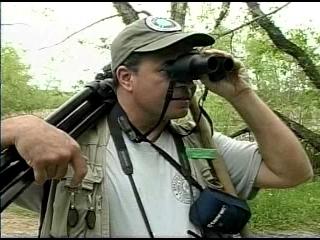
Welcome
to Brazos Bend State Park. That's me on the trail. One of the most
popular
reasons for people to visit BBSP is to see the birds. Although *I*
started
going to the
park mainly for the alligators, one cannot
be there for long
without learning to enjoy the birds. Over the years, I've captured a
few
pictures and video clips of them, and
over that time, I have gathered enough material on some species to give
them their own page. So...here are the Herons.
01/28/2024
Good news! We got some water at Brazos Bend State Park. We almost got
too much, since the Brazos River got close to flood stage at
the river gage at Rosharon (about 45 feet).
Big Creek rose enough to overflow into Hale Lake and fill that very
nicely (though I didn't go look, since it that area of the park
was
still flooded.) But that water didn't really go much further
into
the park. Instead, the direct rain that fell on Pilant Lake and Elm
Lake brought up the water levels there,
and along Pilant Slough. I observed that myself. So, here are
a few images from that wonderful sunny day.
It was cold (44.7°F)
up at the 40Acre Parking lot. Although it's usually colder down on the
trails, I was also hoping that the sunny day would warm things a bit.
Through
the past months, I've been stopping just East of the
Observation Tower and taking pictures across Pilant Lake. It looked
great today!

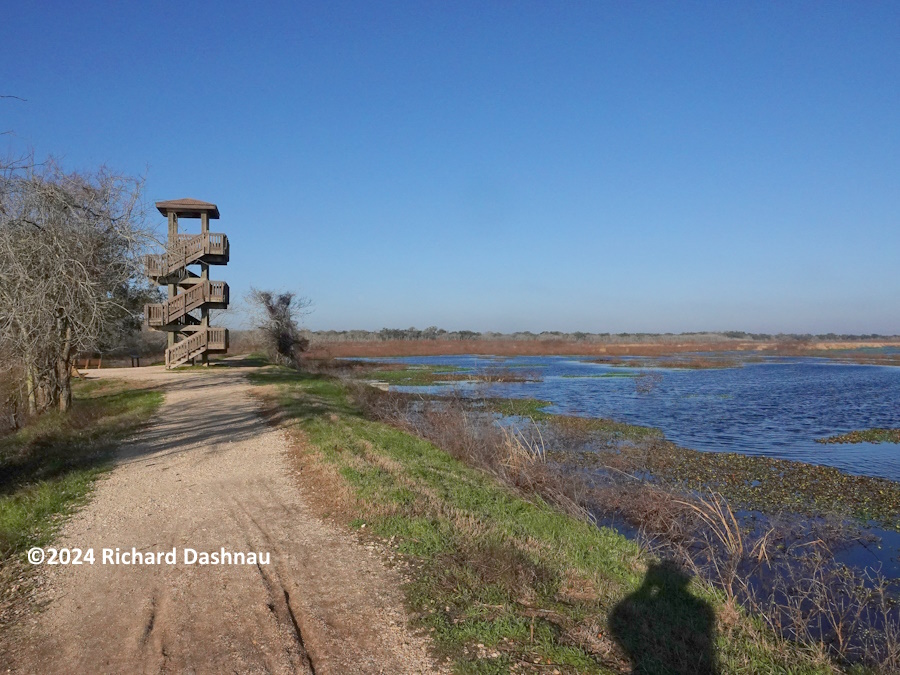

I
waited around the area, hoping for an Eagle. Despite the bright, clear
morning, and the various waterfowl moving about, I didn't see any. So I
moved to the Spillway Bridge.
Water was flowing over the spillway!
I think the last time we had water going over it was possibly Spring of
2022. I can't find any pictures later than that. Many wading birds
were hunting in the clear flowing water. There were mostly
Snowy Egrets, Egretta
thula (white plumage, with bright yellow feet)
and Little Blue Herons Egretta caerulea;
but
other birds were also around.
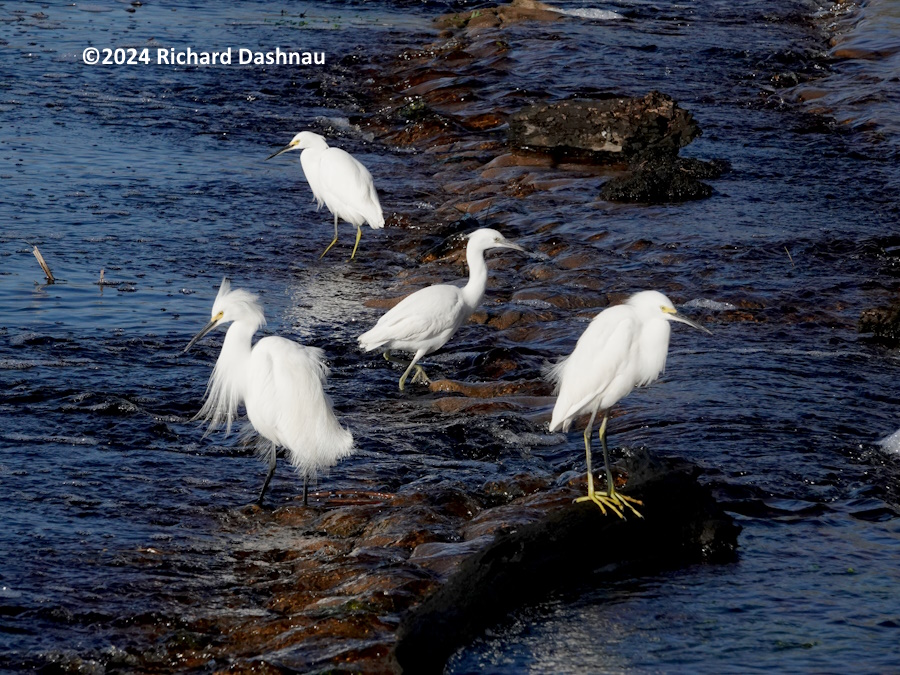

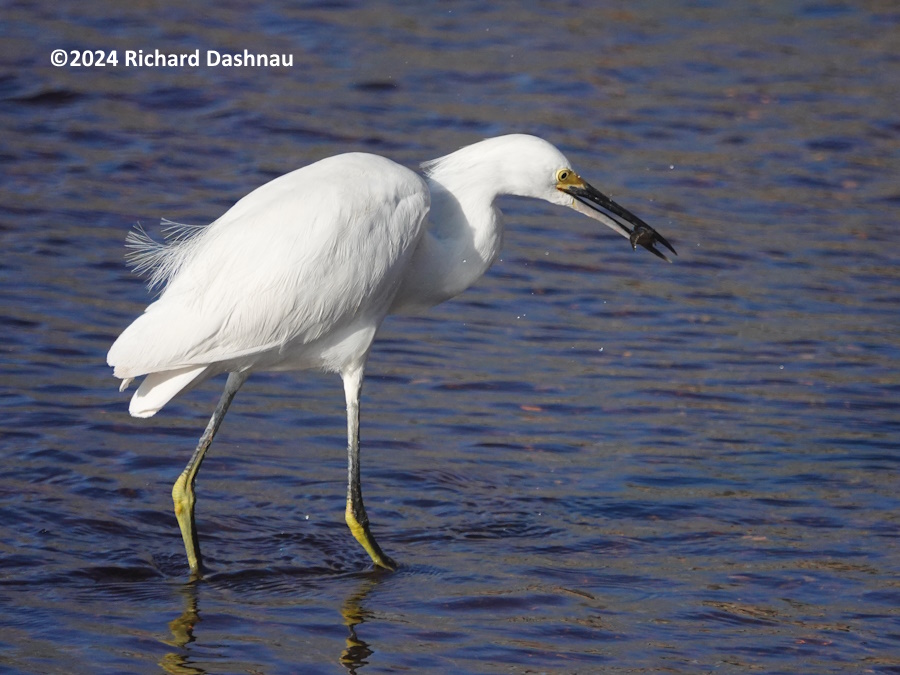
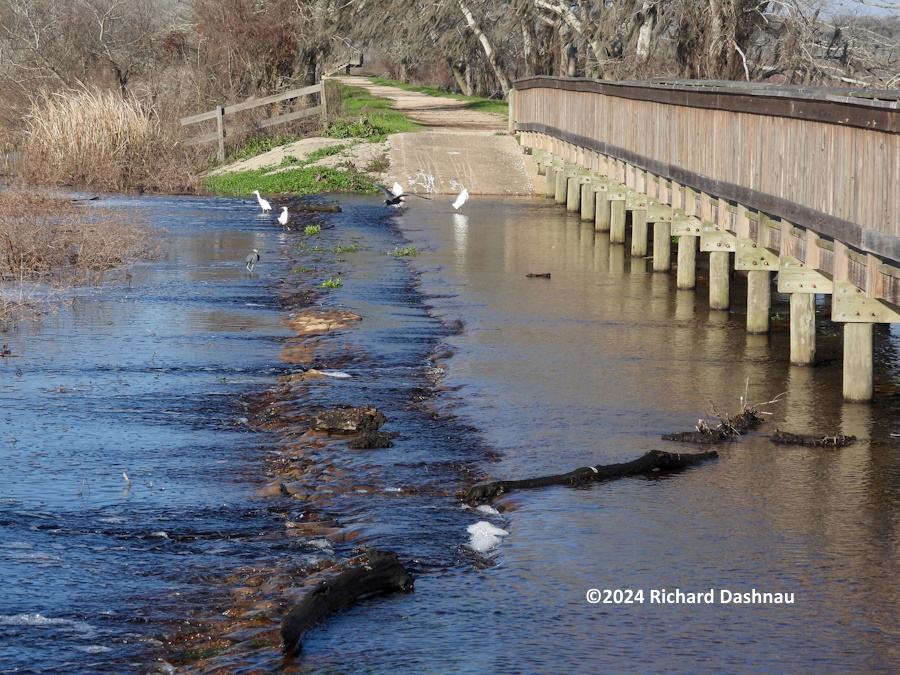
The
birds were a bit skittish, and would scatter whenever someone walked
over the bridge. So I couldn't get close enough to see what most of
them were catching. I can
tell that one of them (the Snowy above),
caught a small crawfish. At least twice a, one of the Little Blue
Herons
capture a Lesser Siren (siren
intermedia)! But in all cases I
could
see, the Siren got away. The Sirens were not full grown, but
the
Little Blue Herons had problems with them anyway. Much later, I
realized that I might have been able
to watch from the bridge to see
live Sirens swimming by (I have never seen one moving in the wild), but
I didn't think of it then.
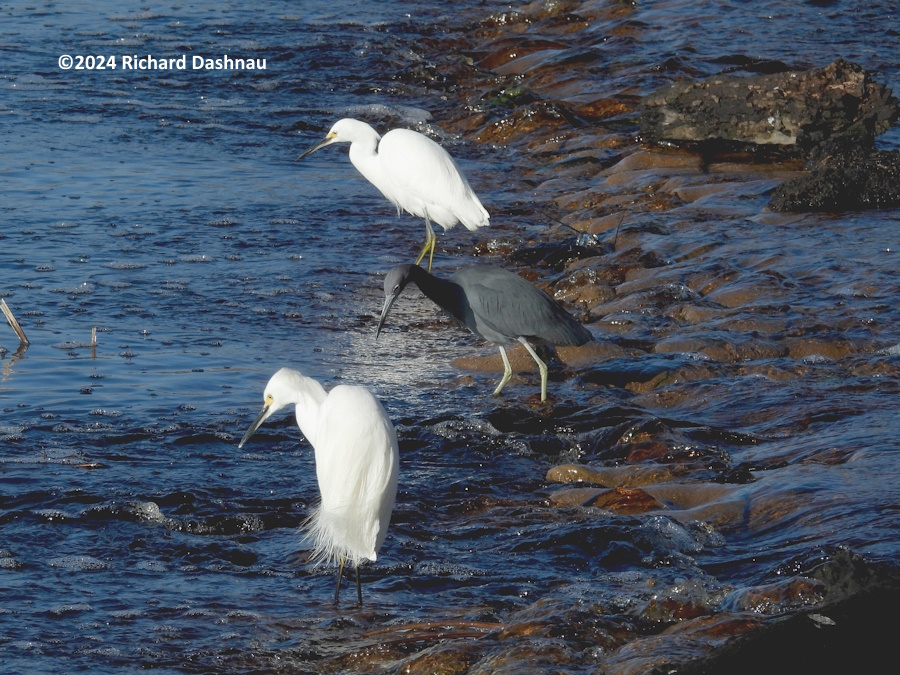

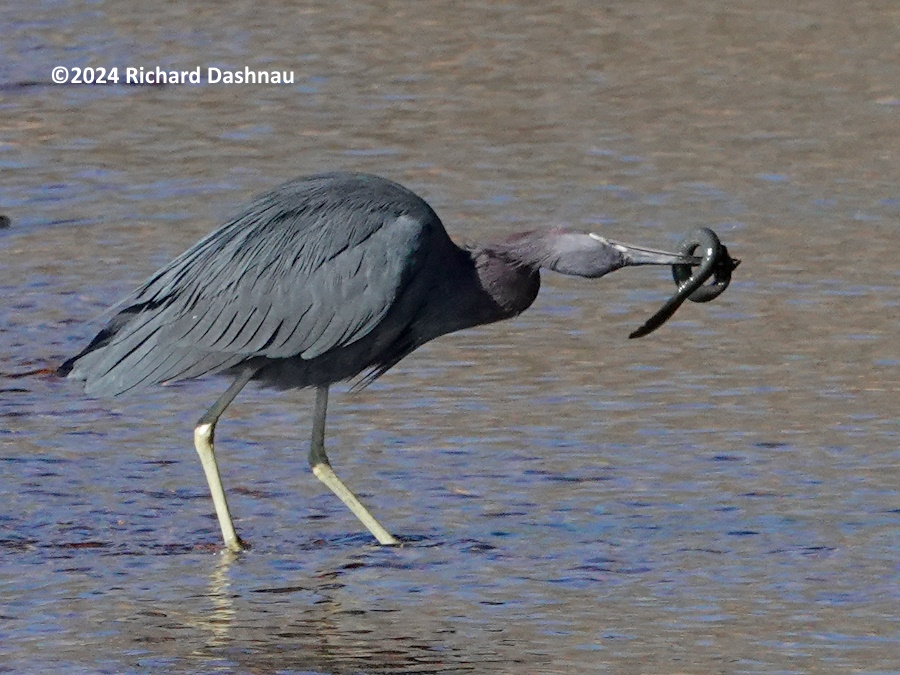
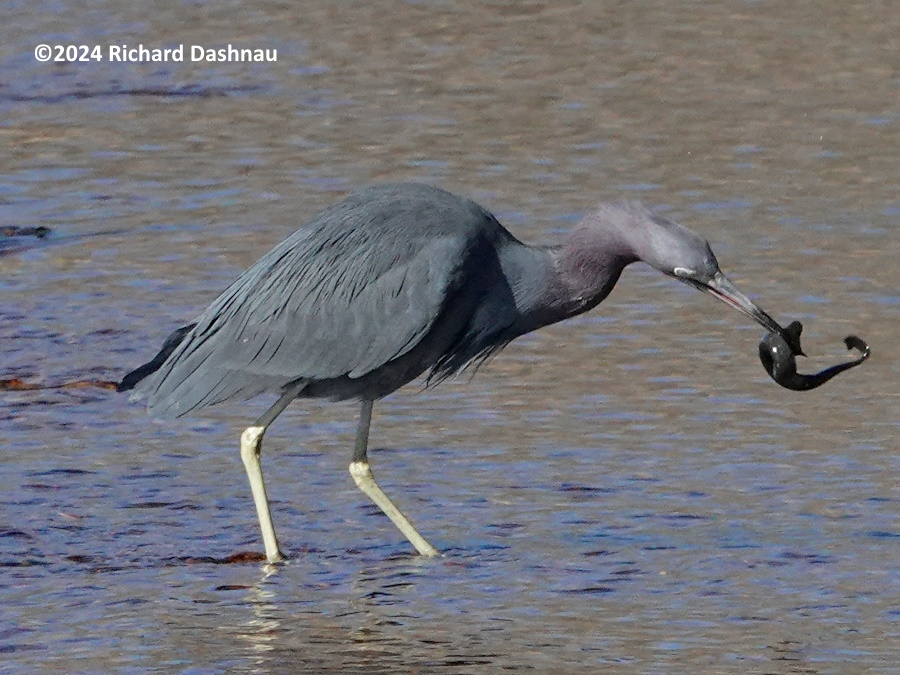
On 08/06/2023, at Brazos Bend State
Park I climbed the 40 Acre Lake Observation Tower to get a few images
to show the
condition
of 40-Acre Lake and Pilant Lake. Pilant Lake looks better than it did
this time last year, while 40-Acre Lake also looks better than
last year--but not by much. The first picture shows the barrier that
marks the closed part of 40-Acre Lake Trail. The nest is not
visible in the wide
shot, but it was just around the bend.
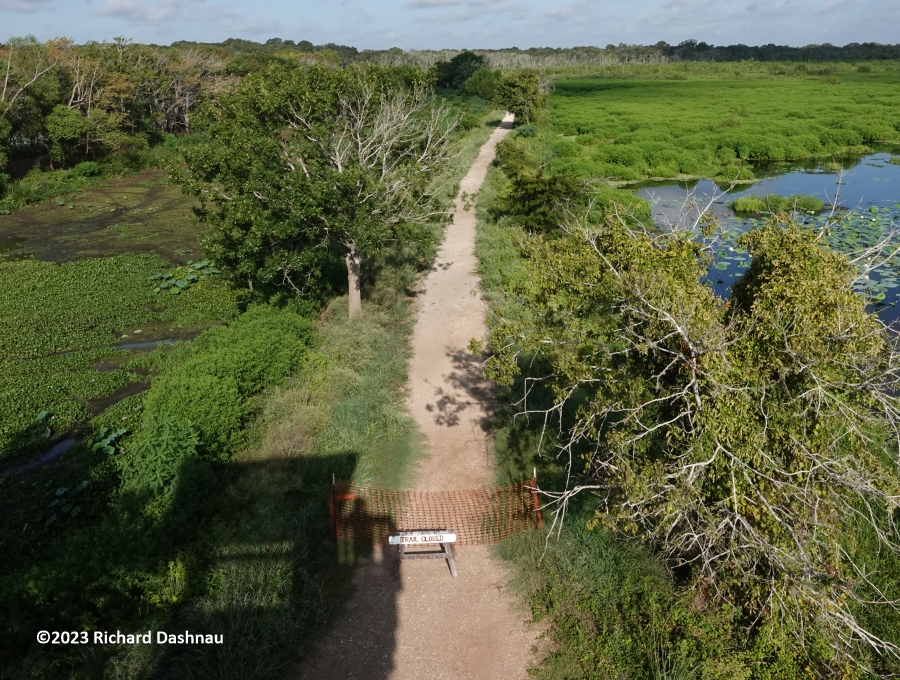

A Green Heron
(Butorides virescens) was foraging on the
North side of the Spillway trail. Some folks are surprised
when I show
them a Green Heron, because
most herons walk with their long necks
extended. Green Herons keep their heads tucked close to their body, and
with the feather covering, it's a real surprise when they
extend
their neck to catch something. The Heron hopped onto a fallen
tree, and I moved on because I thought it was moving to the next clear
water to hunt. But
while it
was still on the tree, the Heron focused on something. I
stopped to watch, because I wondered what it saw, and how it would
catch something when it was so far above
the water. I'd figured that whatever prey it would catch would be in
the water. I was wrong.
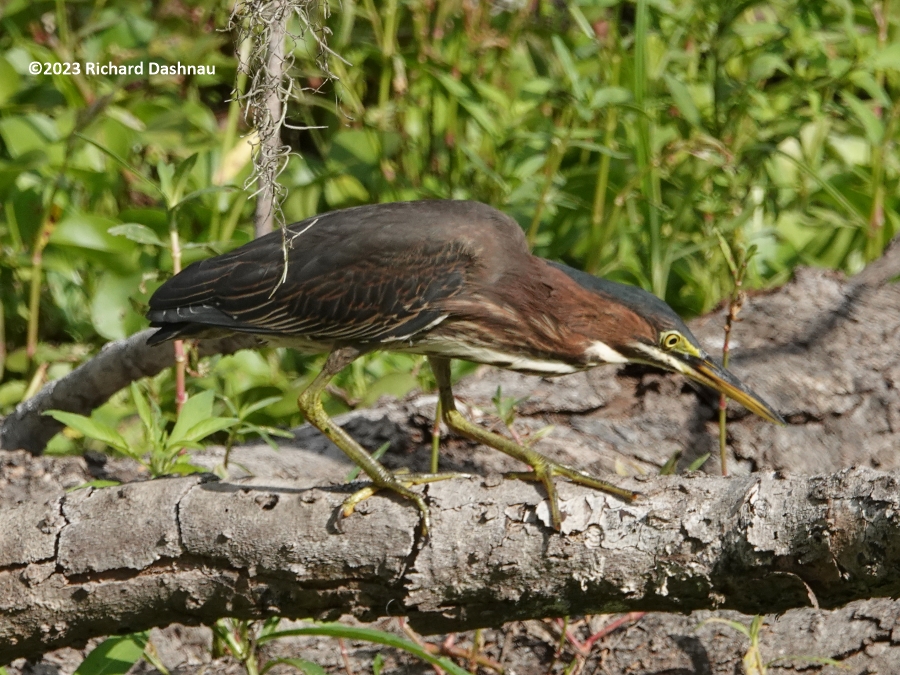
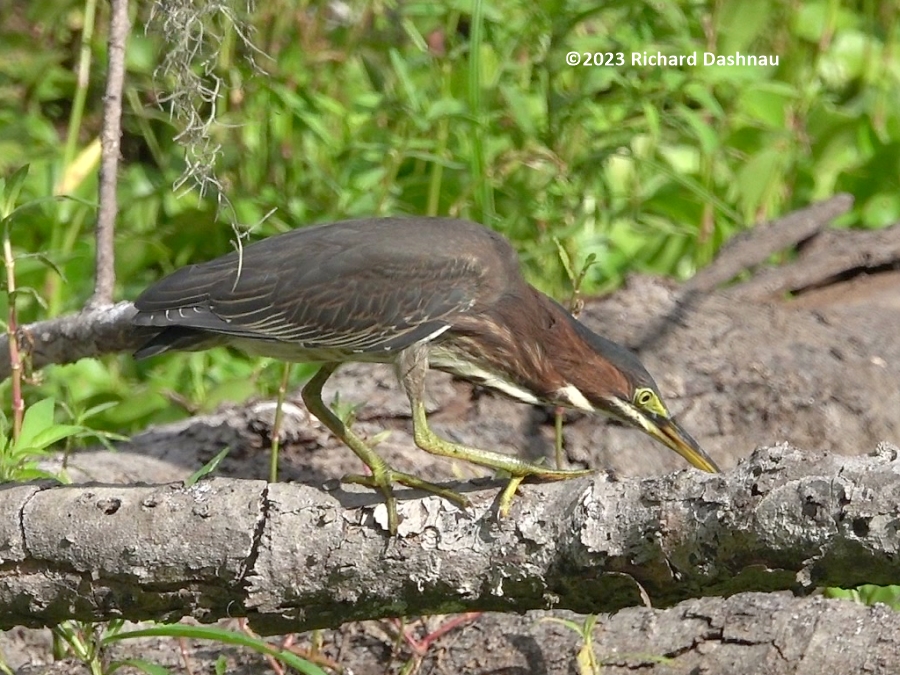
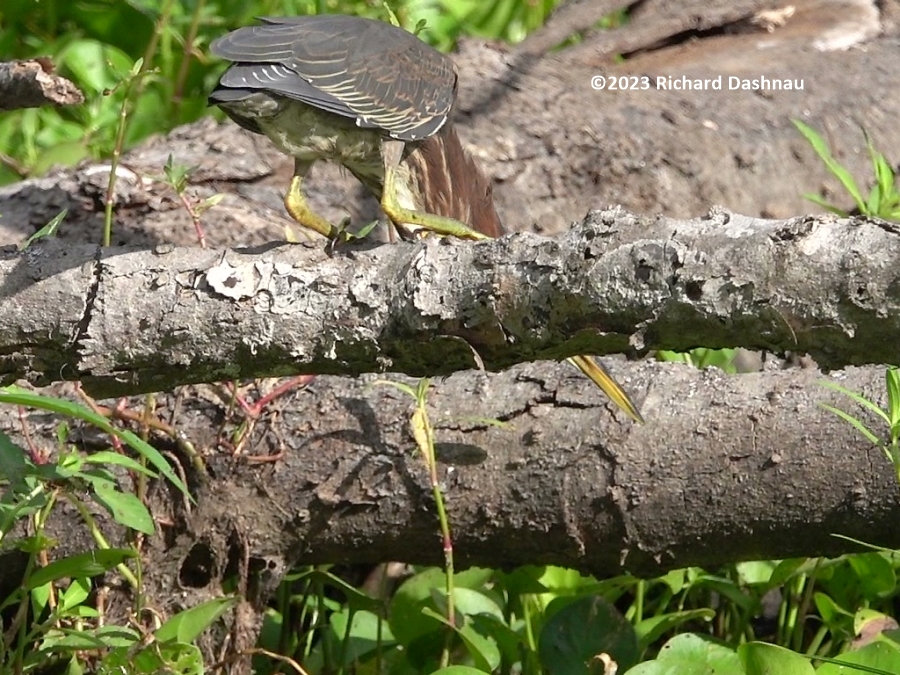
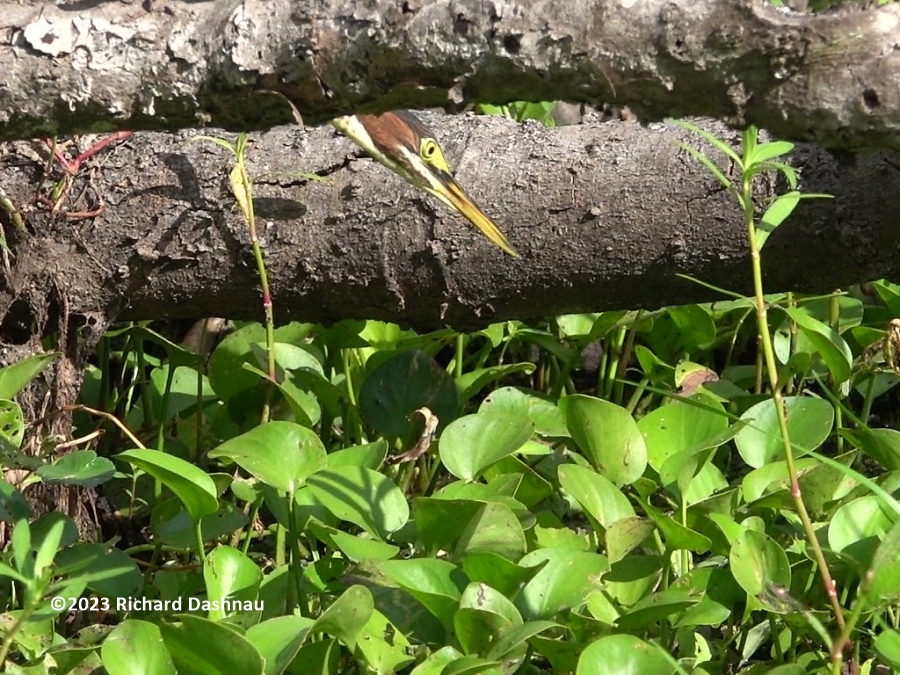
I
was filming video, and didn't want to stop to secure the camera;
because the hunt was on! We can see how the Heron maintained
it's
balance even as it stretched its
neck down...and further down.
While the Heron extended its neck, it maintained an "S" curve
in
the center to allow slack for the final thrust and grab.
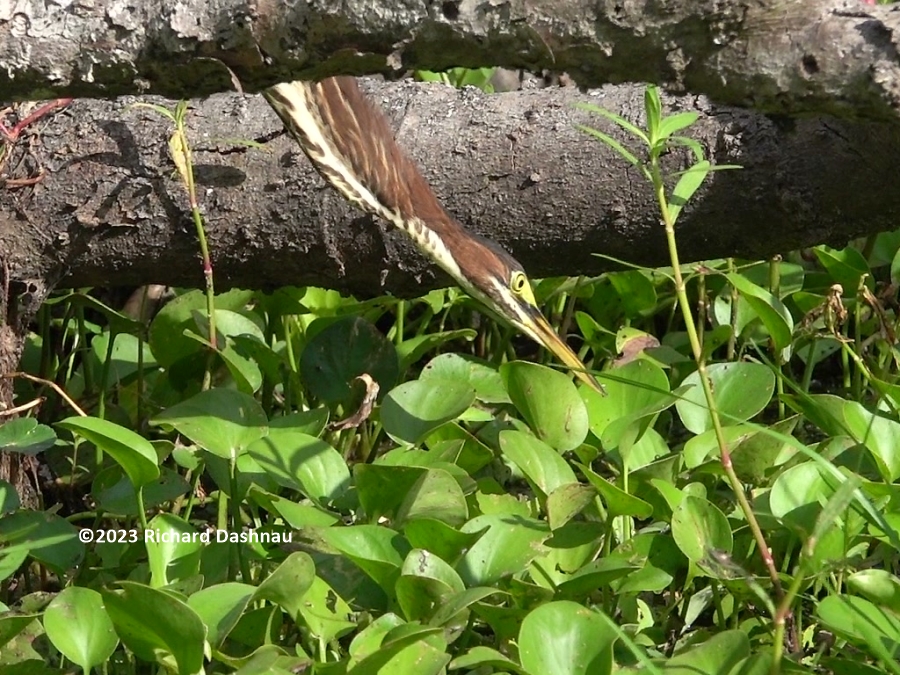
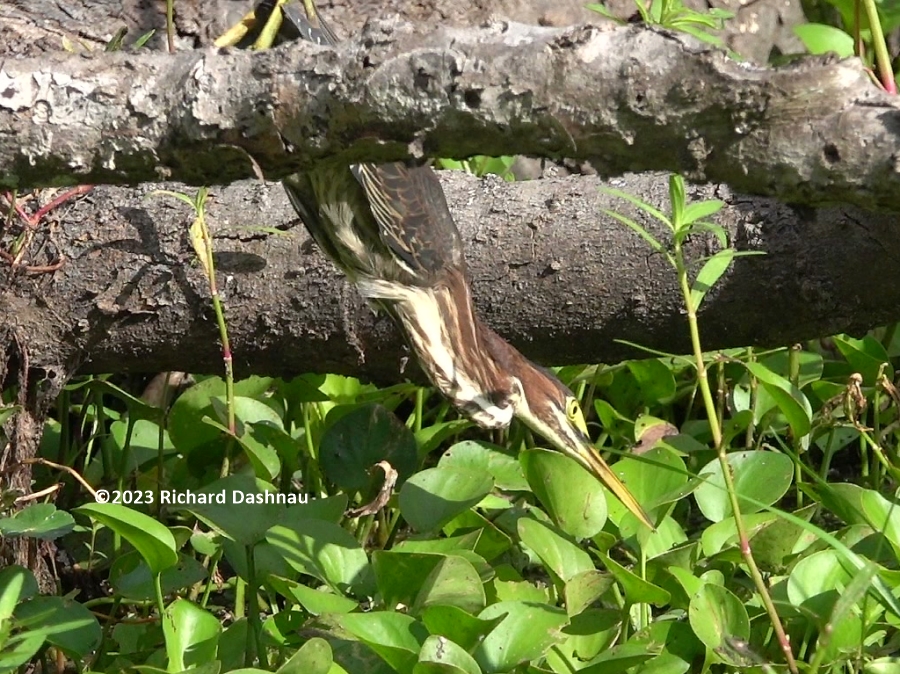
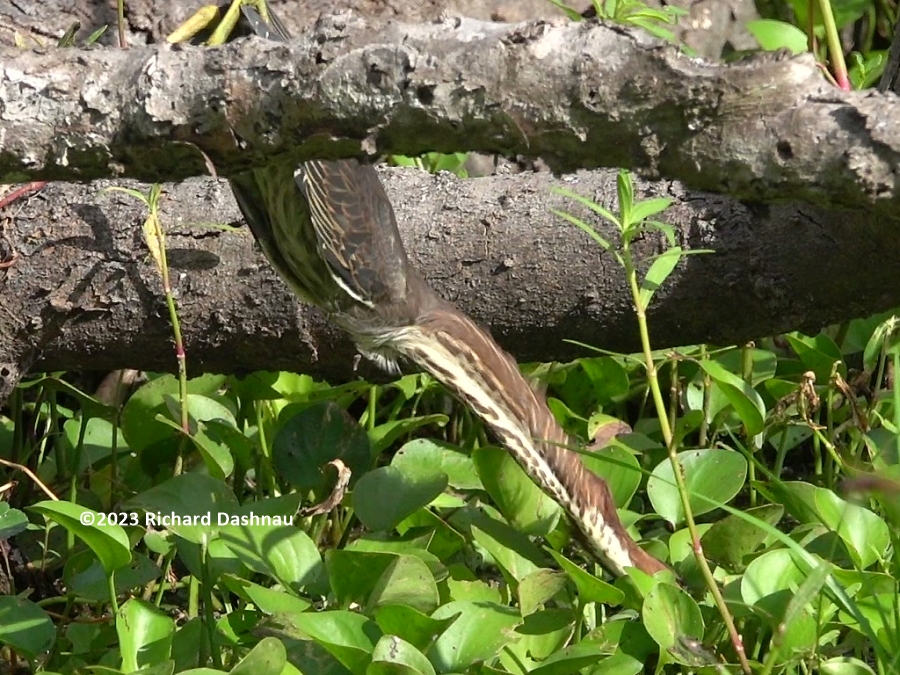
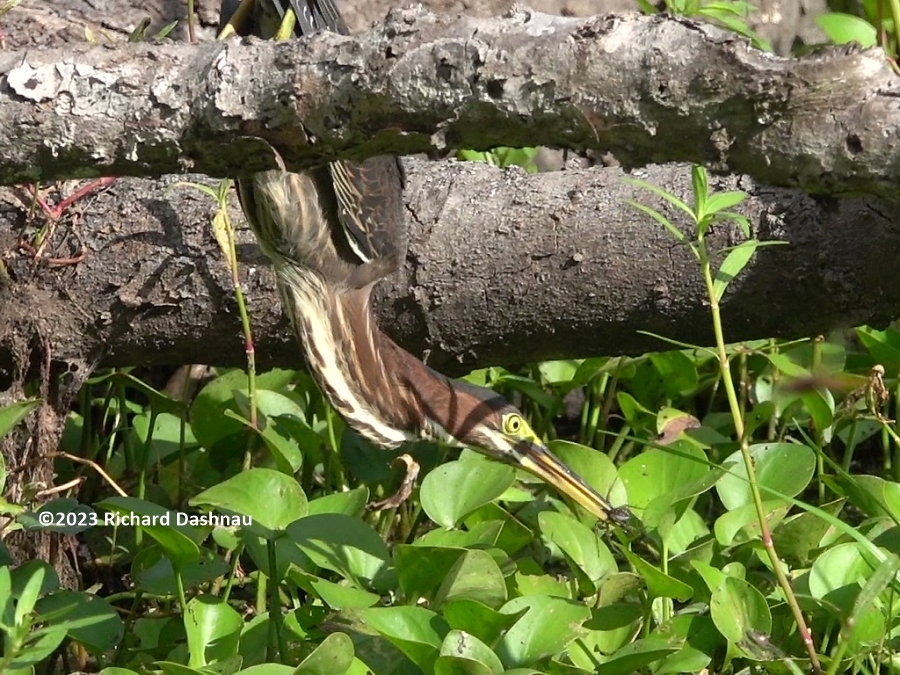
As I recorded the
capture, I thought the Heron might have caught a dragonfly,
since the prey seemed to be a large arthropod of some kind. But after
reviewing the footage,
I could see that the Green Heron had caught a
spider. Even at this distance, from the markings, I can tell that it
was a Six-Spotted Fishing Spider(Dolomedes triton).
Another surprise
from Brazos Bend State Park! Follow this link
to see the video. And to see other Green Herons
working, look at the rest of this page.
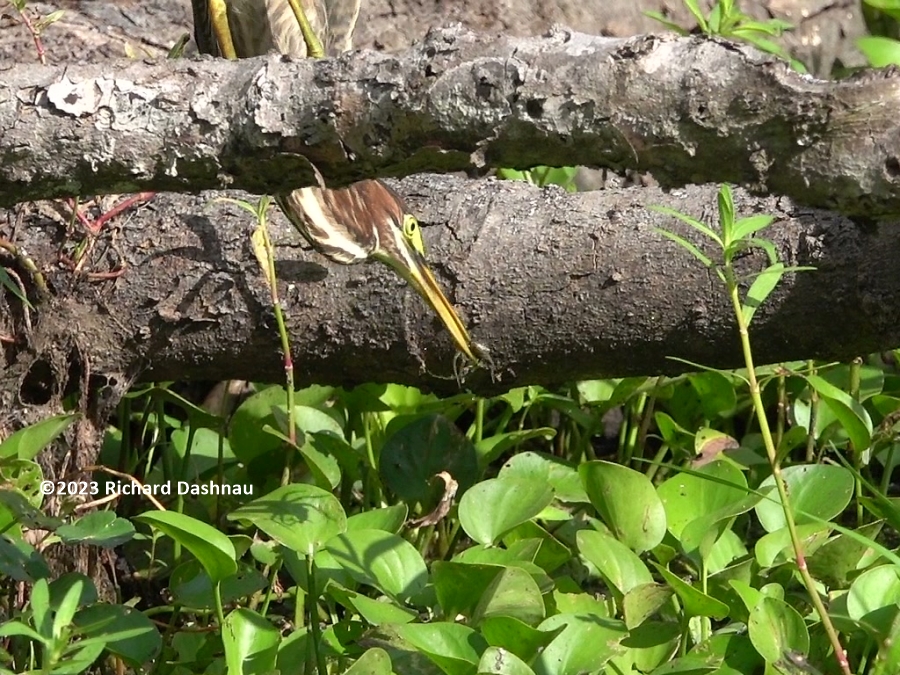
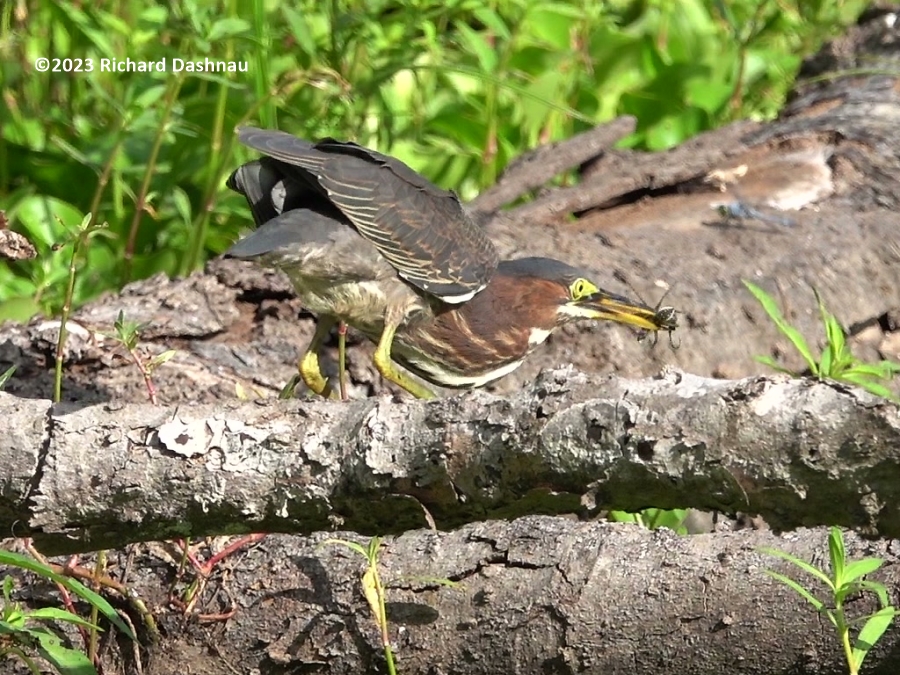
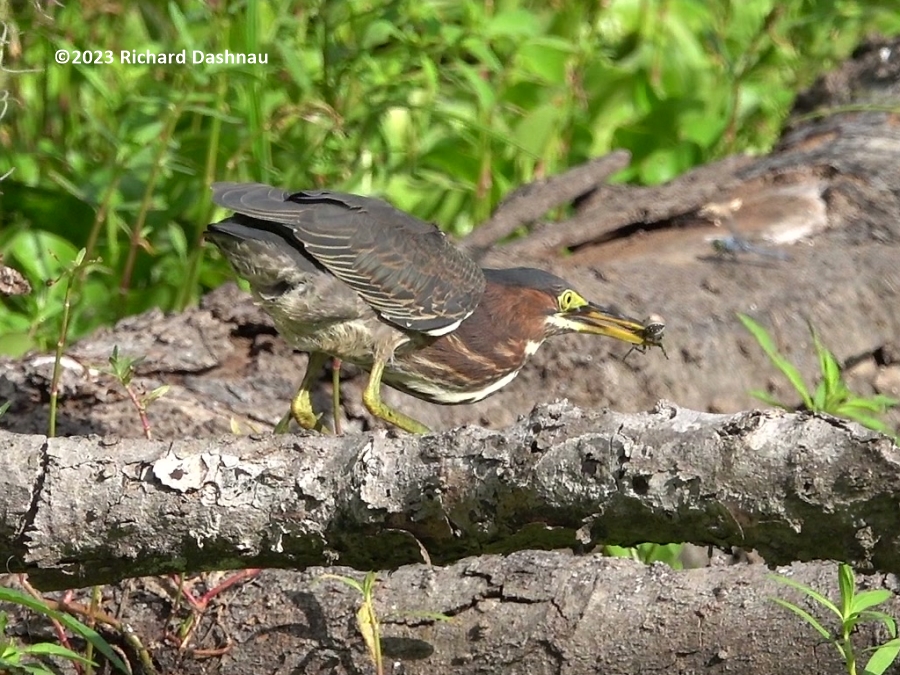
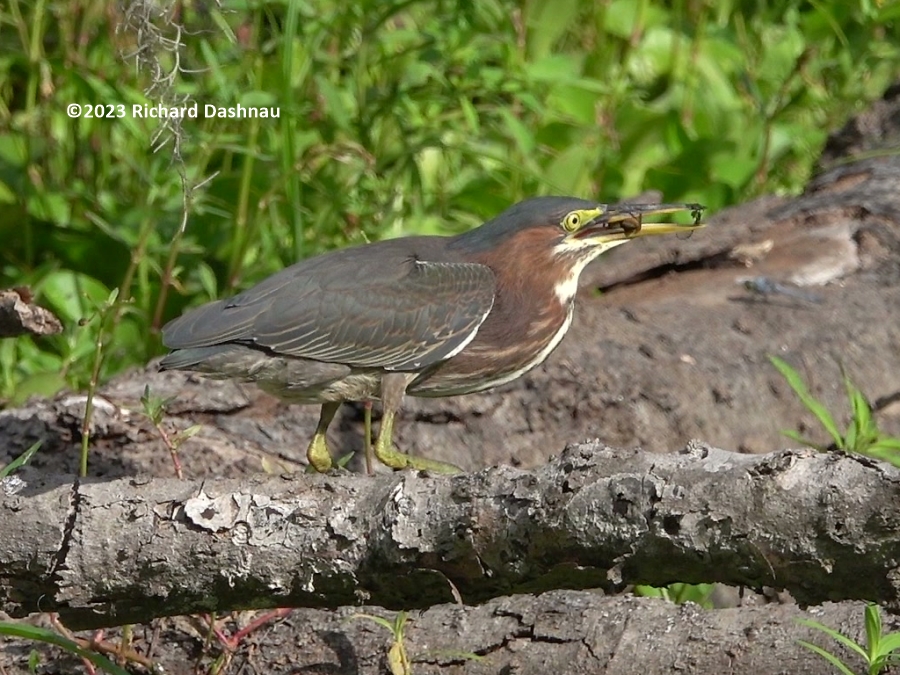
I
walked the trail with some park visitors from California. As
we
walked, I interpreted for them; and described how we were sort-of
recovering from the bad drought of last
summer. I've been
doing this a lot, because the lakes are obviously low, and the
alligators are not appearing as often as they used to; and for other
reasons.
So, as we walked West on the Spillway Trail, I asked them if they like
the park.
They said it was wonderful, and then they said "Everything looks so
GREEN!" And, they were right. It did
look green, and that was great.
There
I was, sort-of apologizing for the appearance of the park, and these
people were really happy with what they saw. So I said, "You're right!
The park is awesome, and
when the water is where it's supposed to
be--the park is even...awesome-er!" I got a laugh out of that. But this
reminded me that even when we are dealing with conditions
at the park that are not favorable, there are visitors who
really, really
appreciate being there. And I'm happy to share that.
On 06/04/2023
I was at Brazos Bend State Park watching Green Herons in Elm Lake again
. One of them was using an insect for bait. The 8 pictures
below (from video frames) show how it carefully handles the insect as
it picked it up and placed it. The 4 below show it picking up
the bait.
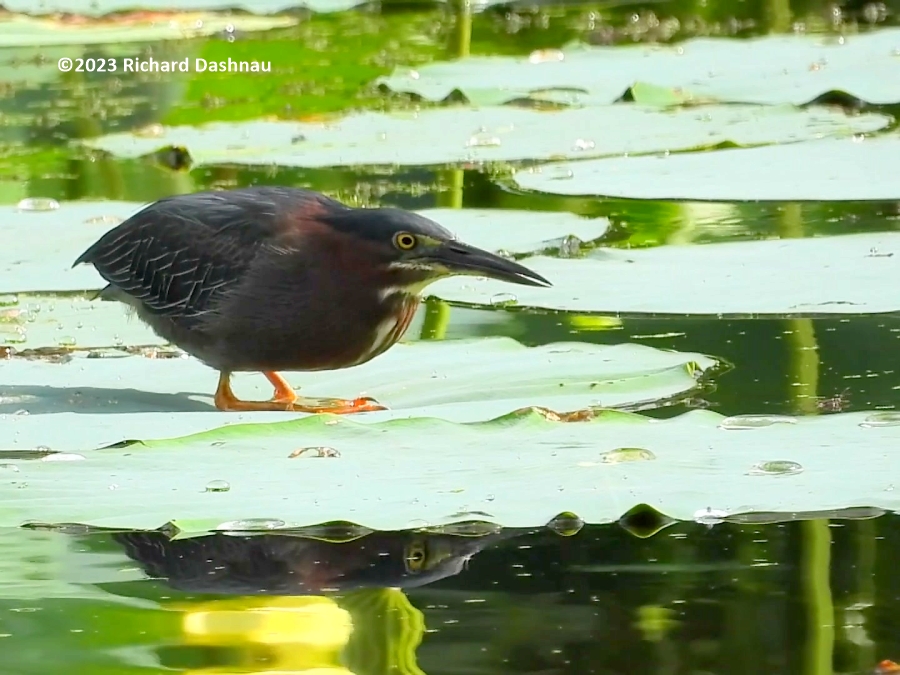
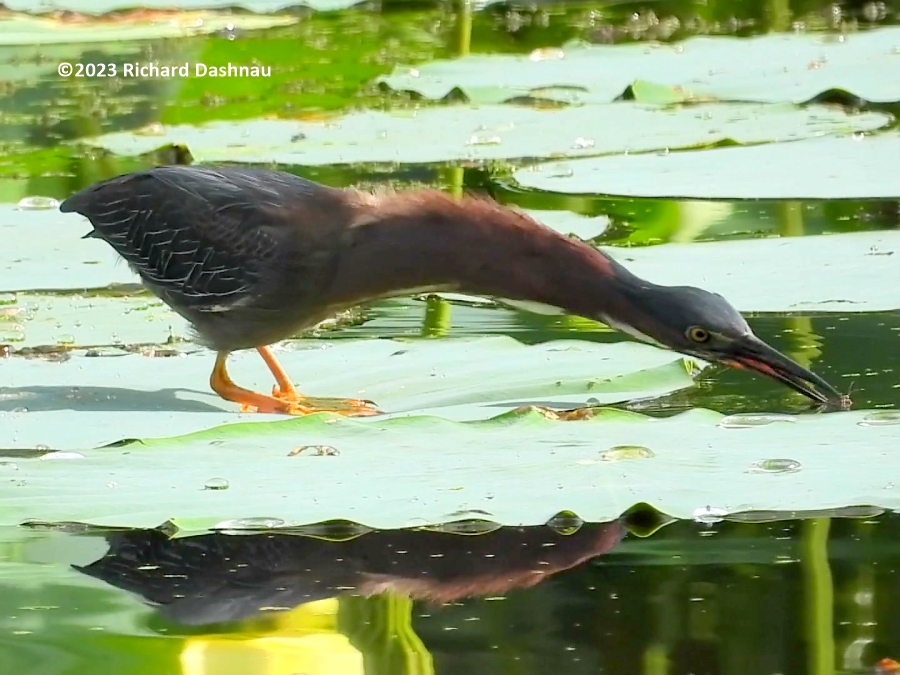
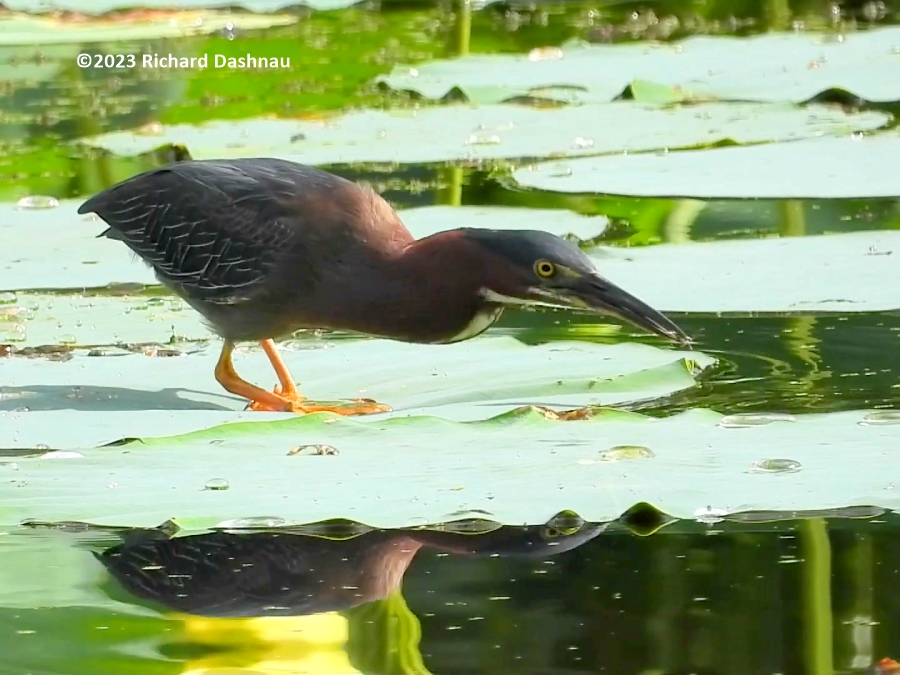
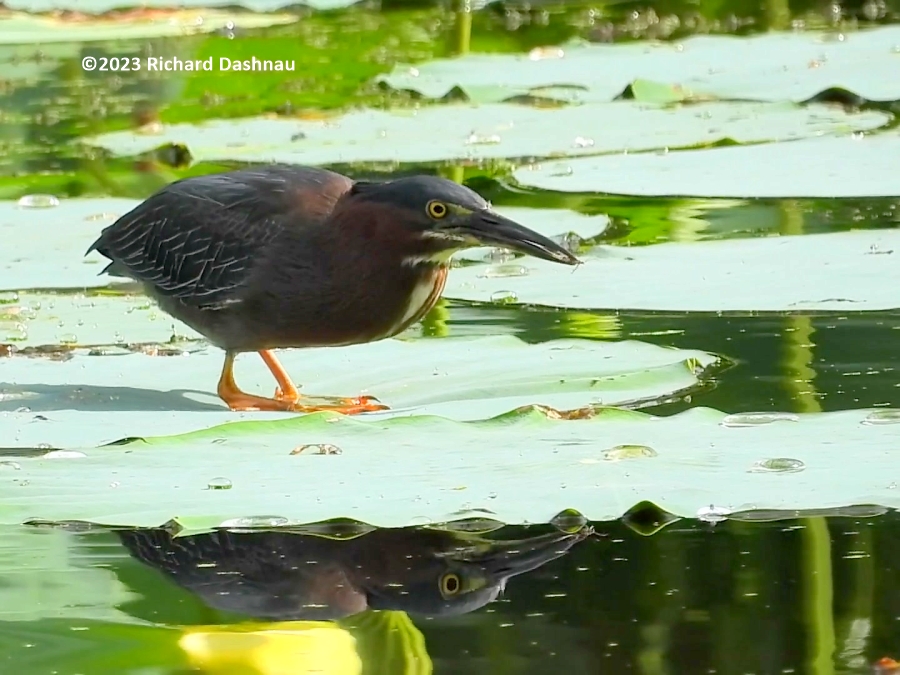
The four images
below show it placing the bait.
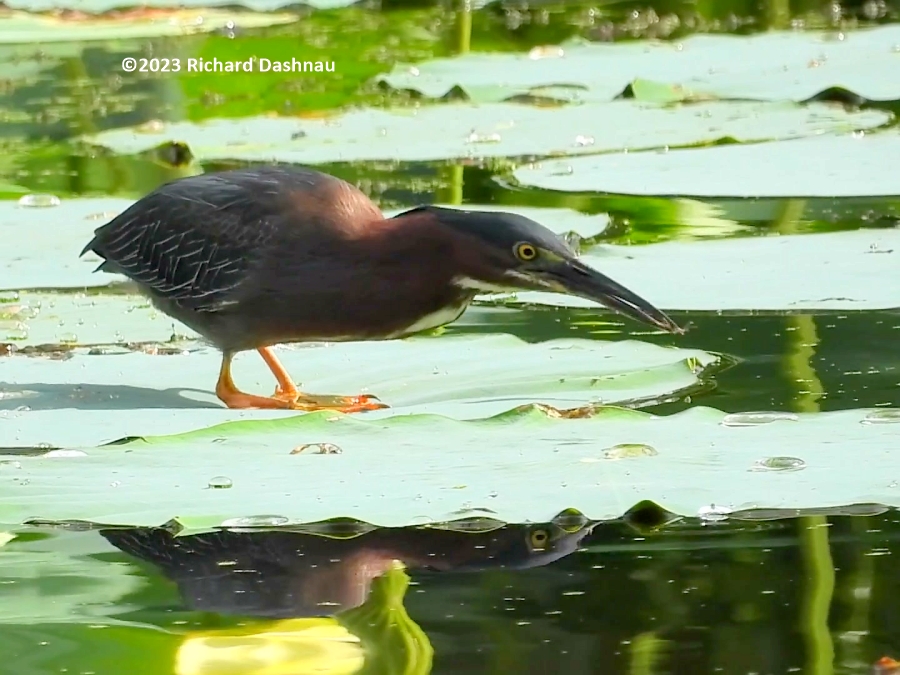
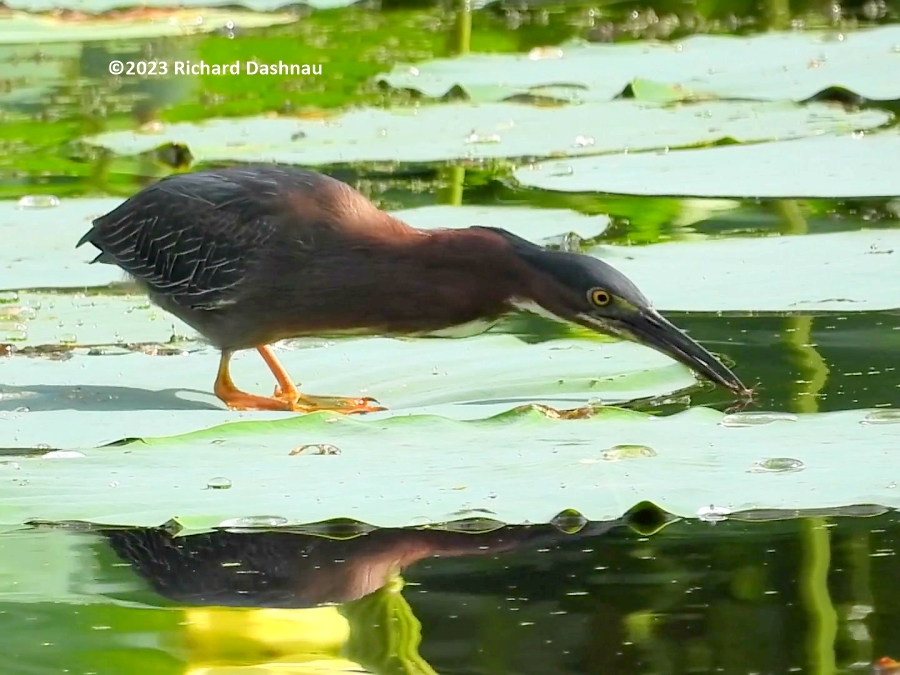
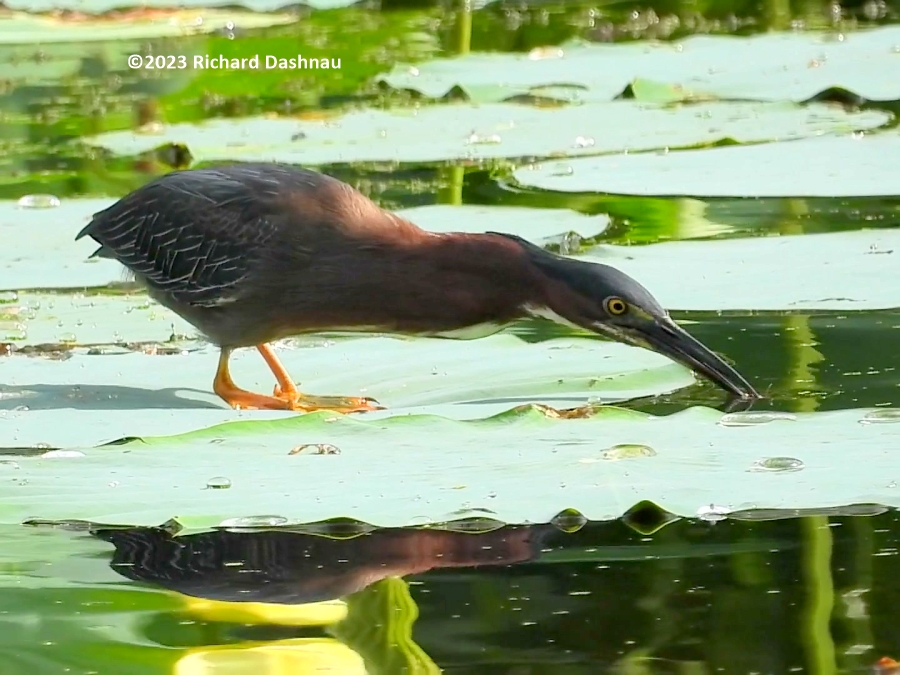
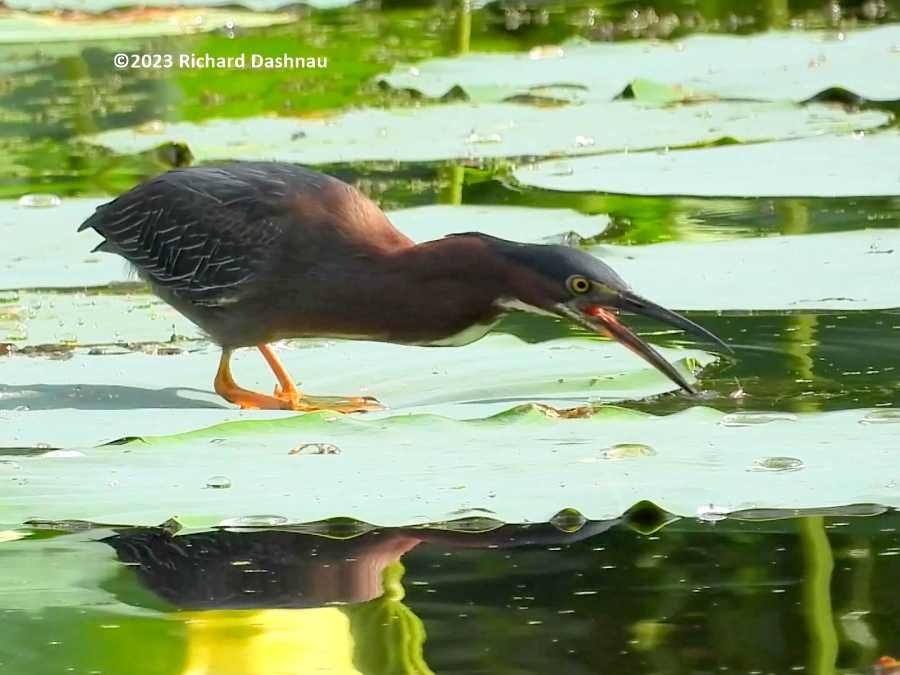
The last time, the bait was put down where it eventually
drifted so I couldn't see it. But the Heron could see the bait.
A fish also saw the bait, and went for it...unfortunately
for the fish. The Heron caught a large Sunfish!
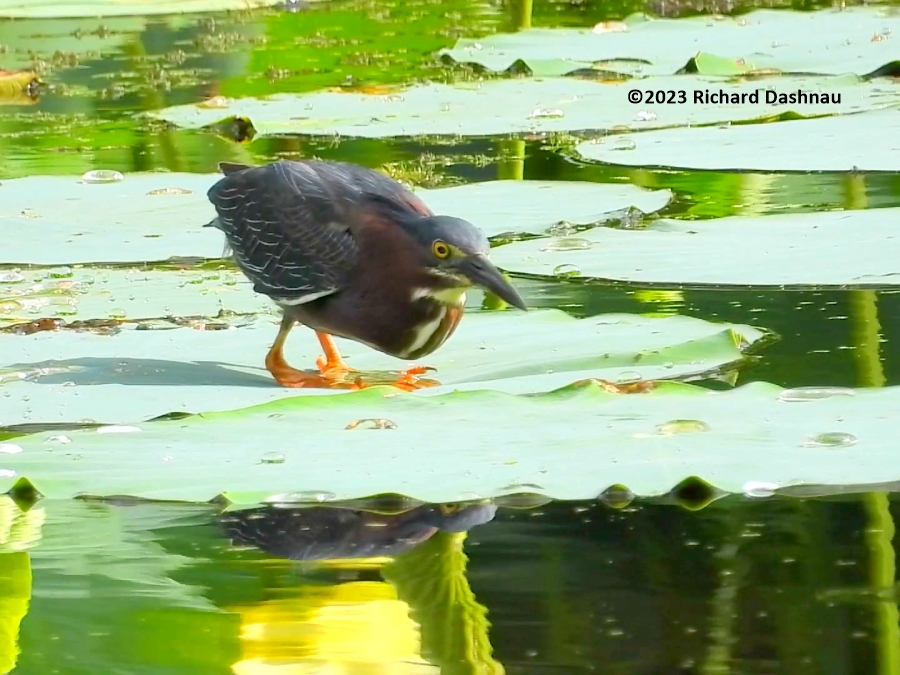
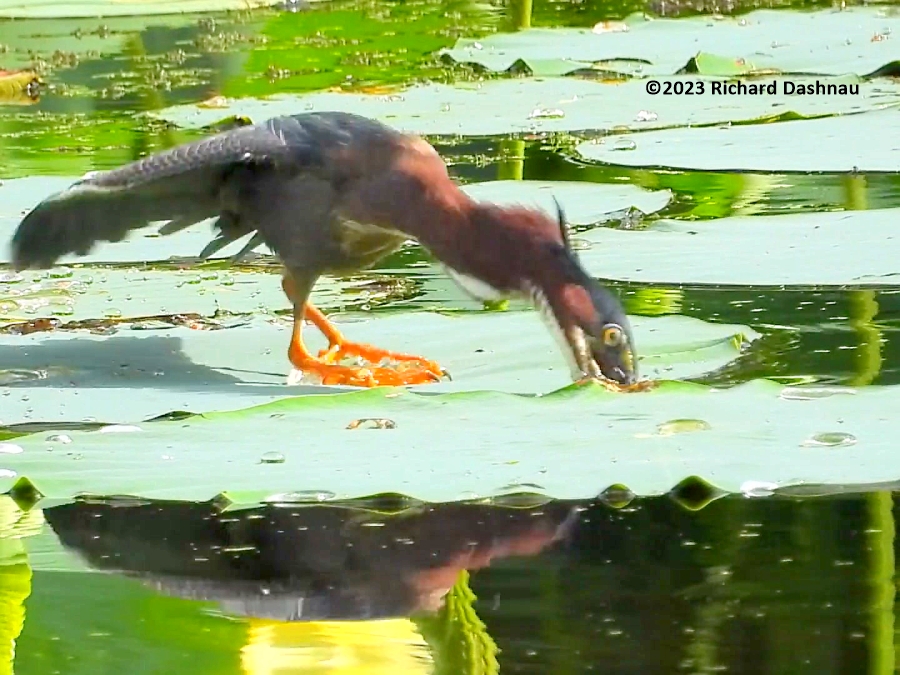
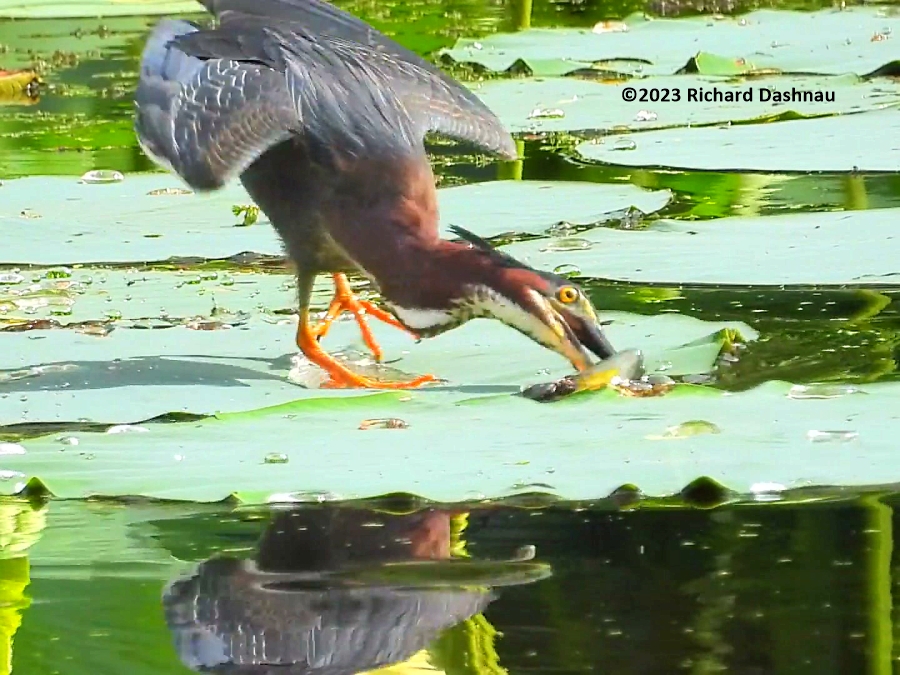
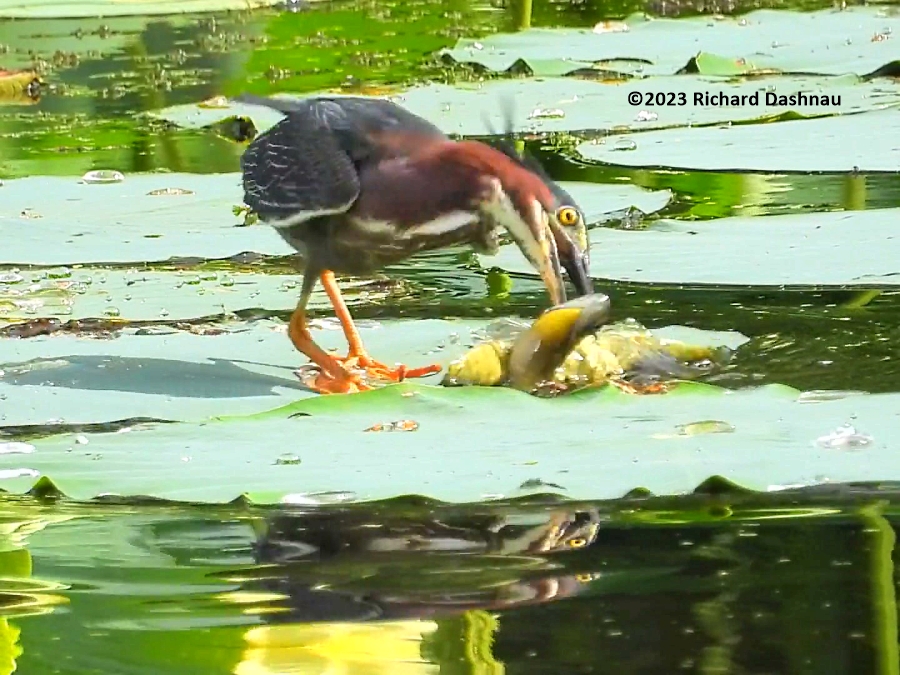
This Heron (unlike others
that I've seen) was standing on a
large leaf which was a stable platform. The Heron walked
away, slipped the fish off its beak and grabbed it. I
was distracted while describing the activity for some park visitors, so
I didn't get to see the Heron eat. The edited video
of the successful Heron is here.
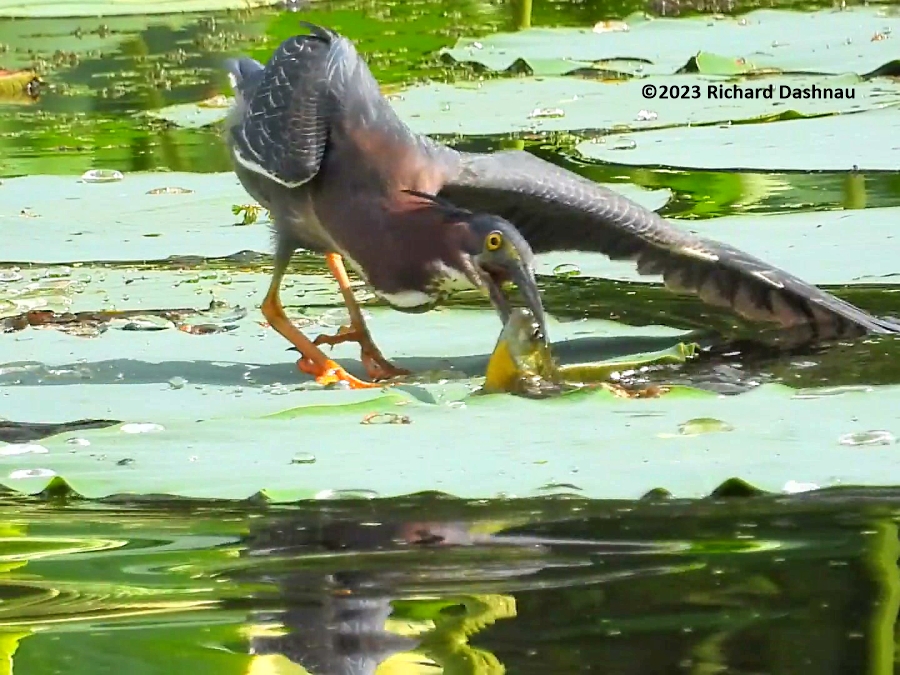
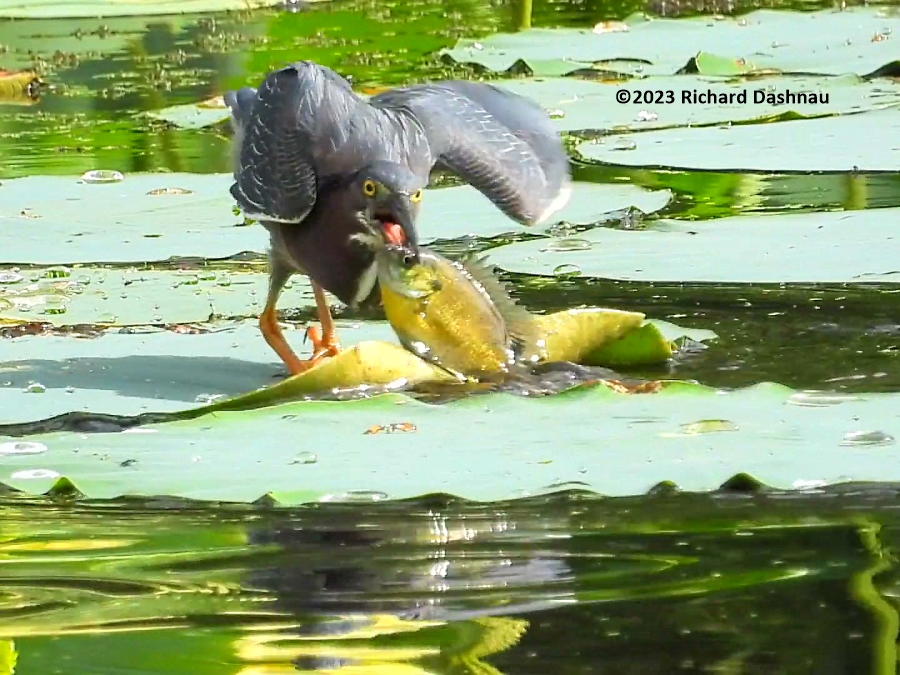
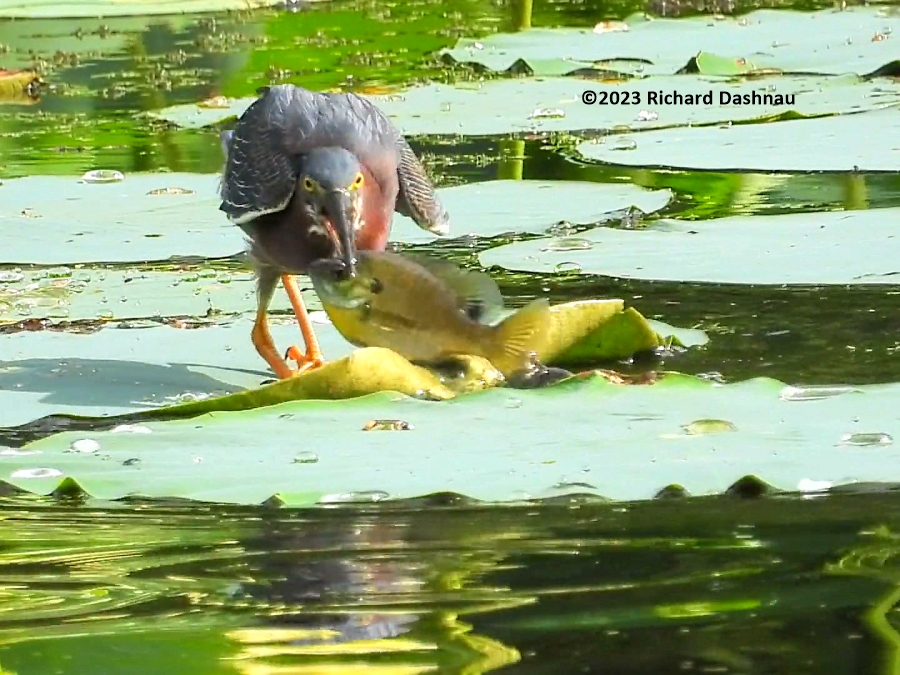
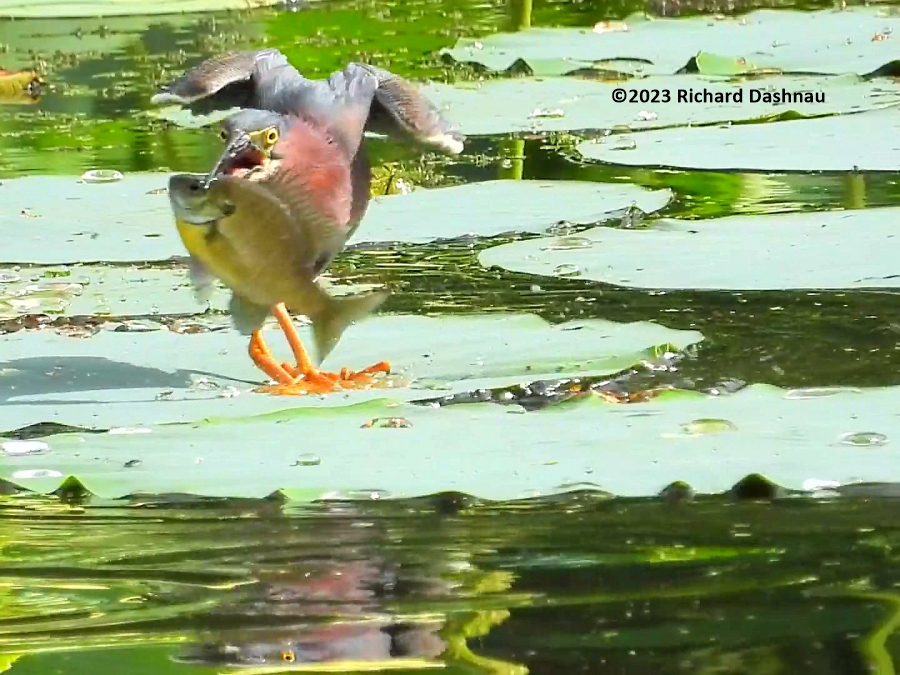
04/30/2023 at BBSP.
These are 3 different Herons that were hunting in Elm Lake that
day. I've seen these small Herons make some amazing catches
in
the past.
But this day was not a good one for them. This
Heron was poised at least 12 inches above the water. We can see how
long its neck is when it stabbed for prey.
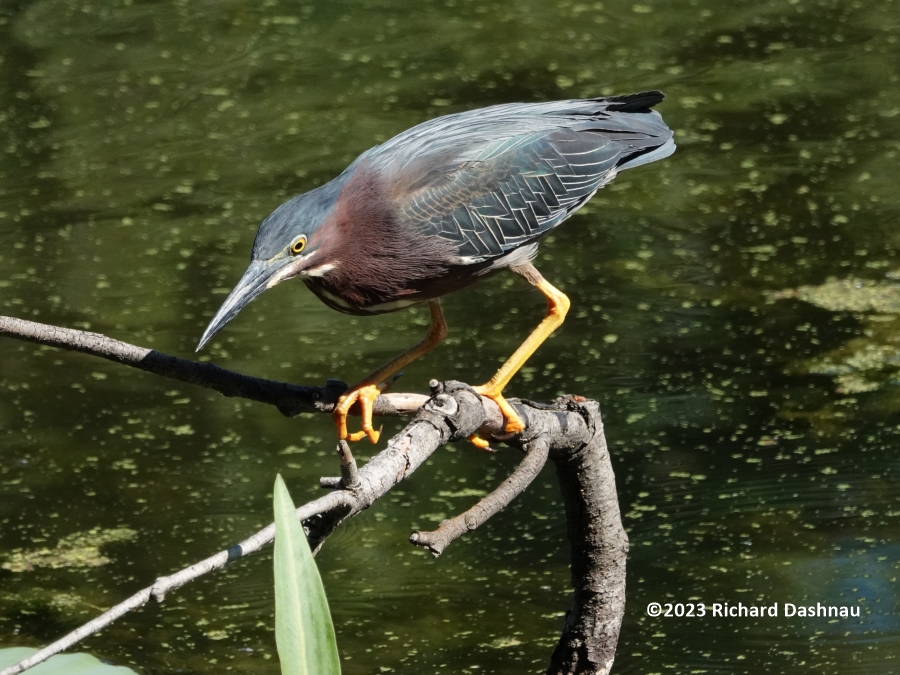
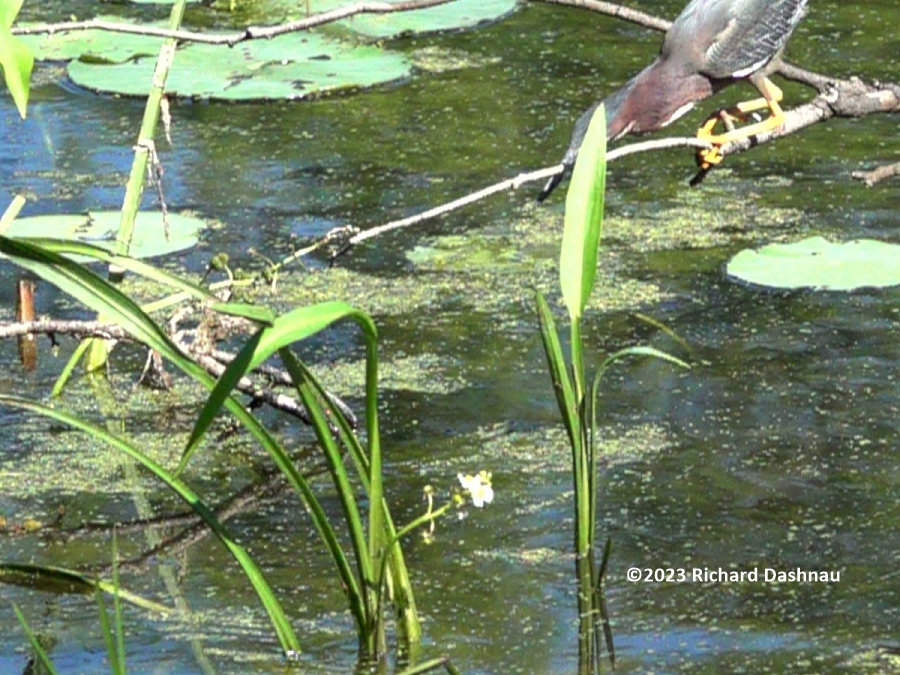
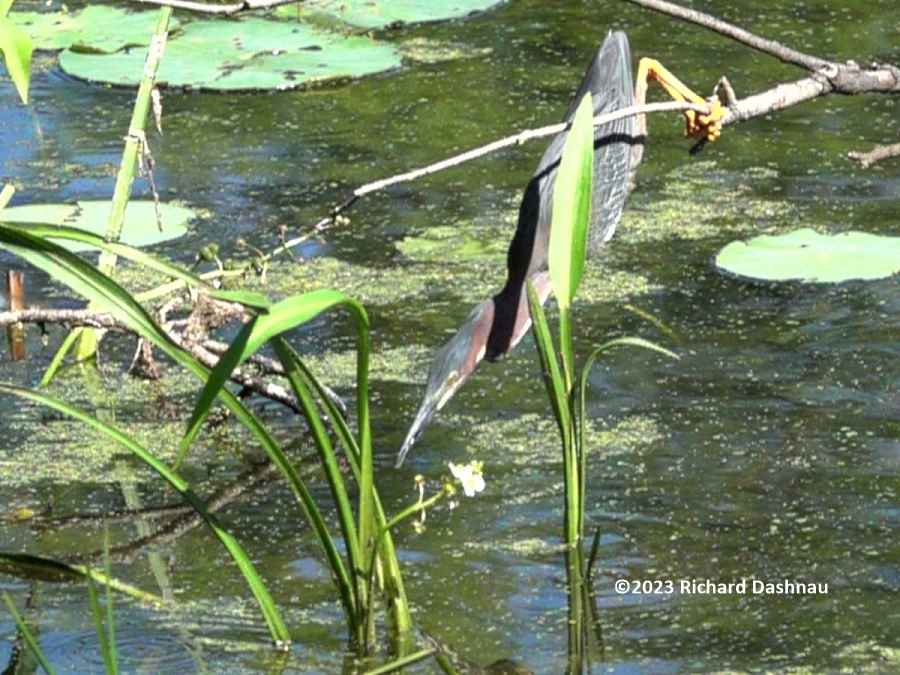
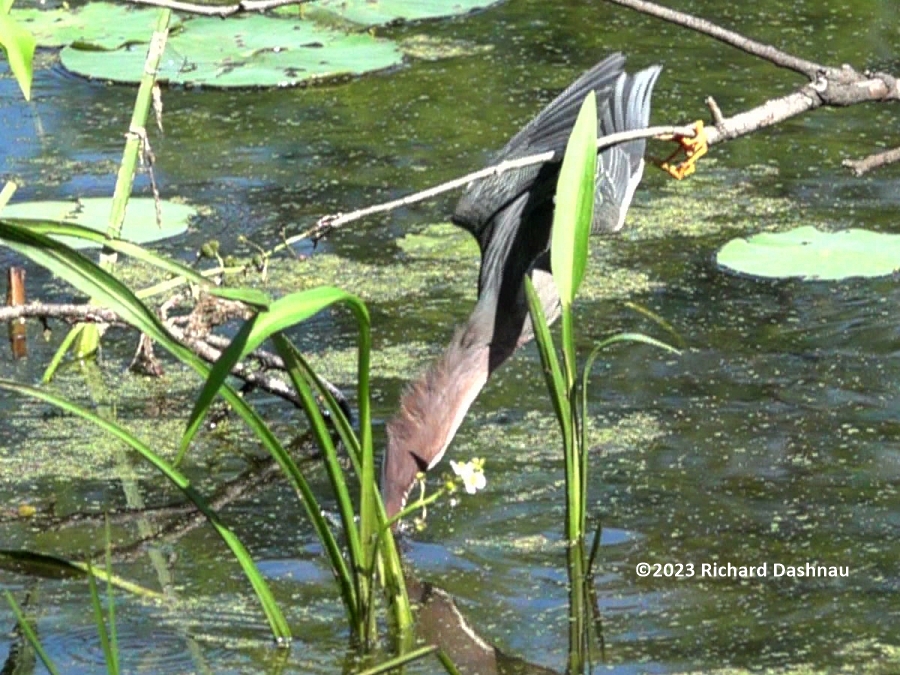
The Heron
was
fully-committed to this thrust, but "ran out of Heron" before
hitting a fish. It had to leave the branch and go in. It
missed!
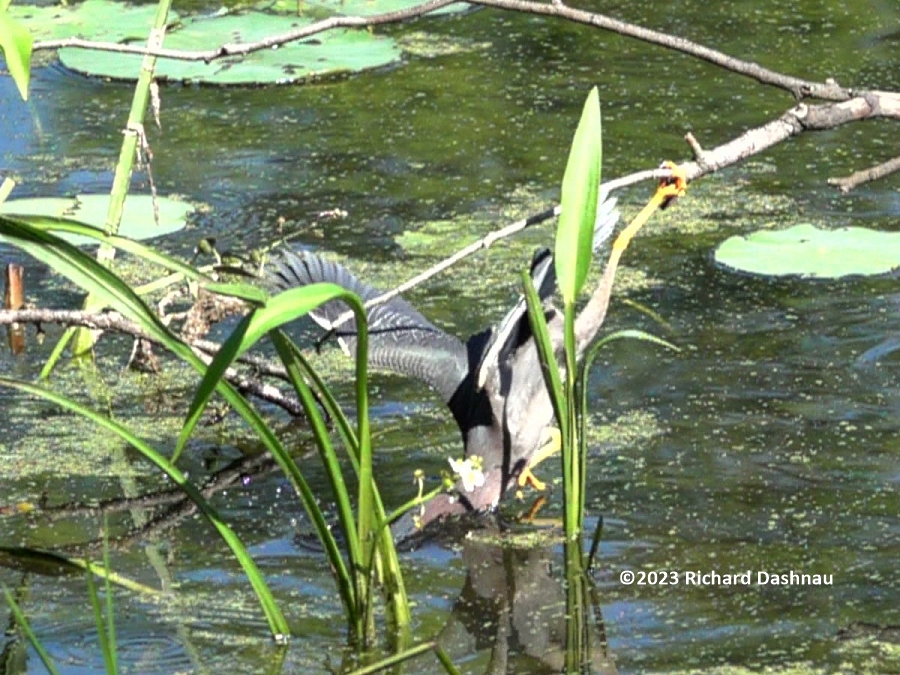
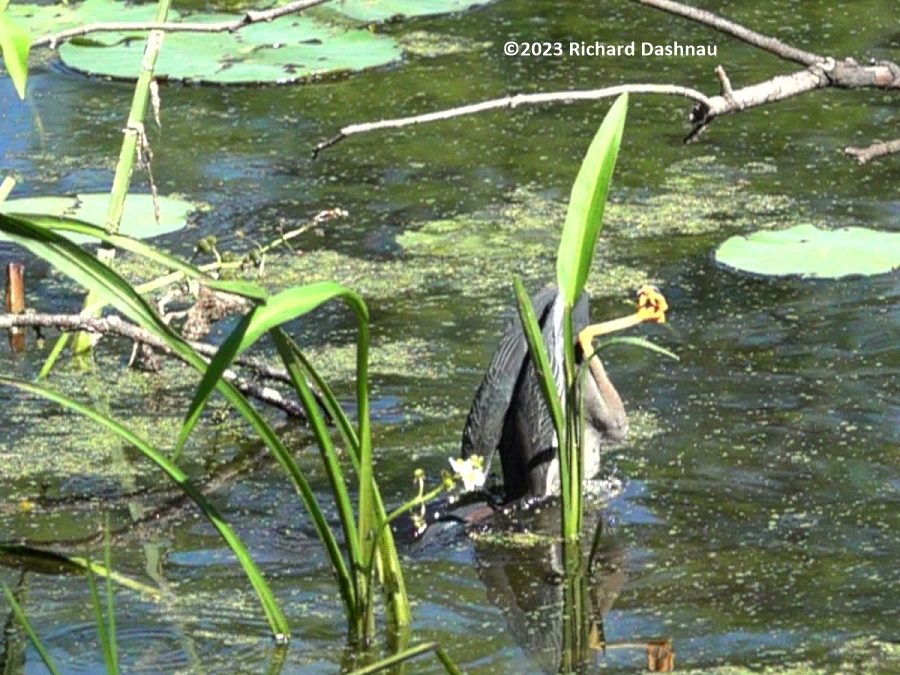
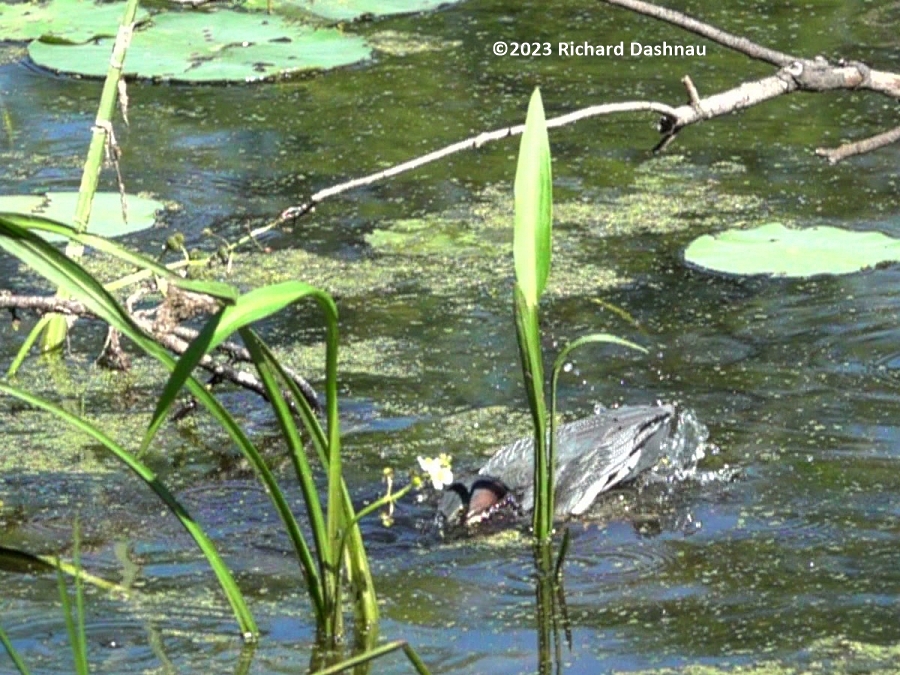
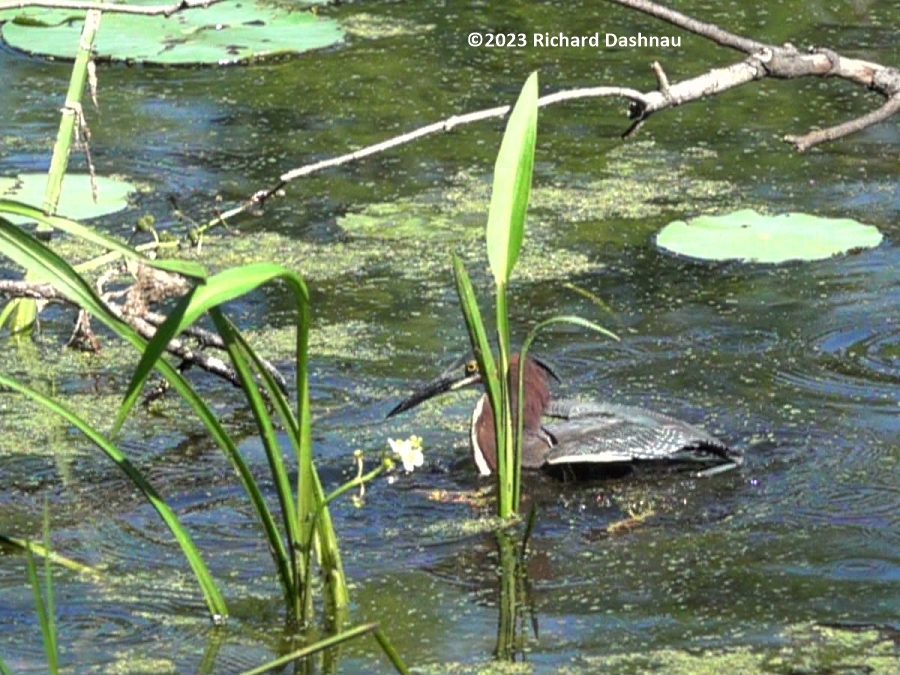
So, wet, hungry,
and possibly embarrassed. I read that extended head
crest as annoyance. But I'm not a bird, so I could be wrong.
There is video that goes with all these
images, at this link.
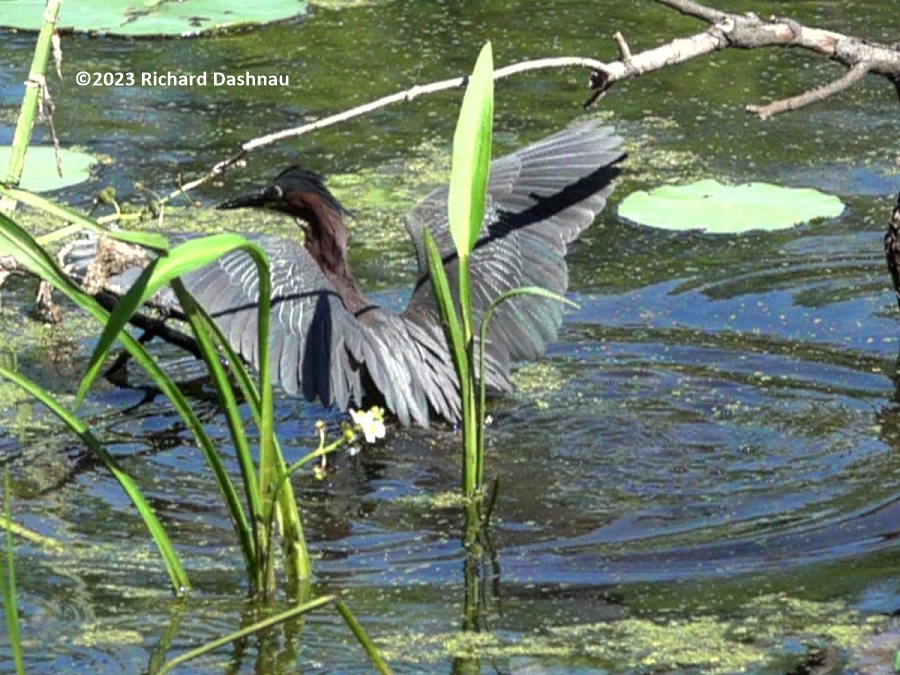
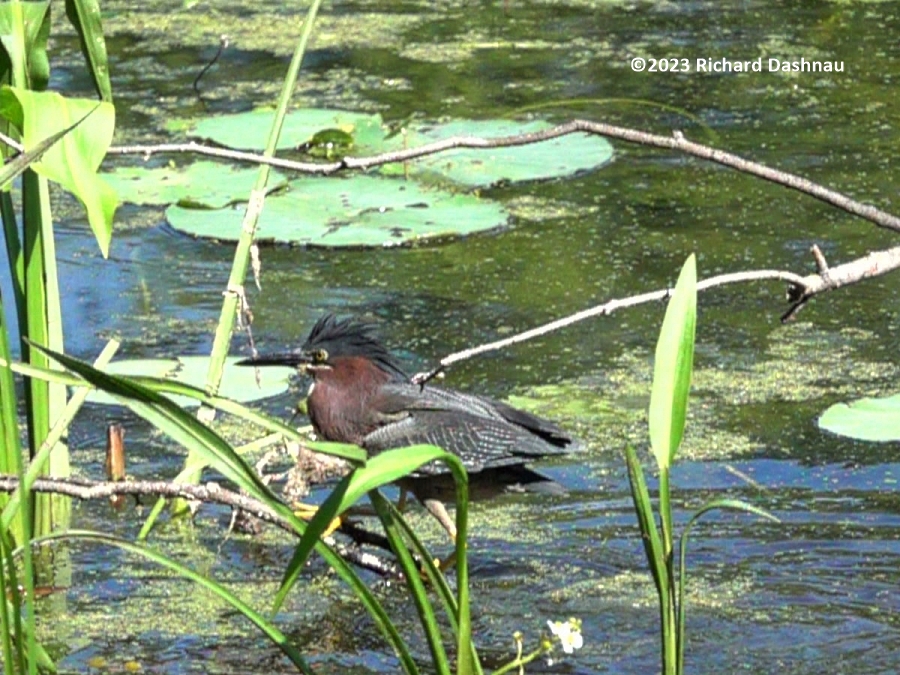
The
next Heron is showing another interesting technique-fishing with
bait! I've seen them usually use an insect or some small
arthropod; often while standing on a
lily-pad. I think that this
Heron is inexperienced in choosing a proper platform. It's
chosen
a pad that was too small.
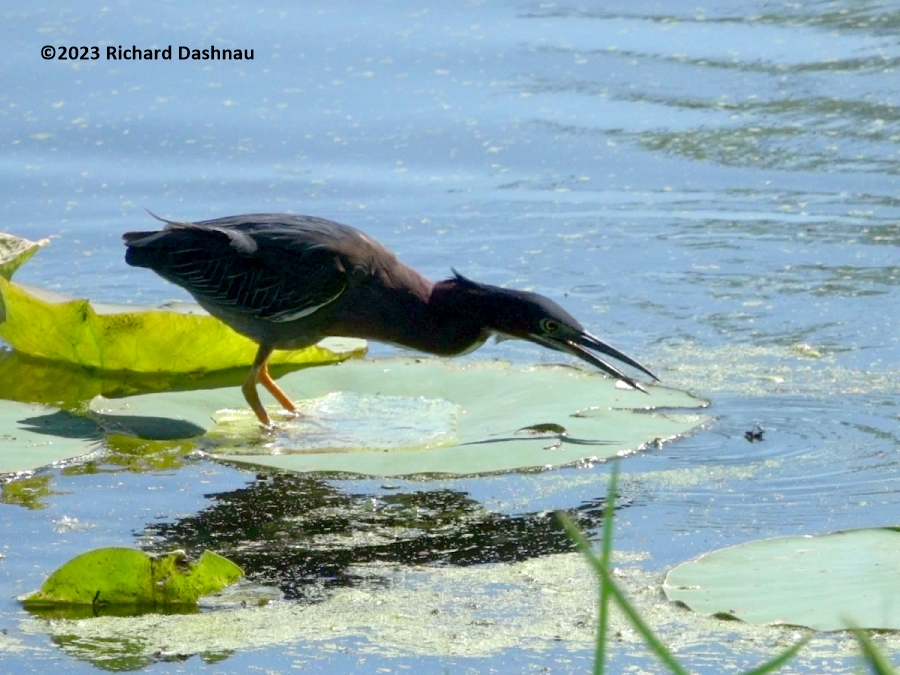
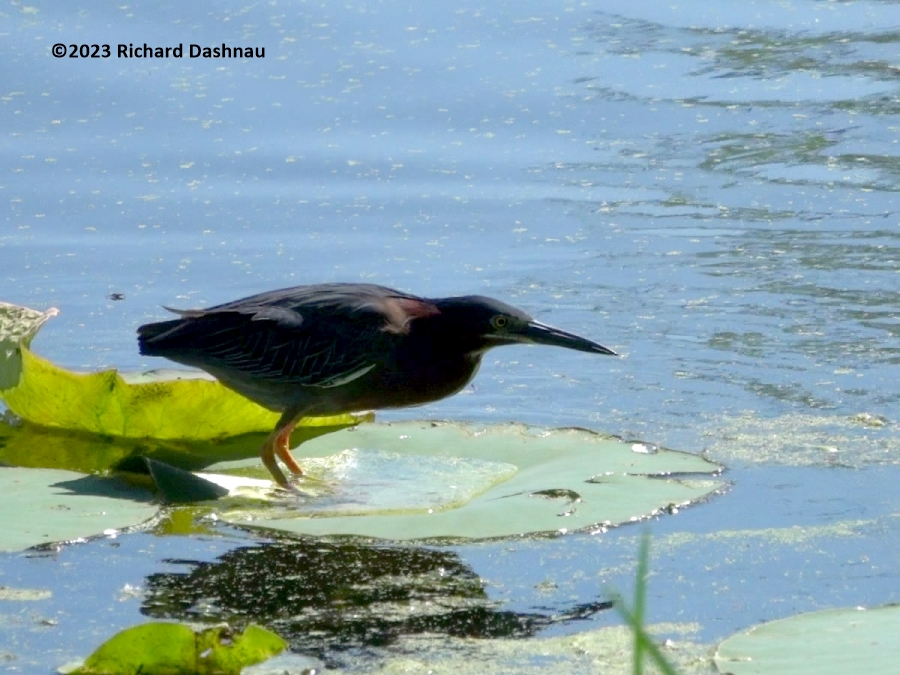
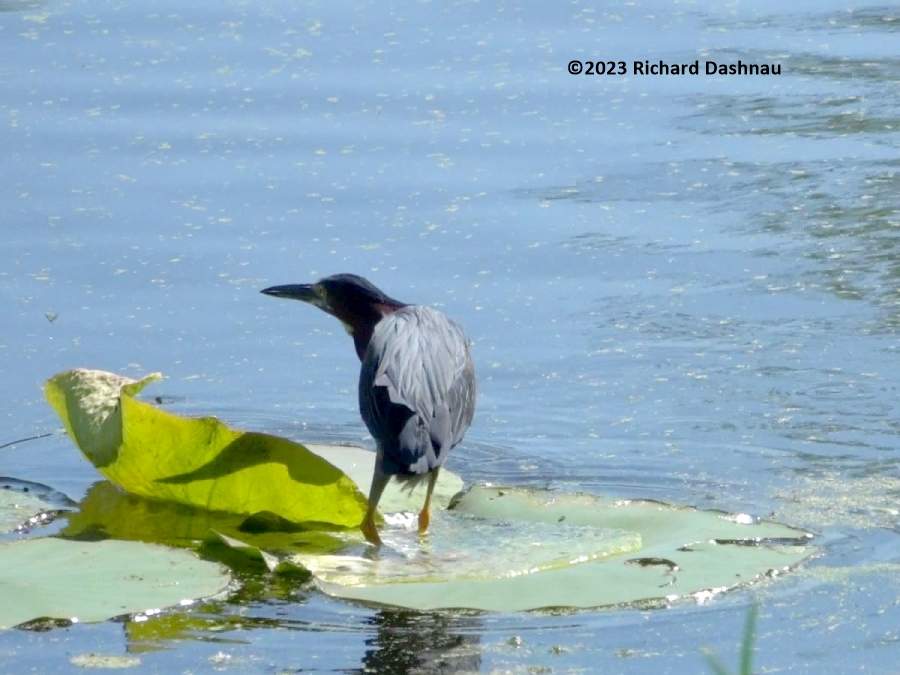
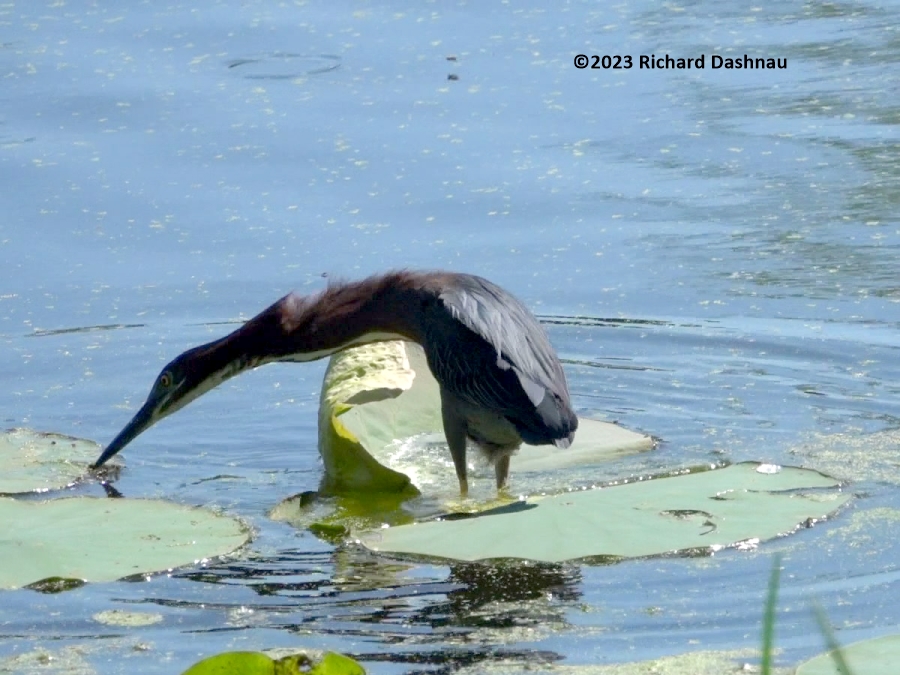
It grabbed
more bait and jumped to a
new pad, also too small. Slowed replay shows the
first
bait drifting off as the lily pad fills with water.
Turned,
grabbed another bait,
jumped to the next pad.
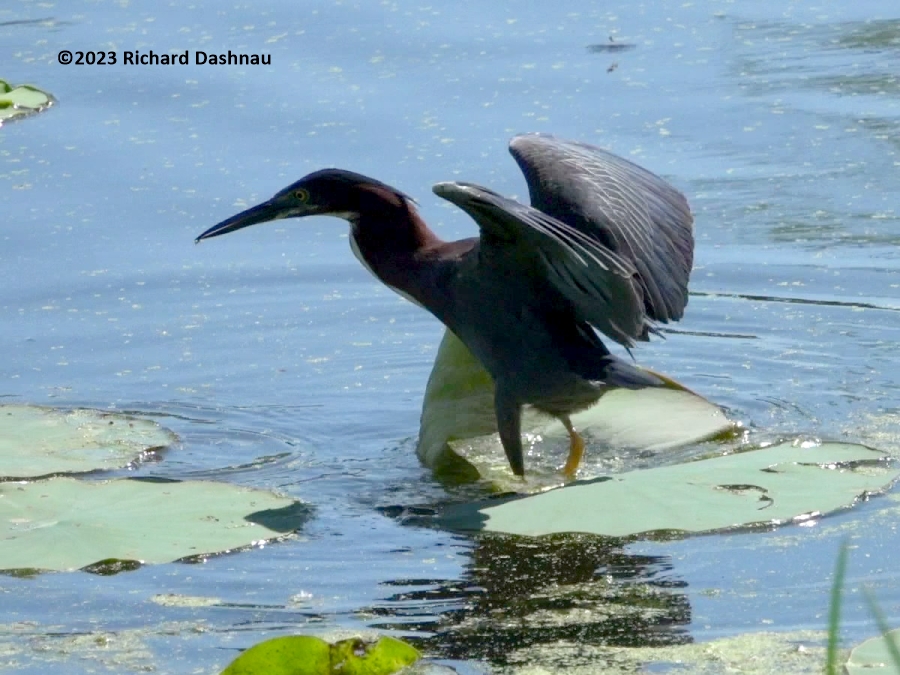
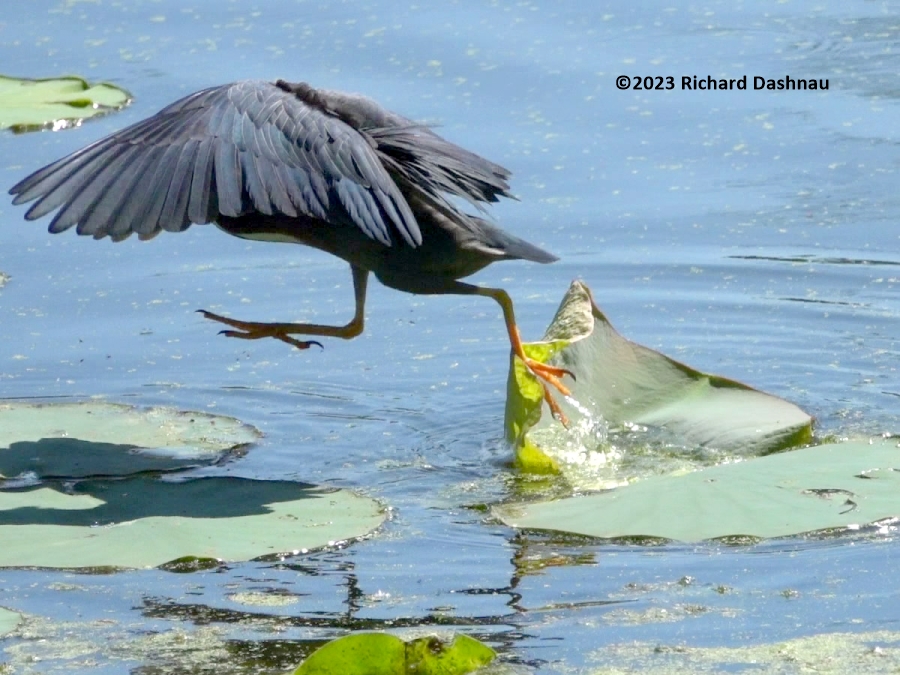
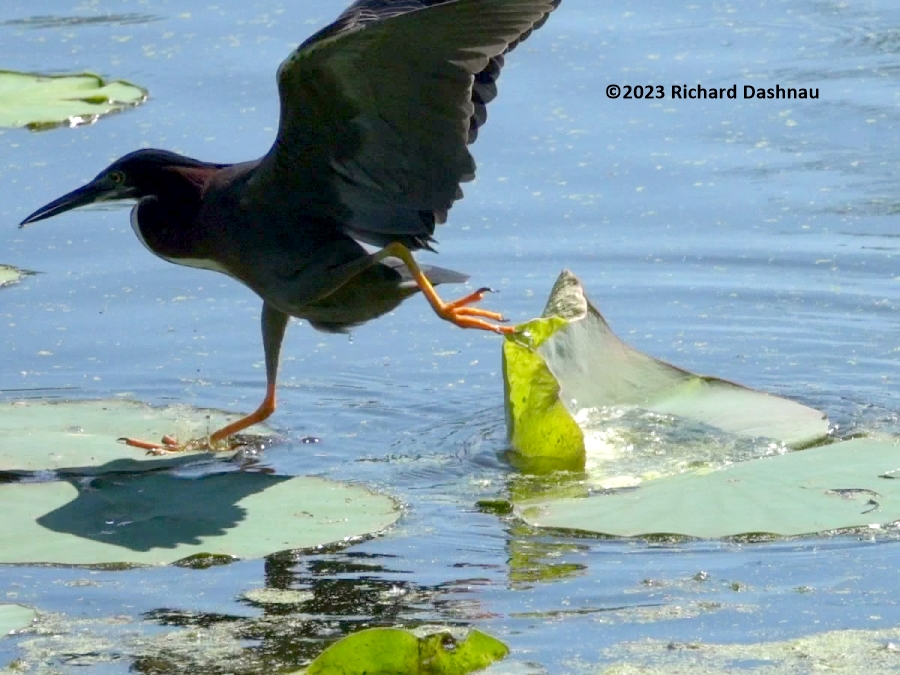
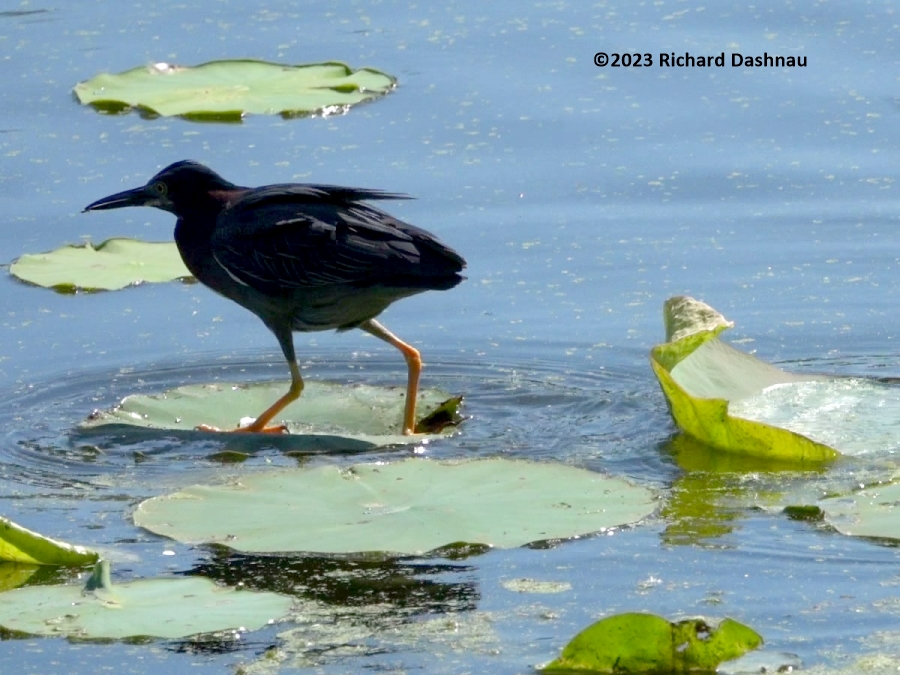
As the
Heron
prepared to place the bait, that pad sank, too. The
Heron flew off to a better spot. I think it's possible that Herons
learn to pick pads of the correct size as they
perfect hunting techniques with experience.
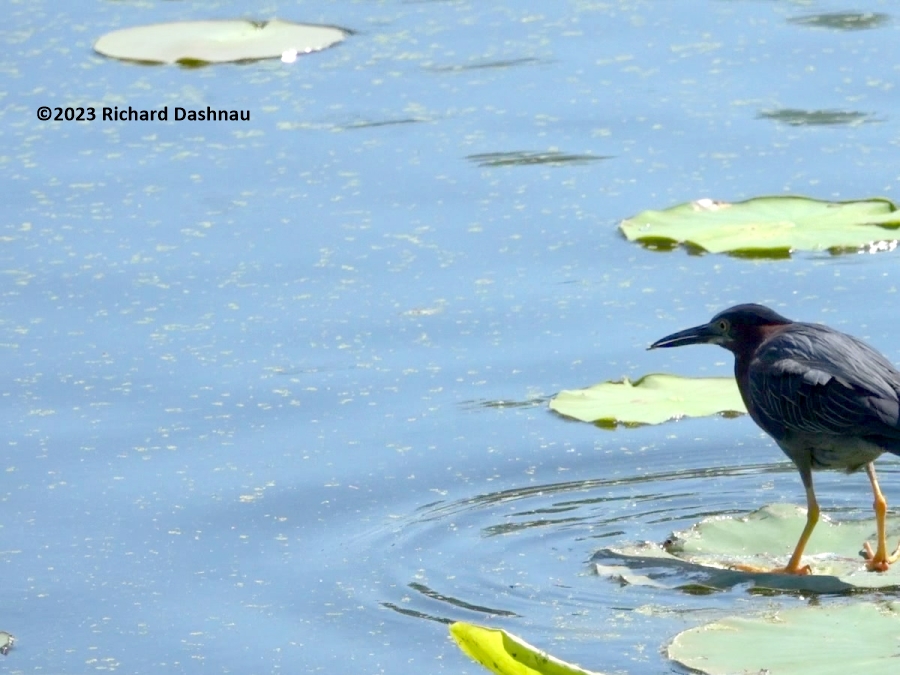
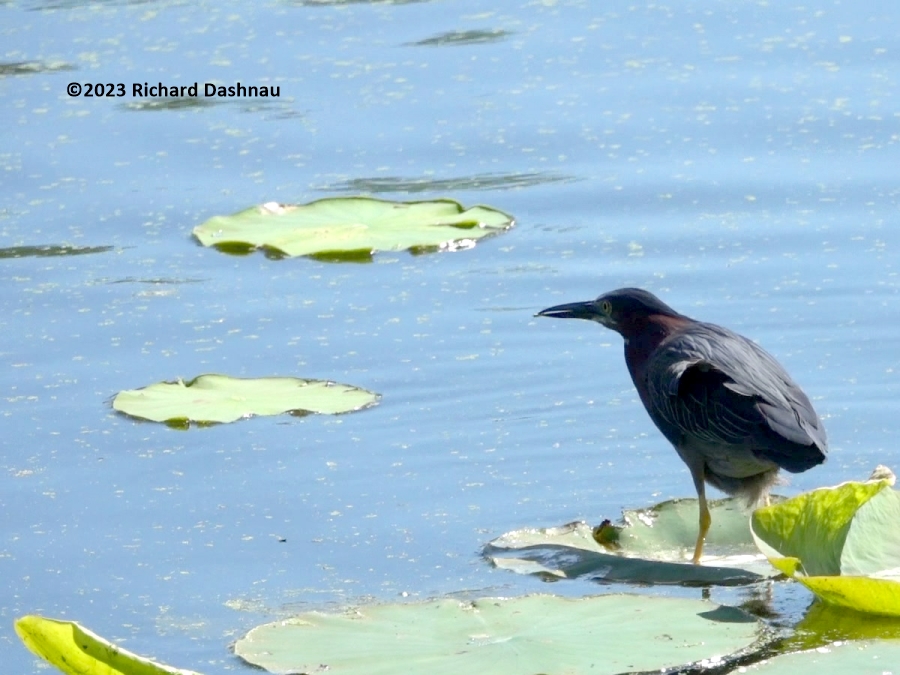
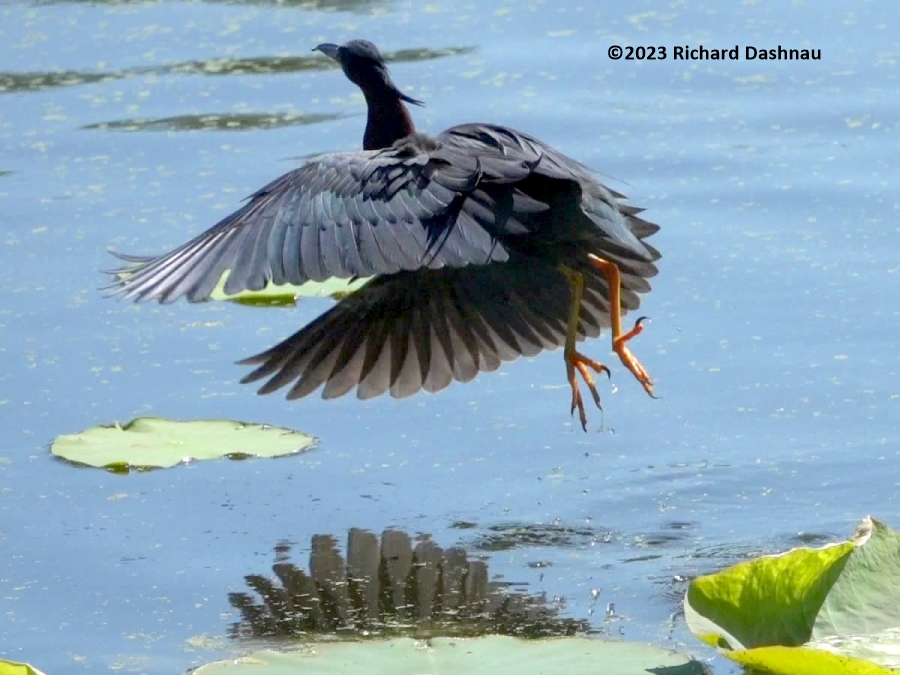
The
next Heron picked better pads as fishing platforms. The movements of a
Green Heron using bait can be subtle, and easy for a human
observer to miss. From this
angle, we can't see the bait
very well, but the repetitive "pick and place" movements are there.
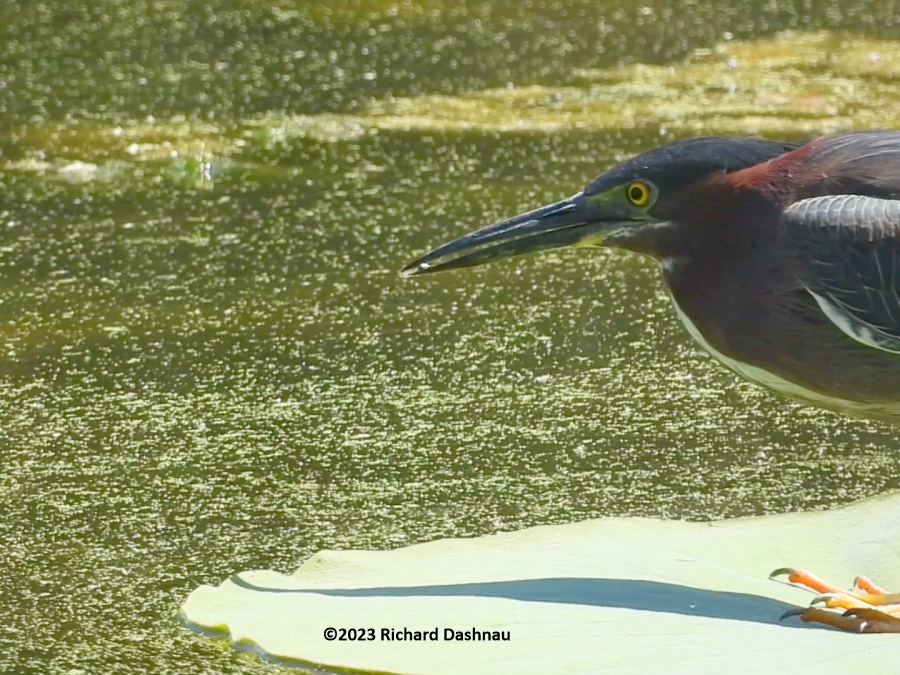
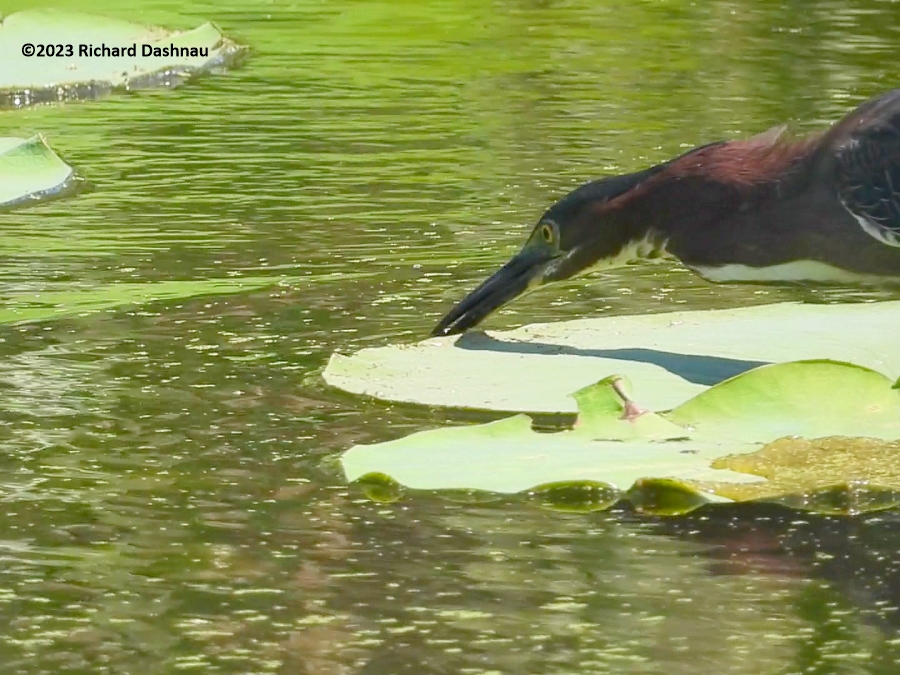
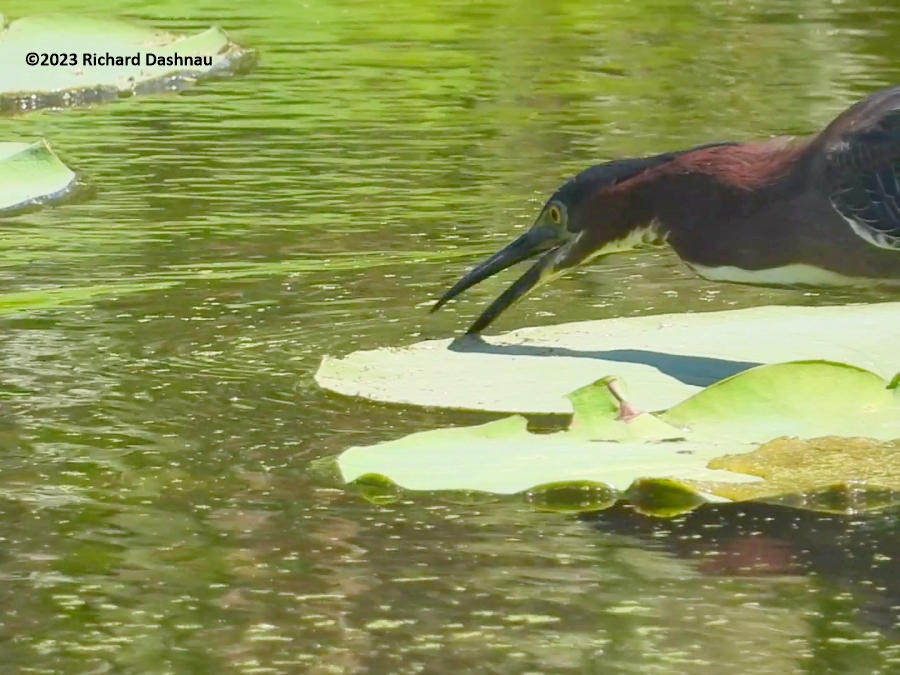
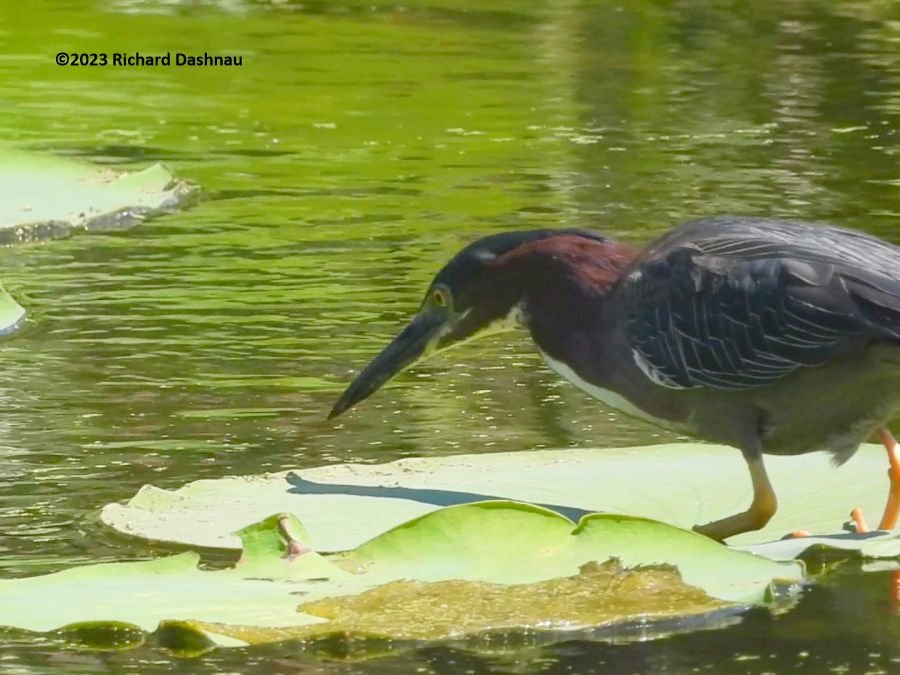
A
gust of wind pushed the pad, and turned the Heron to give us
a
better view. The Heron was about 25 yards away. Some park
visitors came by, so I explained what the
Heron was doing. This
was not easy to see without binoculars or some other
visual aid.
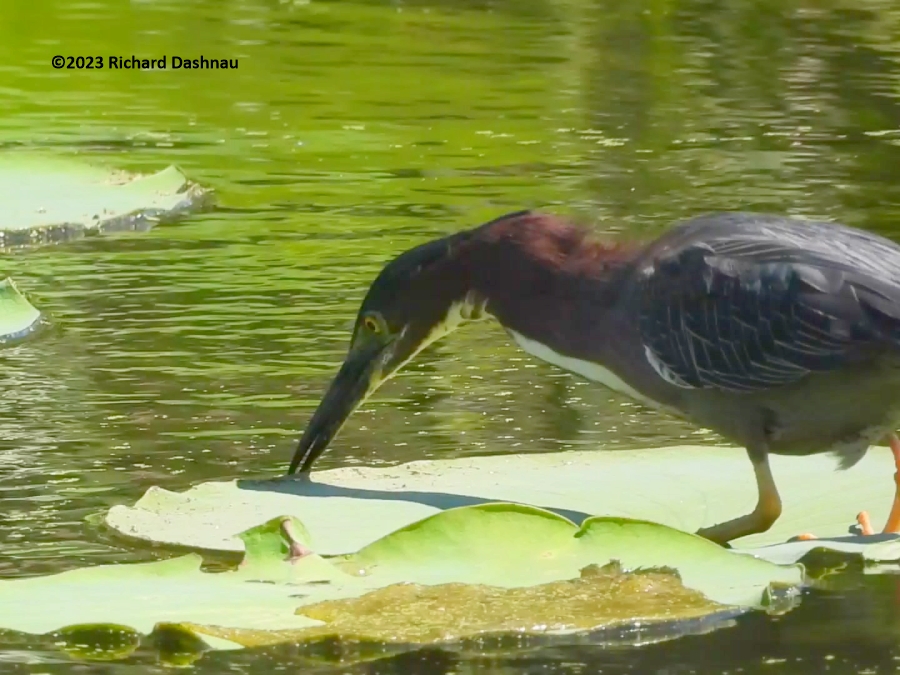
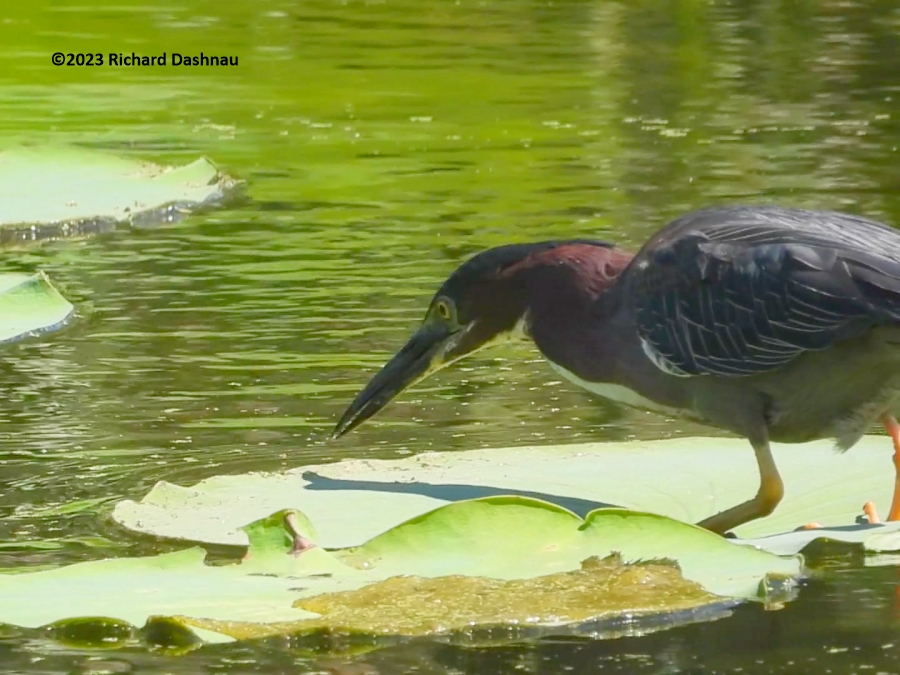
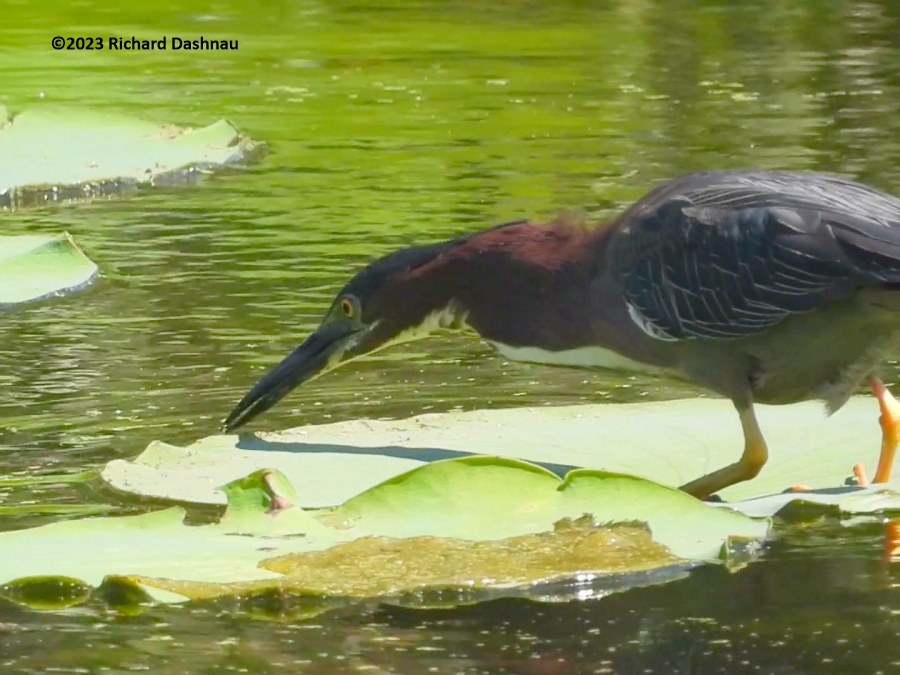
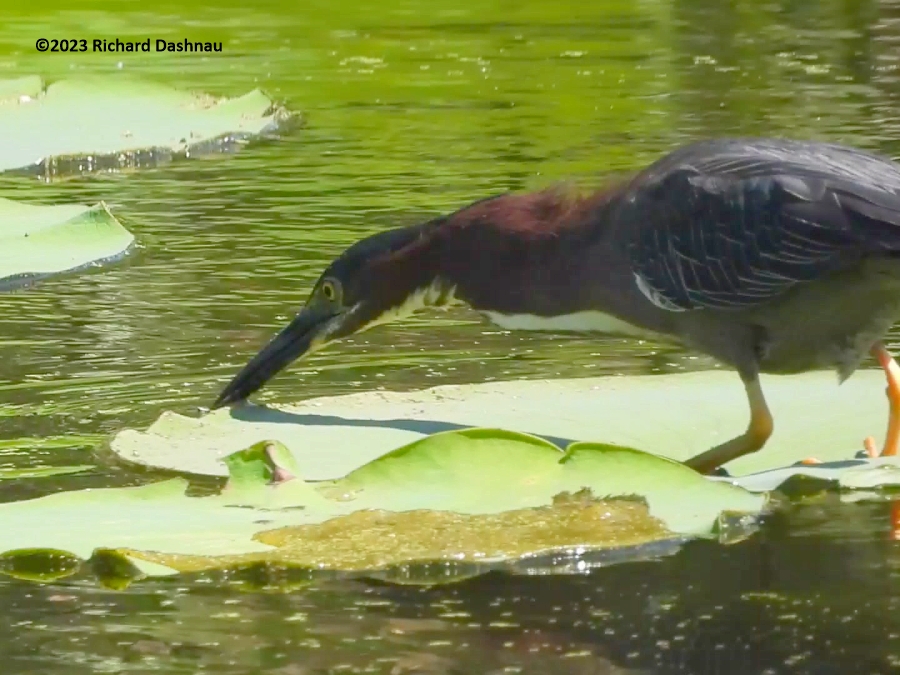
We can see the
fuzzy spot on the water as it drifted
by, to be picked up and placed to the left. If we-and the
Heron-were lucky, a fish would come up from below and take
the bait; allowing the Heron to take the fish.
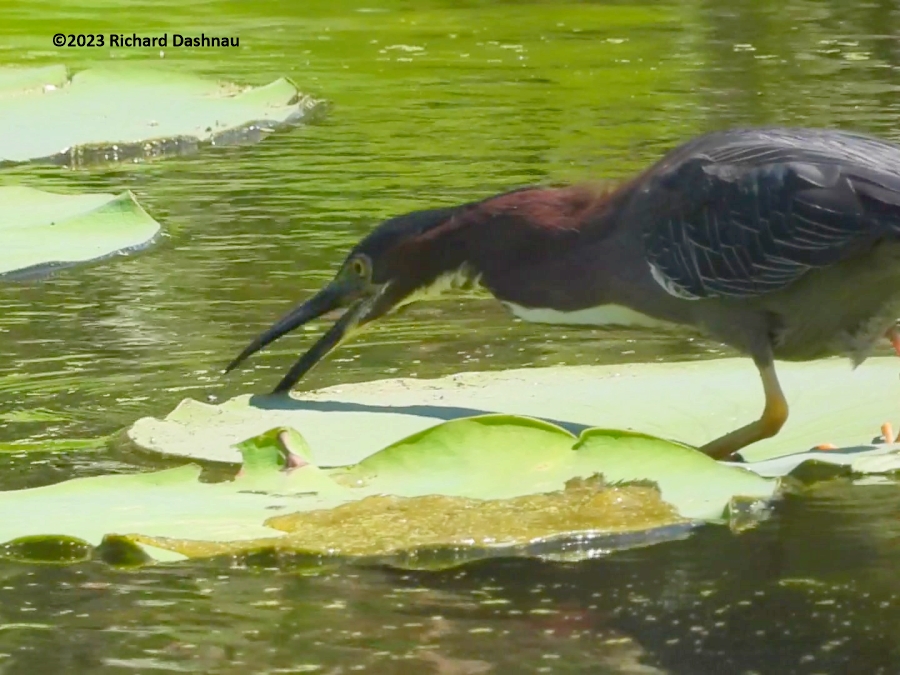
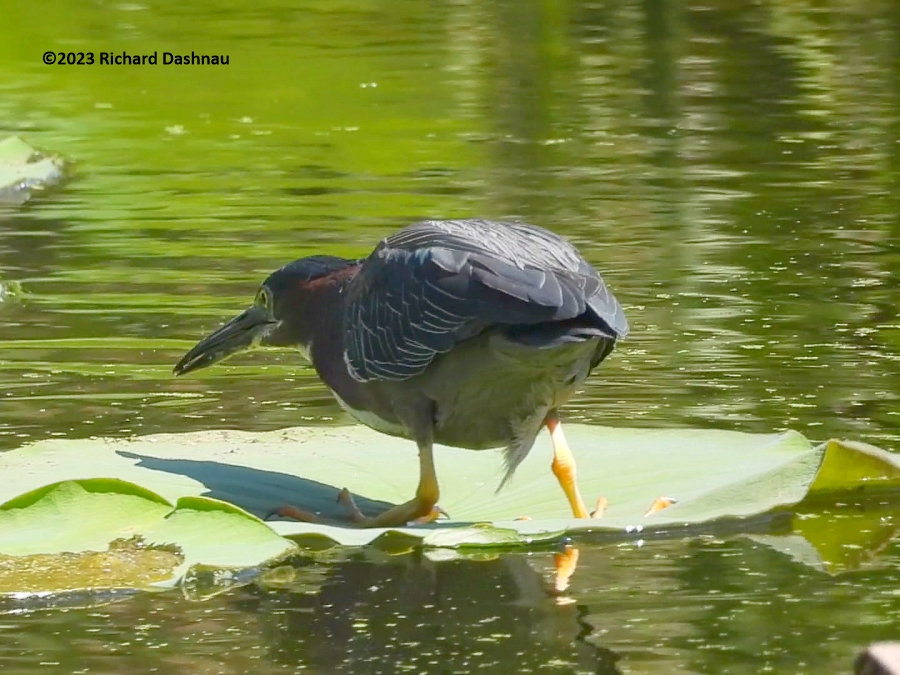
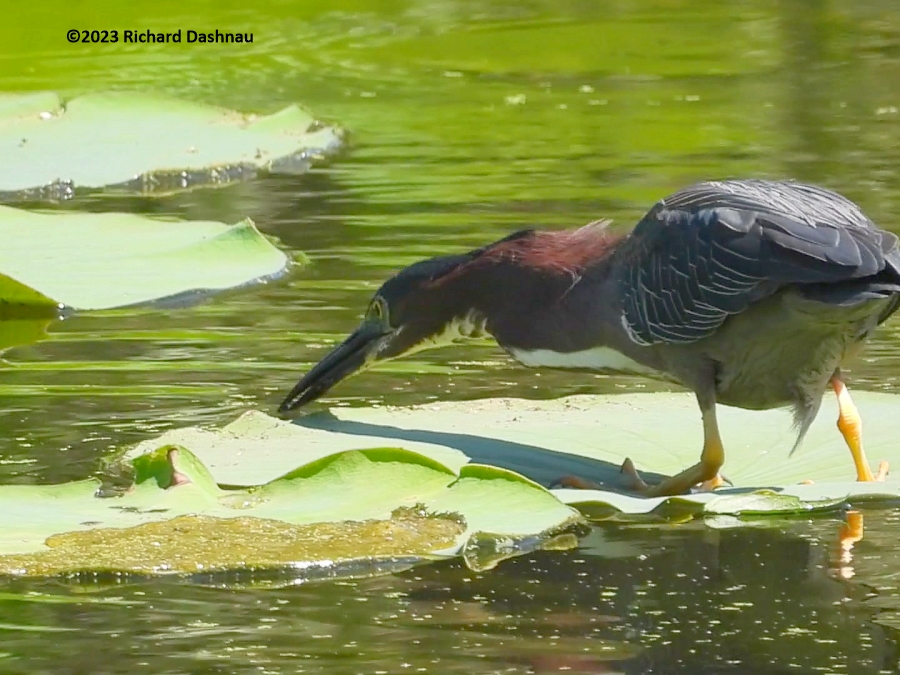
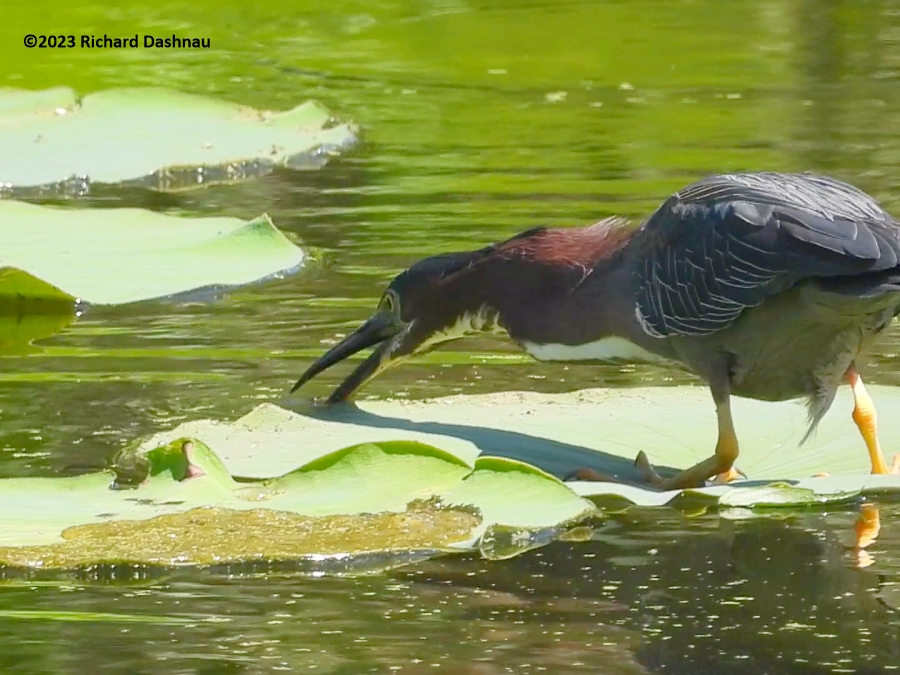
But, not on this
day. I wonder if the shadow of the heron on the pad would
have
any effect on the use of the bait. Is the shadow
movement visible from below? I haven't
seen enough successful attempts to tell.
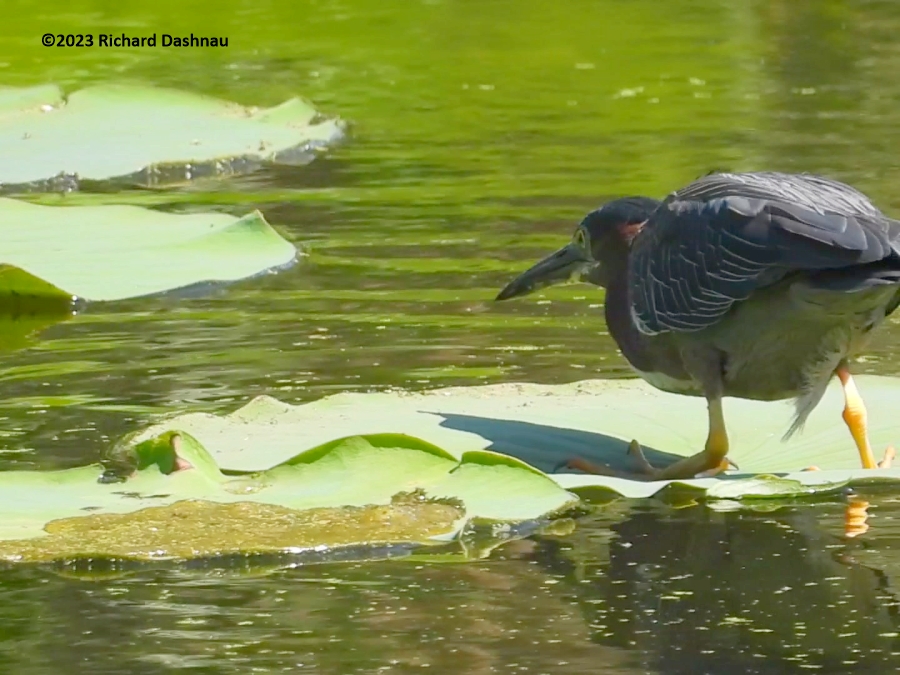
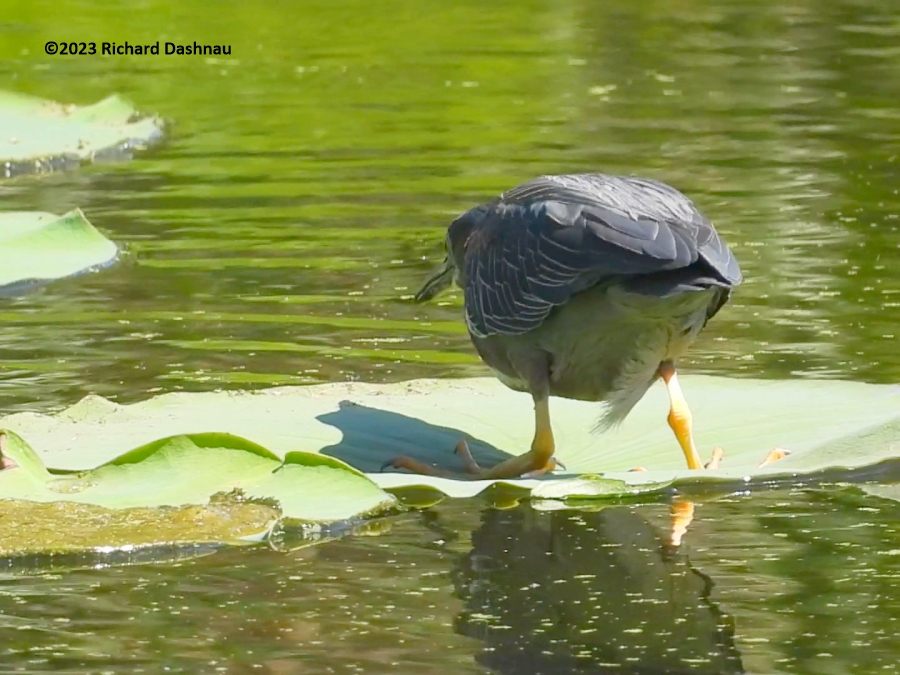
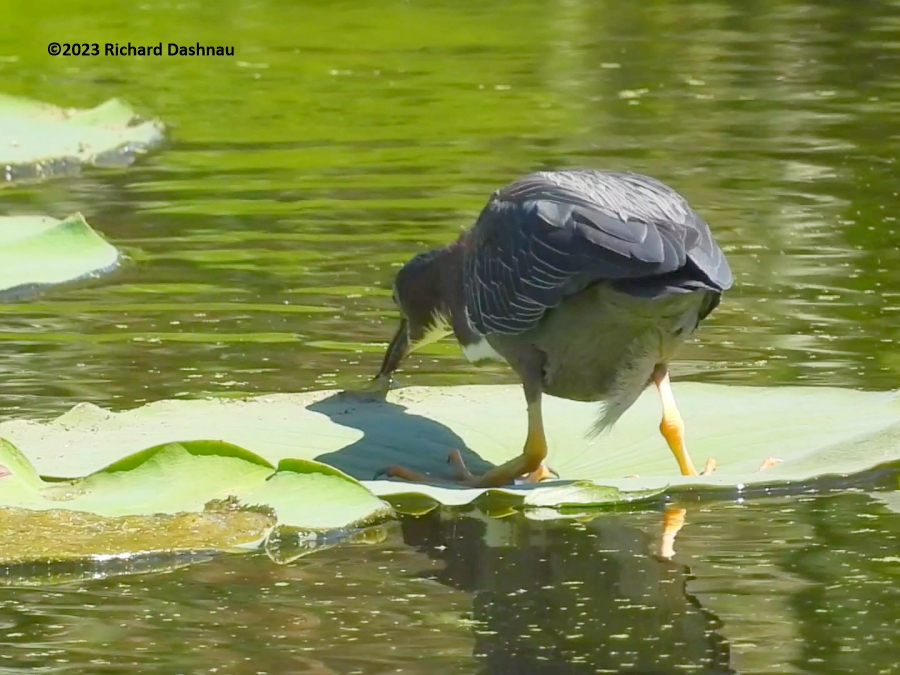
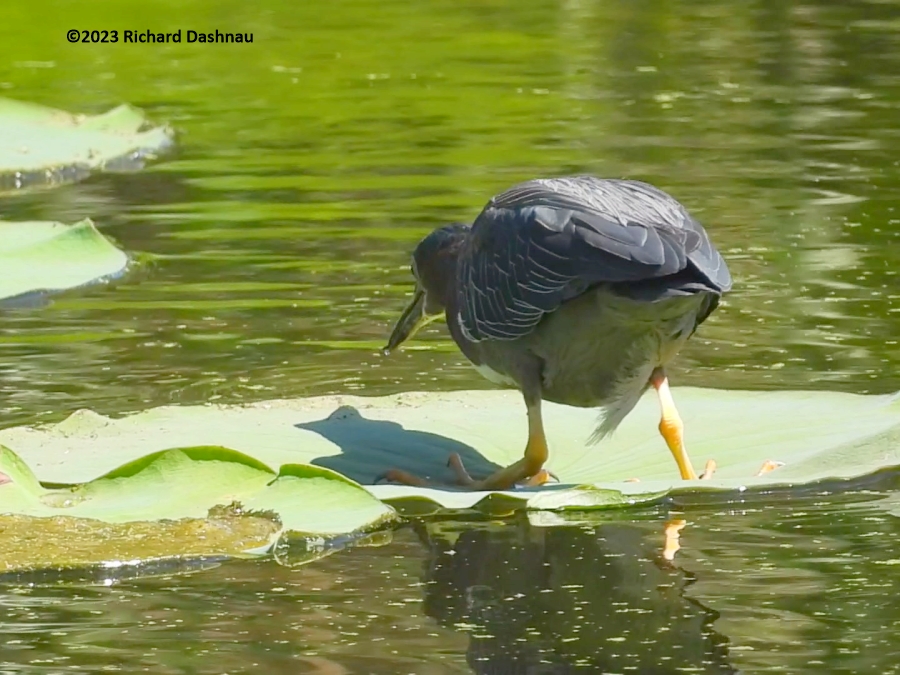
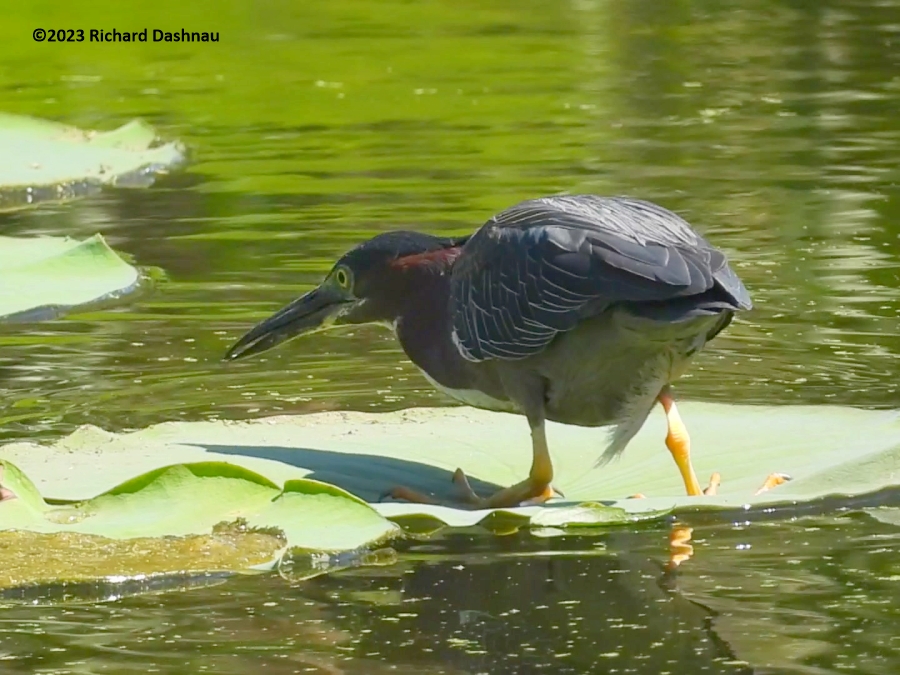
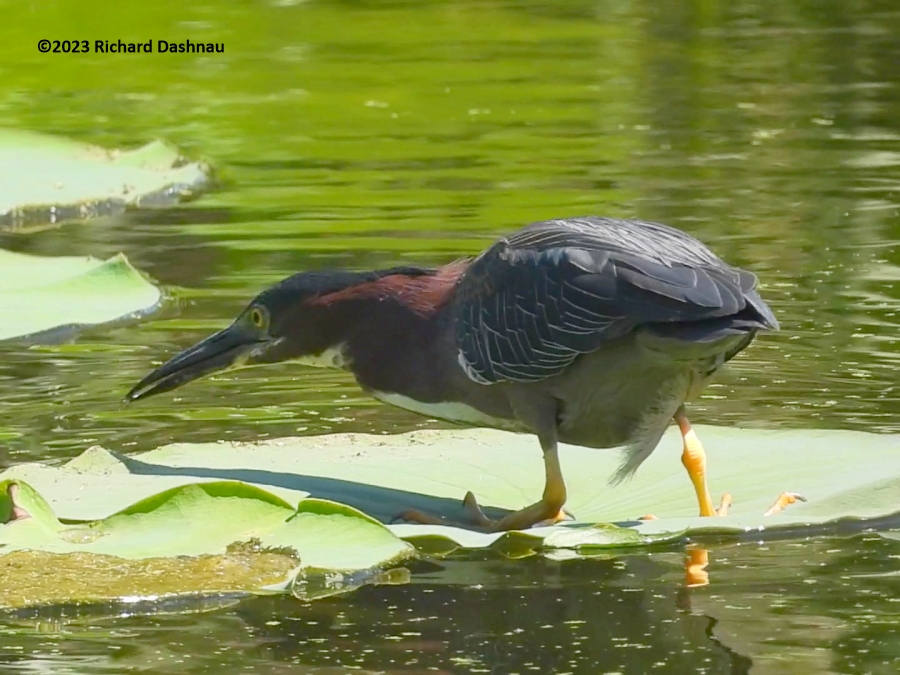
From BBSP on 07/03/2022 This
Green Heron was hunting in the water along the Spillway Trail. These
three images show its feet sinking into the mud. The mud had
only
been exposed a week or so, which is why it
was so soft. It was the beginning of the drought I
describe
on this page.
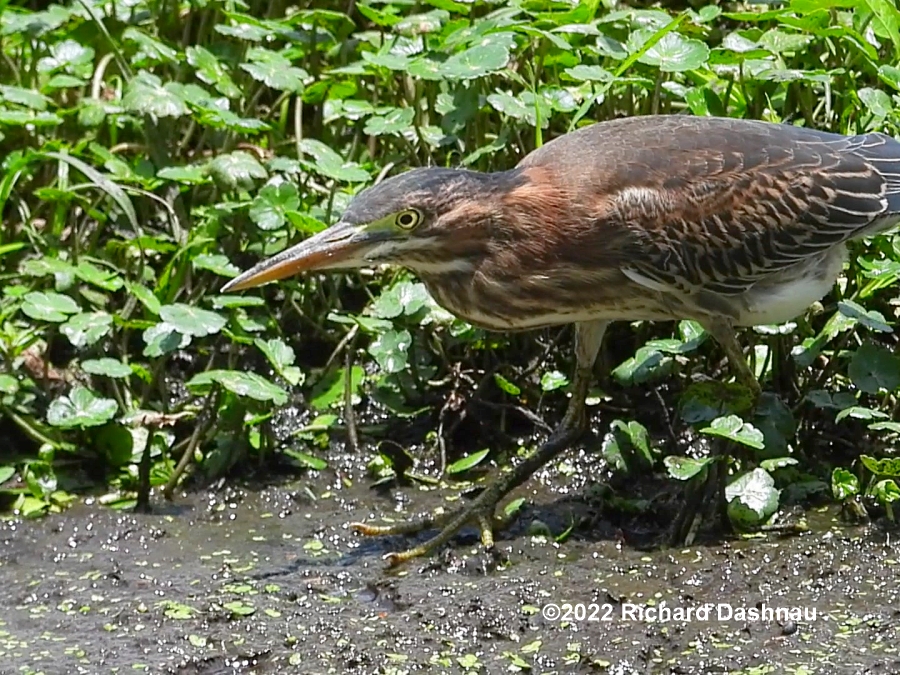
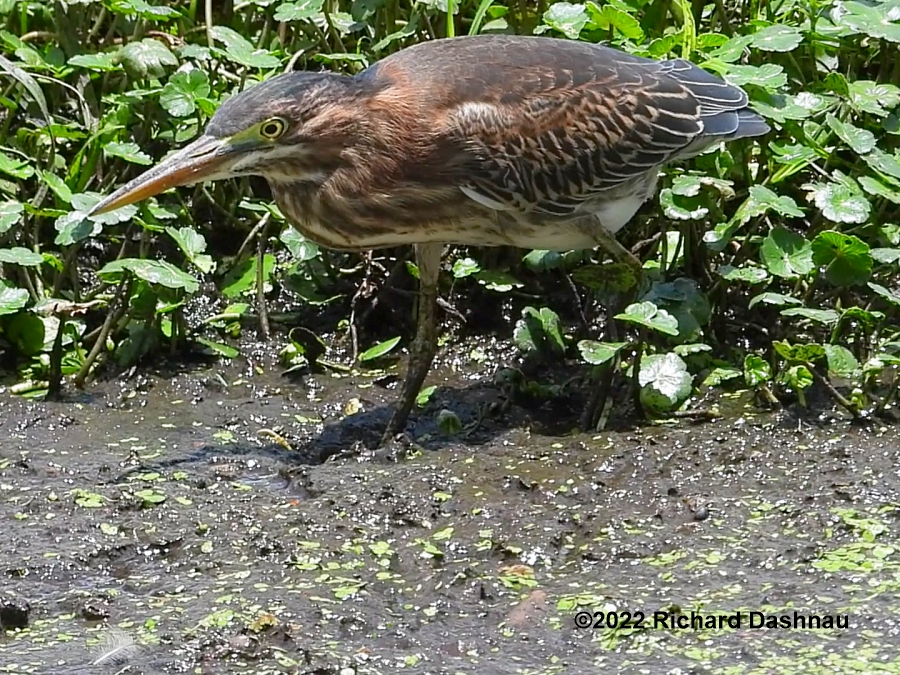
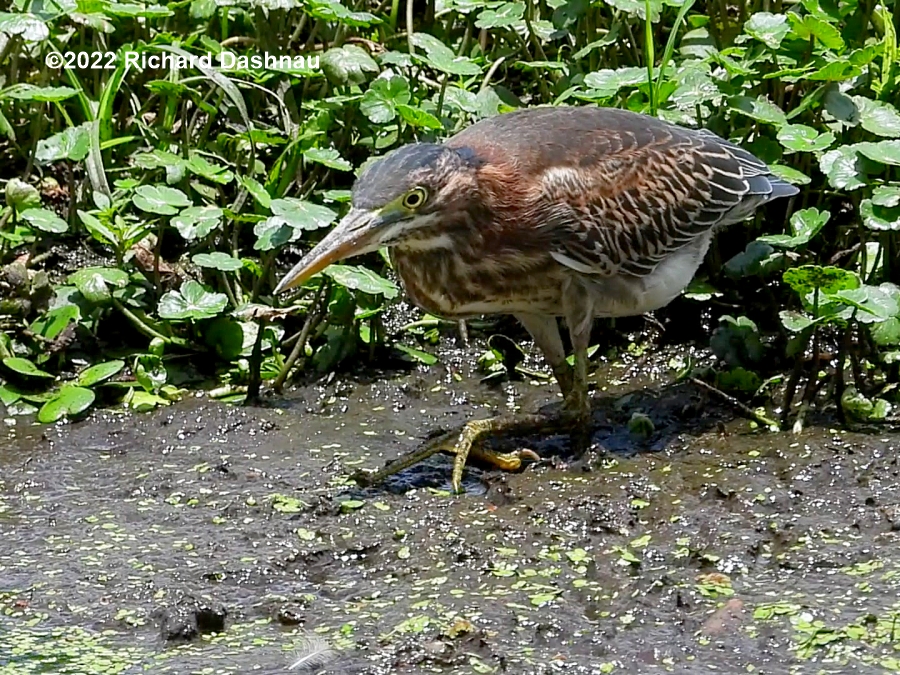
From BBSP on 06/05/2022
Due to trail construction, lack of rain, and the heat, the water level
in Pilant Lake has dropped dramatically over the last month or so.
Through the day (and I stayed on the trails between 40Acre Lake and Elm
Lake) I saw a LOT of green herons. They might have also been taking
advantage of the prey being exposed by the low water.
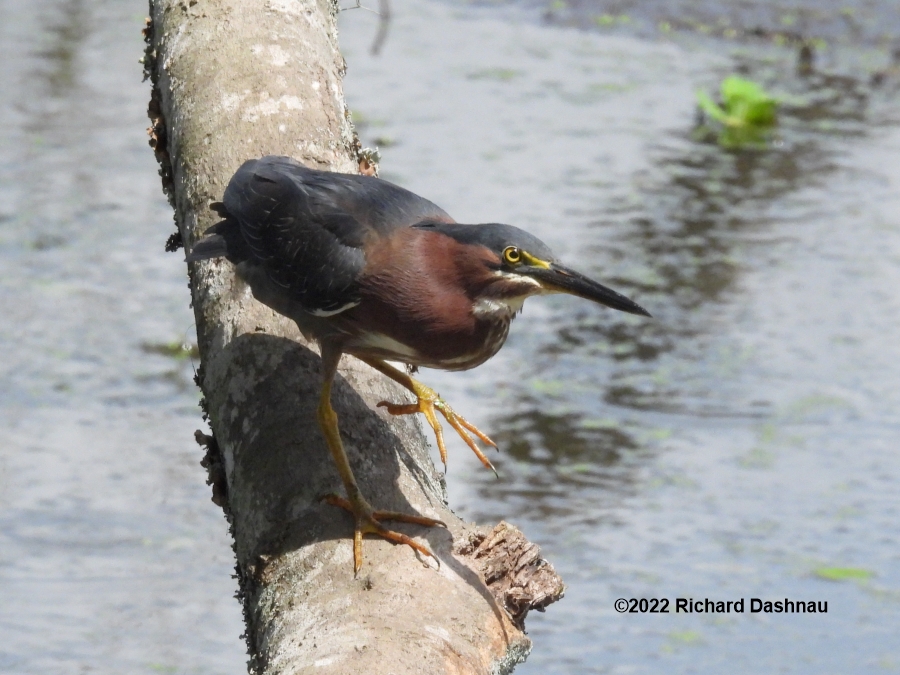
From Brazos Bend State Park
on 05/08/2022
I'm going back a few months for this update--to a time when Pilant Lake
was...a lake. Pilant Lake is dry now (10/06/22).
I
was standing near the Observation Tower when I saw this Little Blue
Heron (Egretta caerulea) about 20 yards North. At first
glance, I thought it had
caught a newt or some other type of salamander, but
I realized
that it had caught a tadpole...but one that was nearly a frog.
Judging from the size of the tadpole, and the colors, I think it was
going to be a Bullfrog (Lithobates catesbeiana). The
images below show Pilant Lake at a more pleasant time, a very
happy Heron, and an unlucky tadpole. There's video
edited into this file.
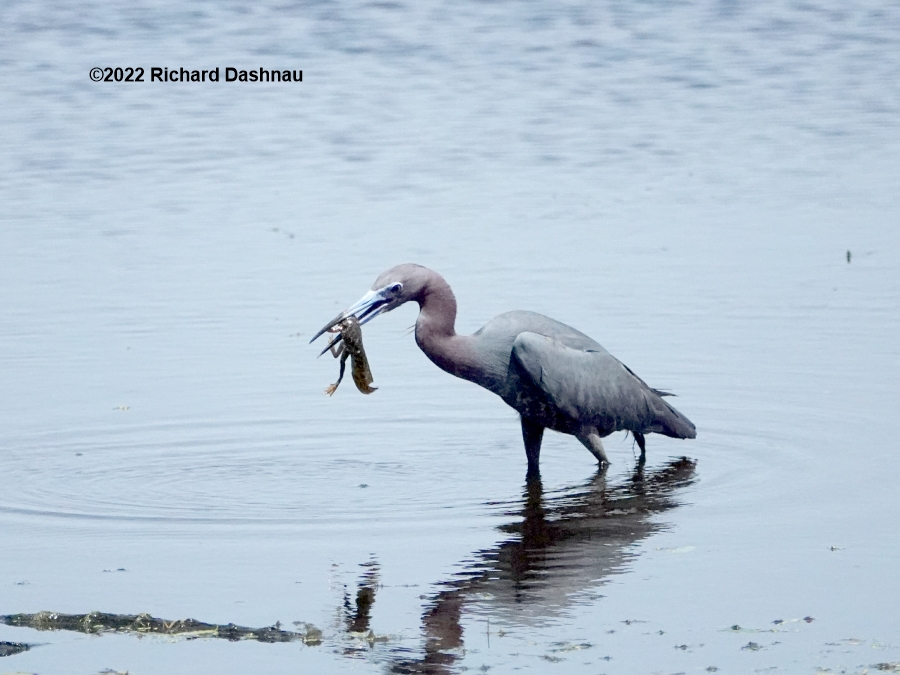
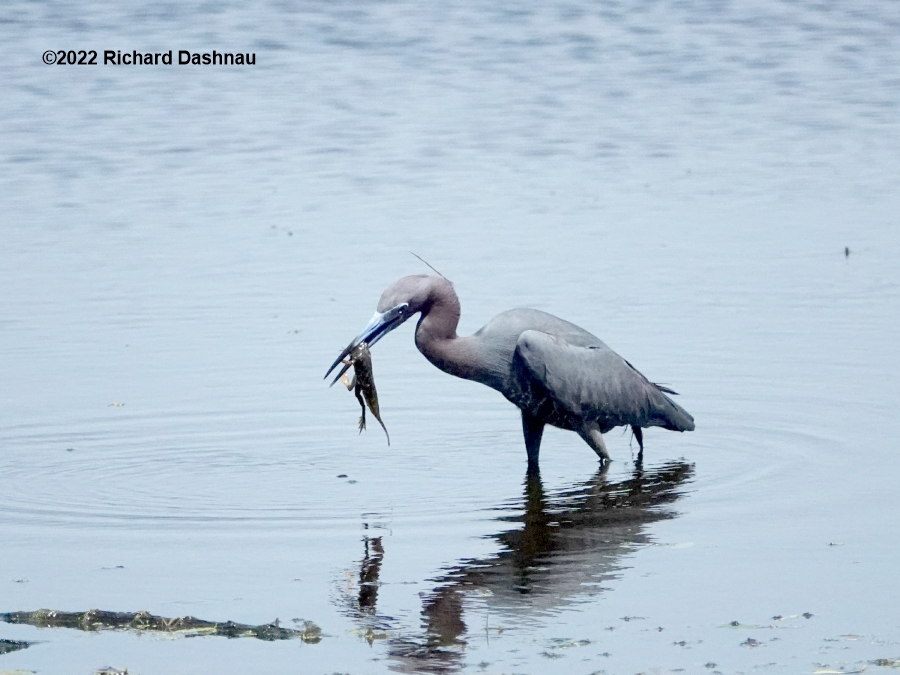
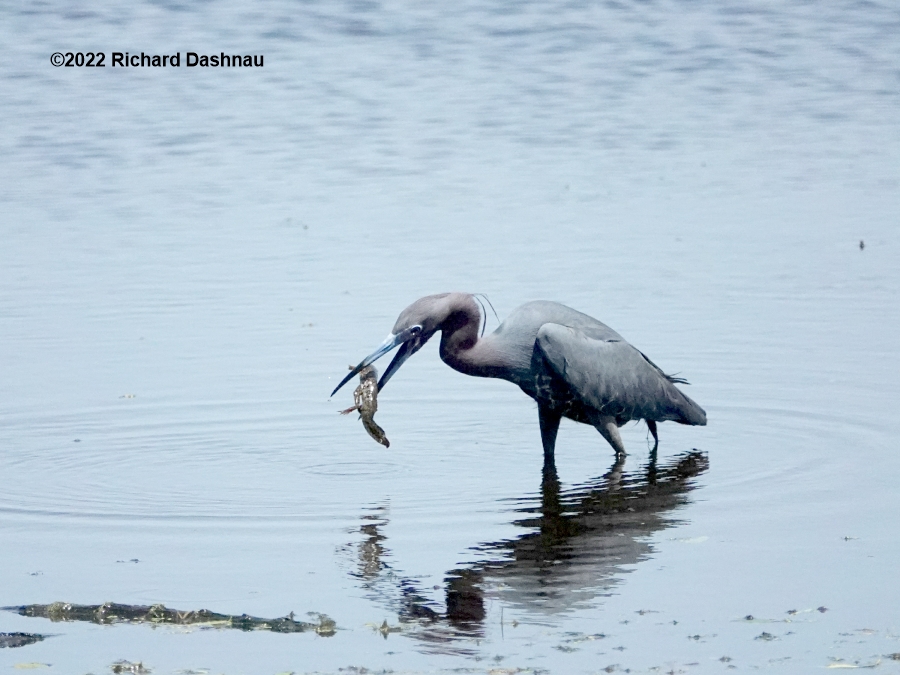

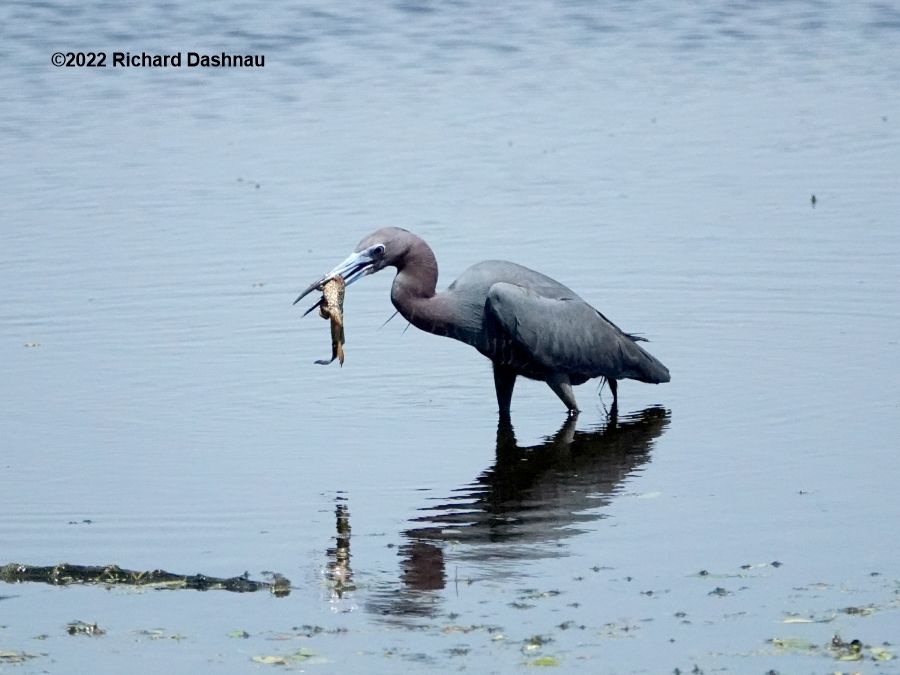
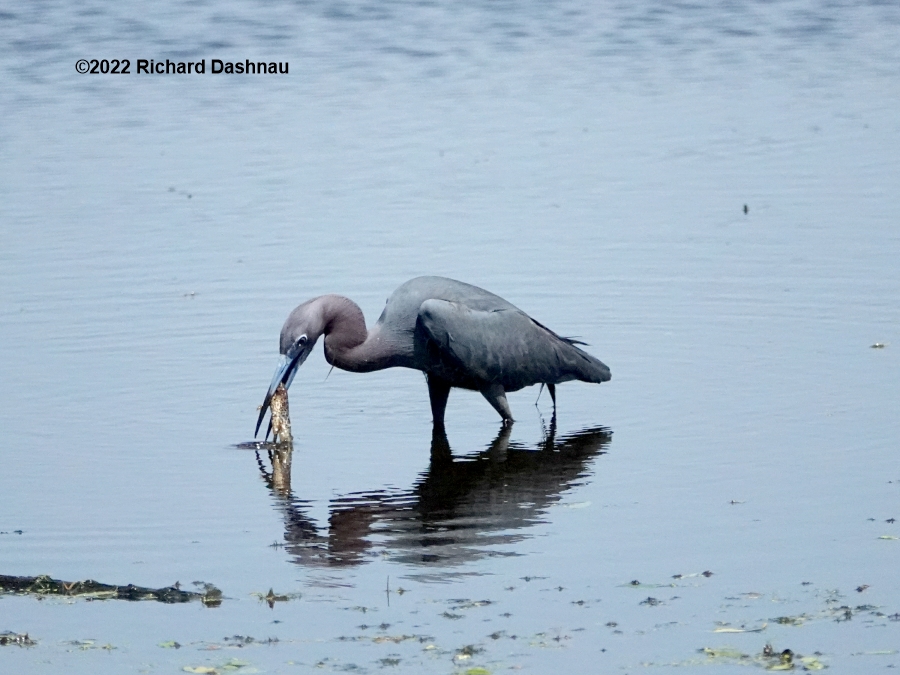
09/05/2021 -- Just
about every day I spend at BBSP is pretty good, but some days are way
beyond good (superlative and/or extraordinary). On 9/5, I started at
the 40 Acre Lake parking lot
at about
8am. Friendly folks were already gathering there for the scheduled
guided bird hike. I took to North path to the lake, going down the
hill. I mostly wanted to check the 5 alligator nests
that I
know-since it's time for gator eggs to hatch.
Along
the way, I'd stopped to look at the various birds, and snapped a few
pictures of a green heron that had stayed close to me. Also, another
volunteer, caught up with me, and we both
watched the park as we
talked. Just north of us, a trio of birds stood on a small sapling. At
the top, was a black-crowned night heron, midway down-a little blue
heron; and at the bottom, a
common gallinule (aka moorhen). At
about 8:30 I'd turned away when Janey said that the black crowned had
caught something. I turned back and was able to get it in the
binoculars as it flew
across the trail towards the islands. It was carrying
something large and dark, and I just guessed it was a large crawfish
(didn't look like a fish, so crawfish reasonable assumption). But when
I found it again in a tree--I saw that the heron had caught a
small bird! It looked like a baby moorhen. Instead of trying
to
get closer, I started shooting video. It was over in a few
seconds.
On
review, the prey does look like a baby moorhen. Images below are frames
from the video. The video can be seen here (mp4 it's
very short).
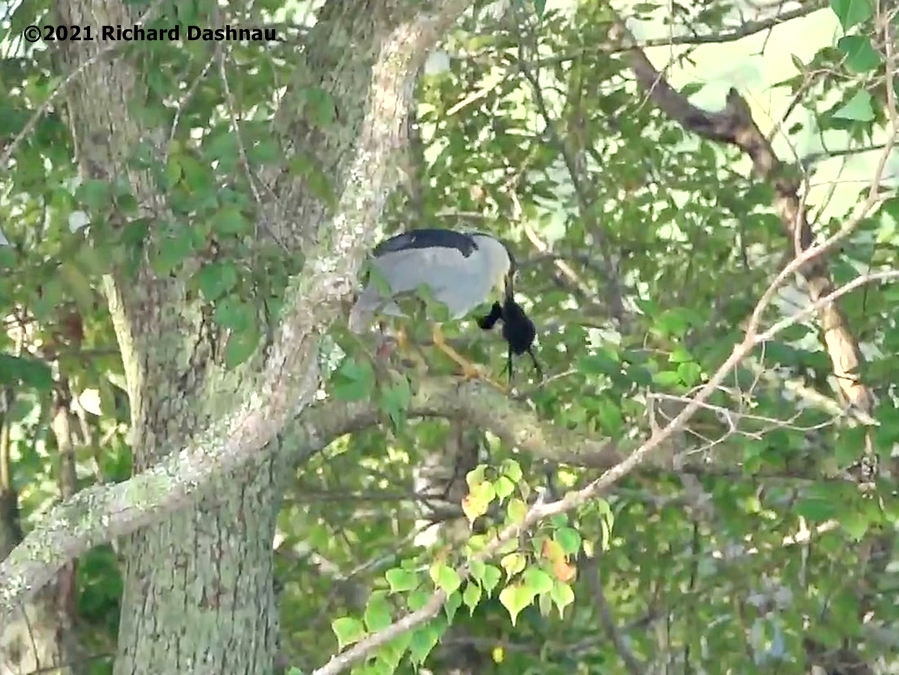
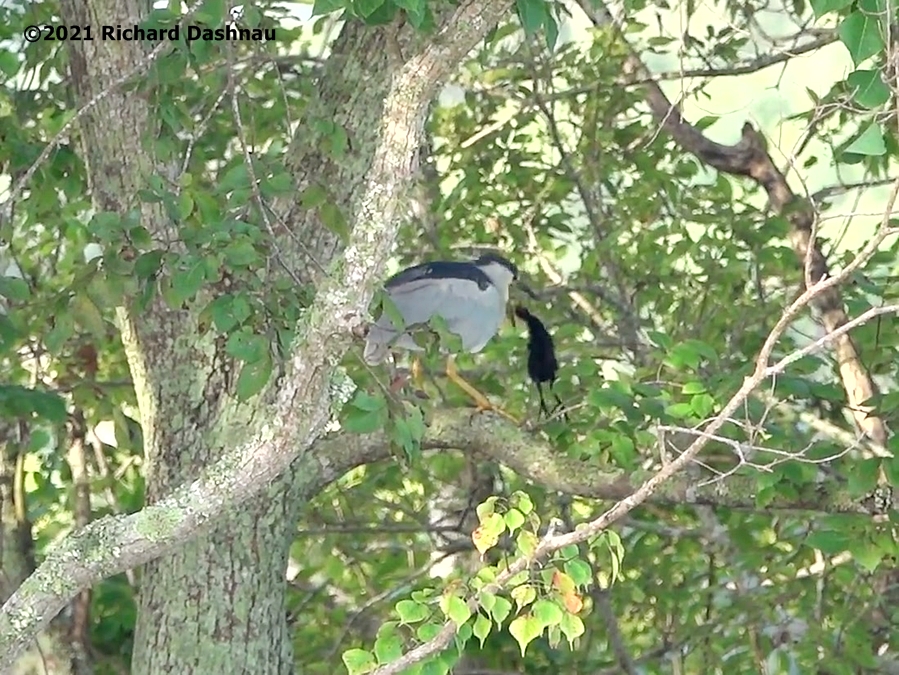
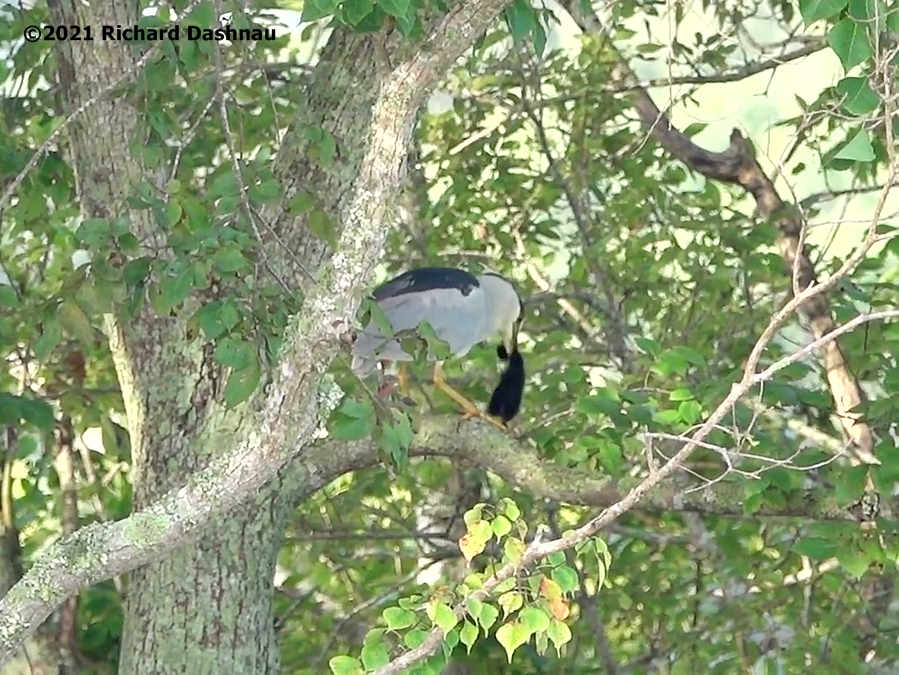
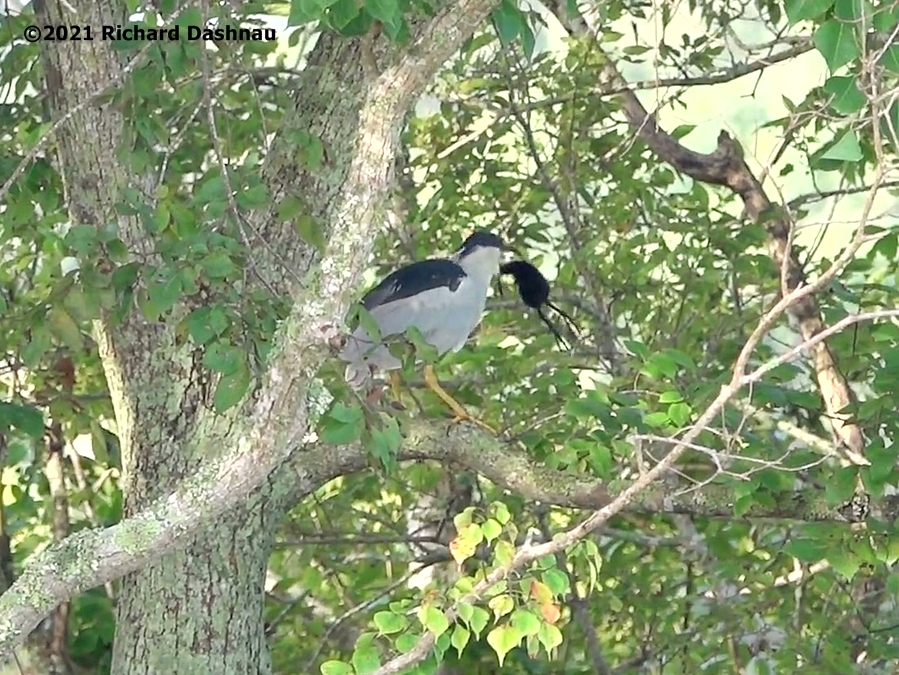
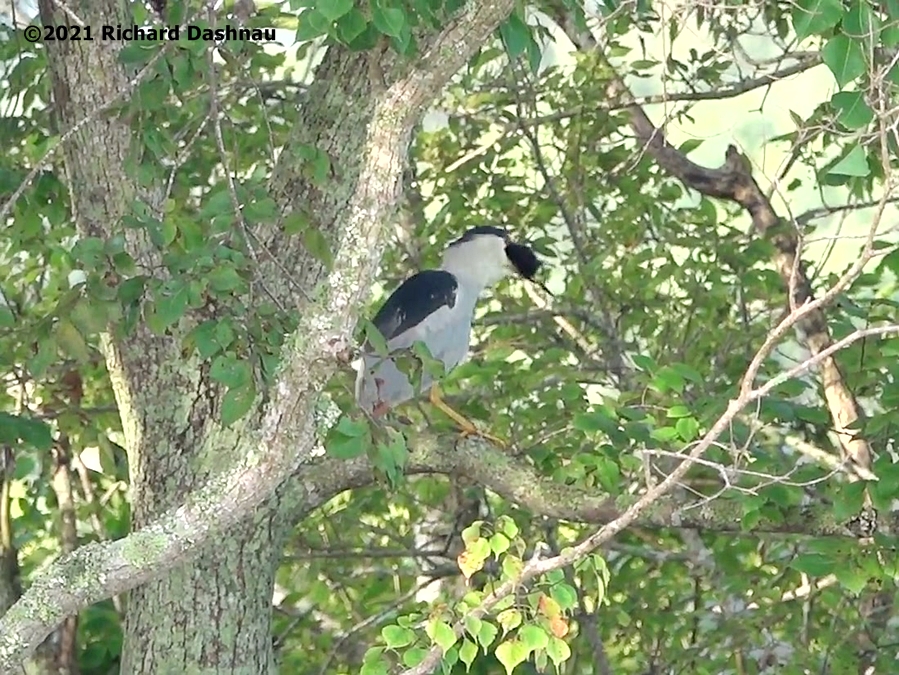
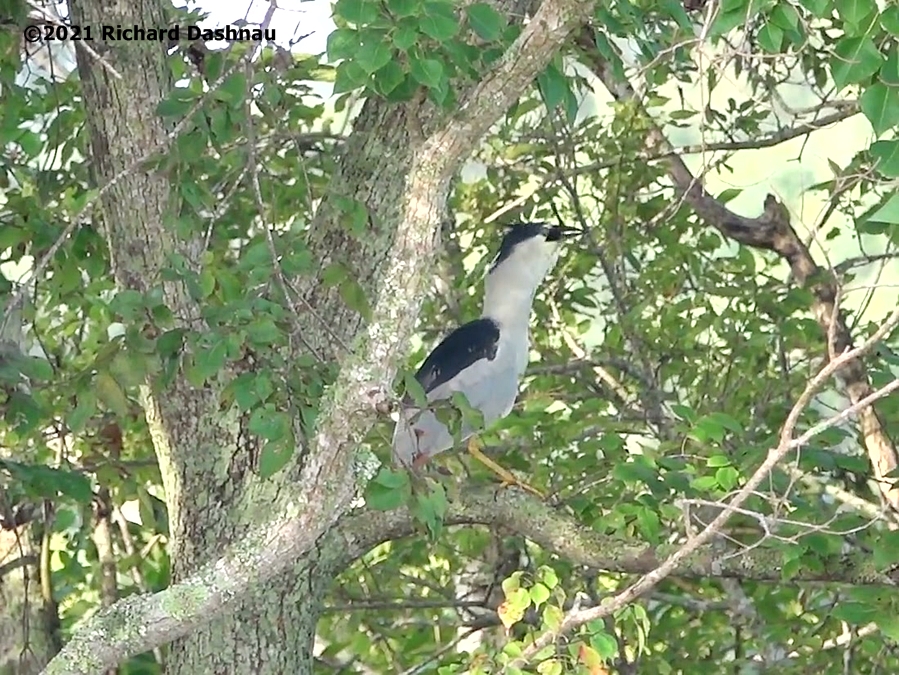
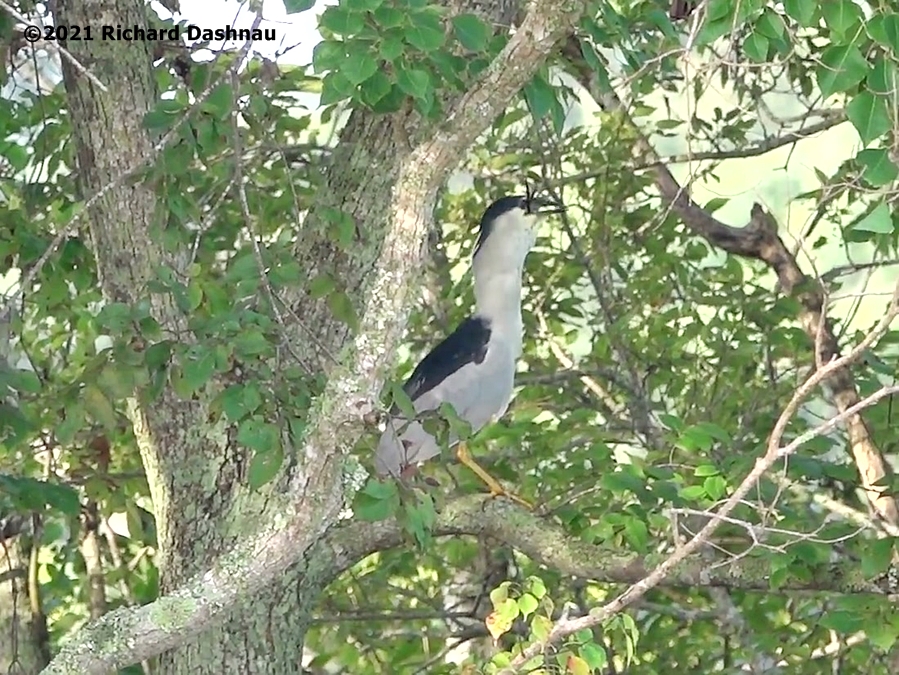
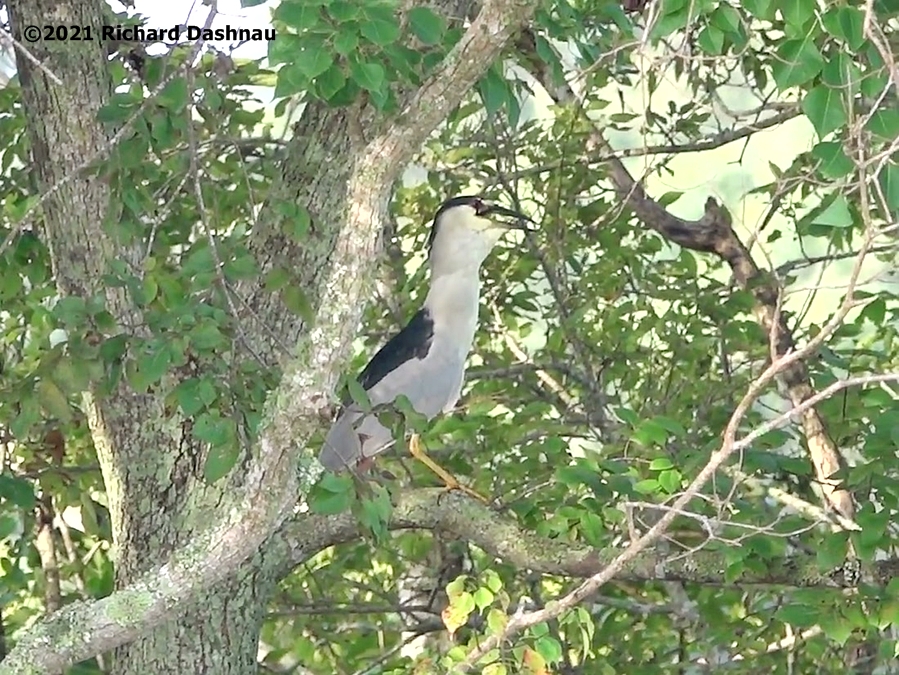
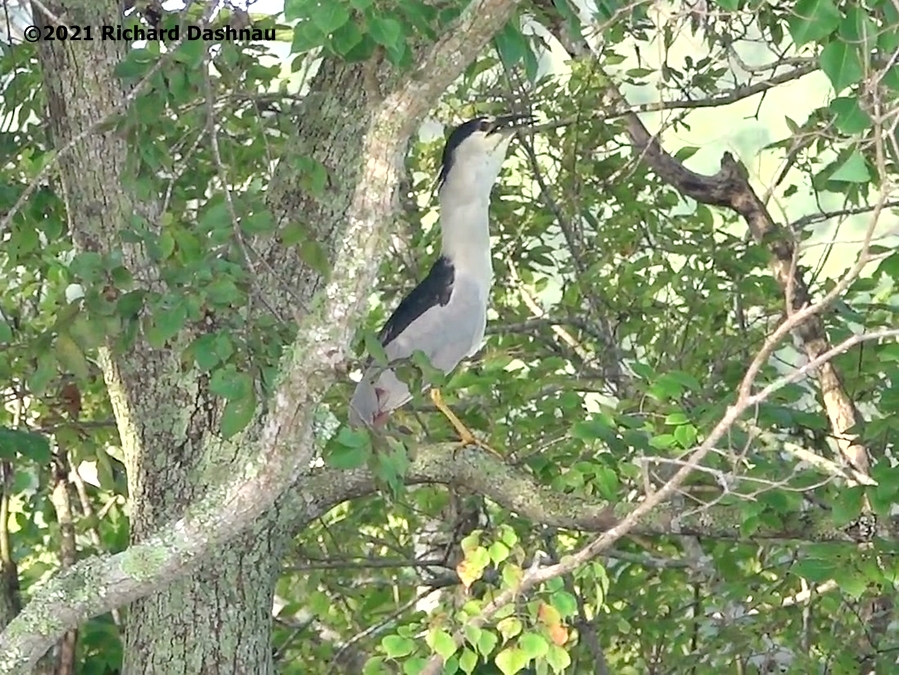
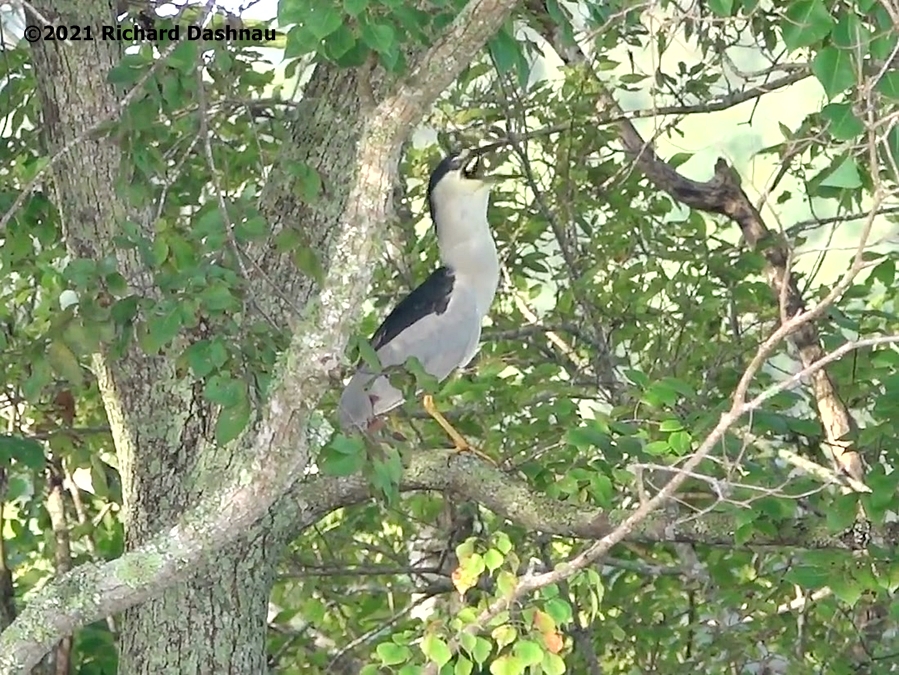
04/04/2021 Back
to Brazos Bend State Park! It was great to be out on the trail and
interpreting Nature for interested visitors. It was Easter Sunday,
which is usually one of our busiest days, so
I was on my bicycle.
While this lets me cover more trails, it cuts down on what I
can
see. However, that doesn't mean I missed everything.
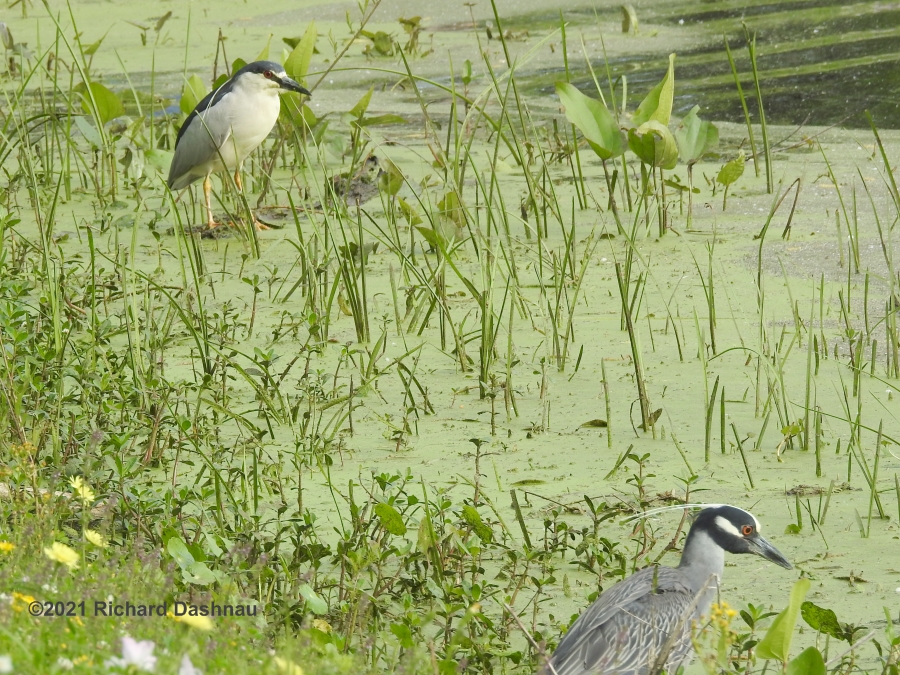
Finally, I could only just
grab this picture of a Black-Crowned Night
Heron (Nycticorax nycticorax)
near a
Yellow-Crowned Night Heron (Nyctanassa violacea) before they flew off.
It was
a
great day to be out at the park. These pictures just show a
few of many wonderful experiences from today.
08/13/2020 Like
almost everyone these days, I've been staying inside. I have
stopped driving too far...
for purely
recreational purposes. I've also been avoiding parks
that take much time
drive
to; since we are generally asked to limit travel. Today
I went out to Archbiship Fiorenza Park phase 2(second
time
this week!) and I was happy
to see it wasn't crowded. I walked, but
not far, since I wanted to keep
an eye on my car. The
pictures below show the park that day. It's easy to see that there
weren't many people in the park (although there were many parked near
the playground). Here's
a quick look at some of the other animals I saw that day.
There
was a very small Green Heron (Butorides virescens) fishing there. In
the first two pictures below,
the
Heron has a fish. I watched this bird for a
while, and I
noticed that although it seemed to be catching fish, it wasn't eating
them. Instead, it was dropping the fish. After a few repetitions of
this,
I realized that the Heron was probably using the small fish as bait! That is,
it was trying to use that dead fish to lure a
larger one to the surface. I filmed some video of this Heron
using the fish.
It seems to be catching the fish, and placing it into
different spots...then watching for a while. Click this link
to see the video of the Green Heron Fishing (mp4) . The Heron
flew off without
catching anything larger. While I was watching the Heron, a
man came by with his granddaughter
and started fishing. He called out that he'd seen a snake, so
I
looked for it after the man had
moved off. I found the snake and got a
few pictures at different times. There was a least one snake
there, but maybe two. It/they were Diamondback Water Snakes (Nerodia rhombifer).
That's it, in the last picture below.
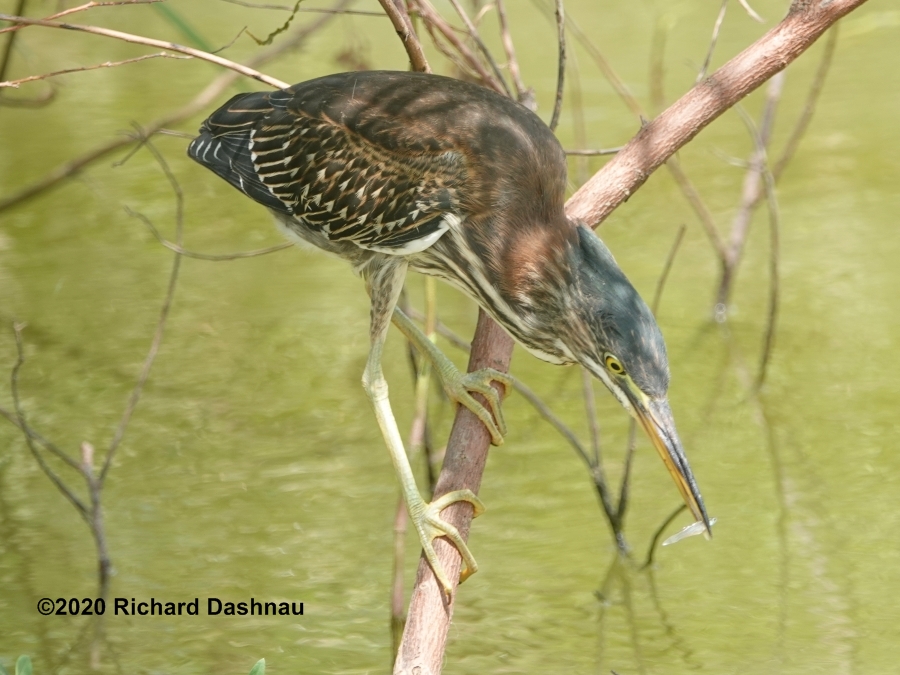
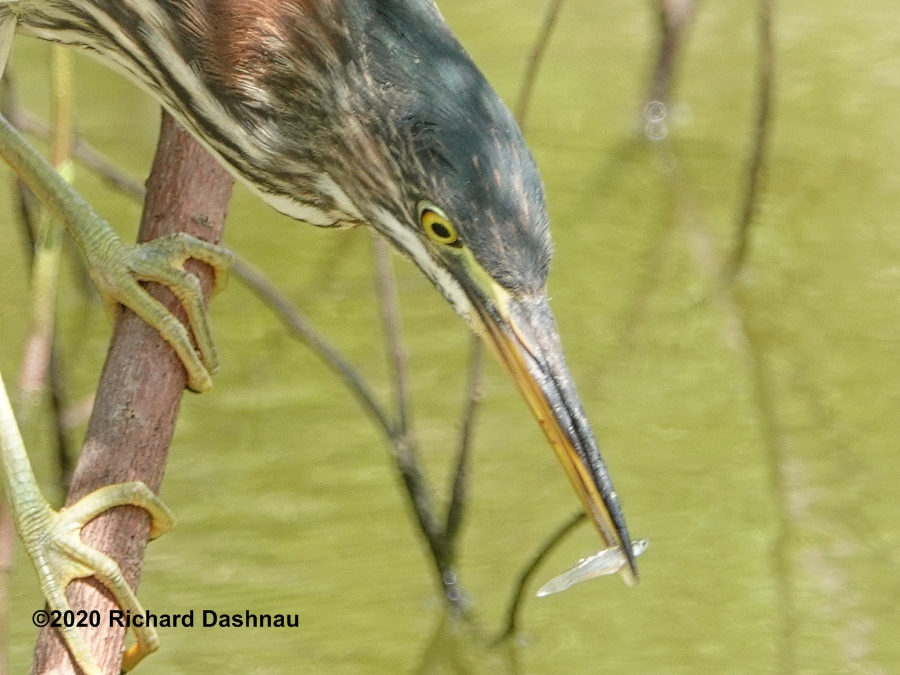
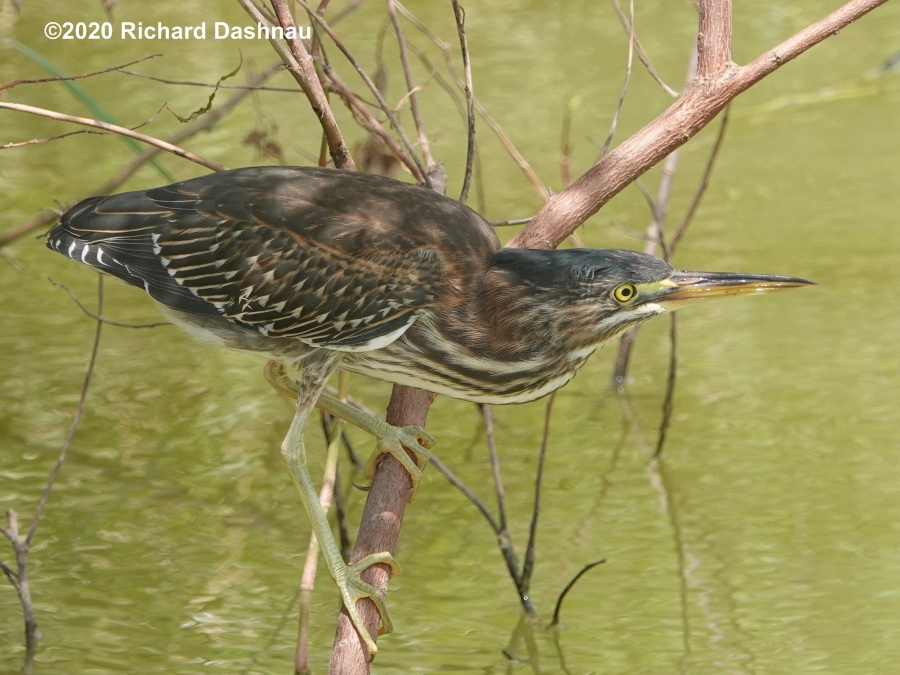
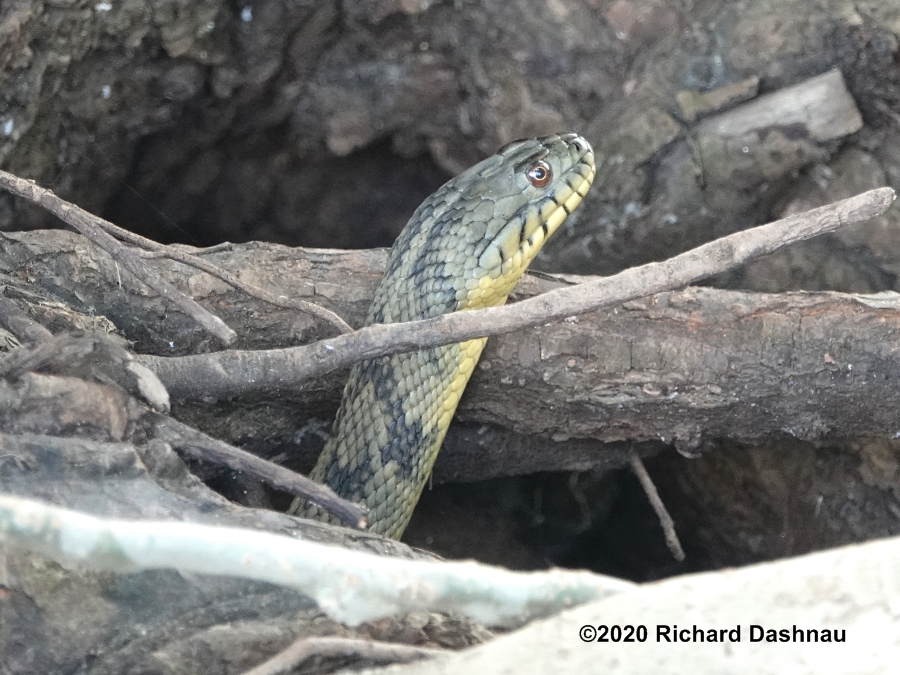
I'm still limiting travel and
following social distancing
guidelines. I don't want to catch the Covid virus, and I
don't
want to spread it. So, visiting a park like this (where I
have to
drive a bit to get
to it) is going to be a rare treat for me.
02/04/2018 . I
was walking along the Spillway Trail with my friends Chris and Elisa,
when Chris called my attention to a Tricolored Heron feeding.
The
heron was hunting the clear "puddles"
in the floating plant growth
there. While it turned and scanned the water-it opened one wing, or the
other, and sometimes both wings-and looked under it for prey.
It was a great demonstration
of an alternative use for a
bird's
wings--aside from flying. I shot some video of this wonderful
behavior (and slowed down a part of it, because I enjoyed watching it),
and pulled some frames from it.
I've also made an animated gif from one movement. The video clip is here(mp4). The
images
and the anigif are just below. If
you'd like to see better images-and see some precise observations
of
nature, visit Chris and Elisa's page-- Two
Shutterbirds.
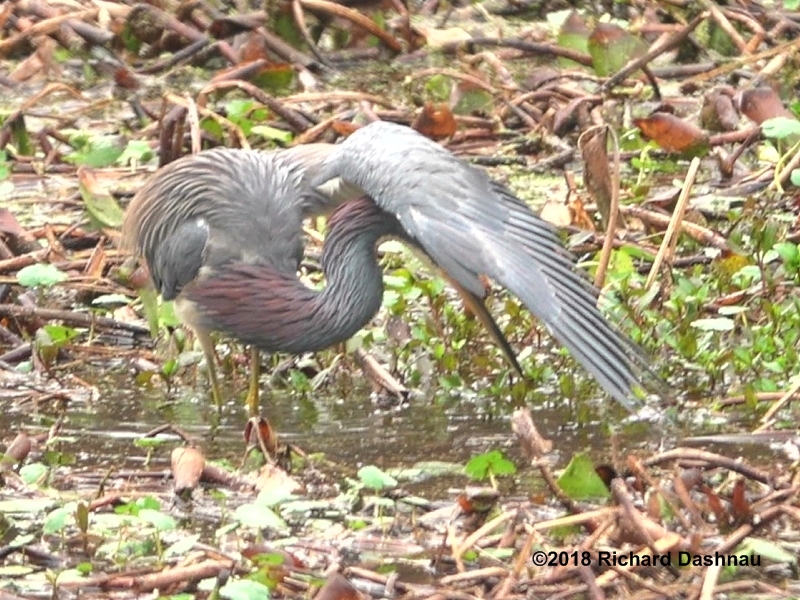
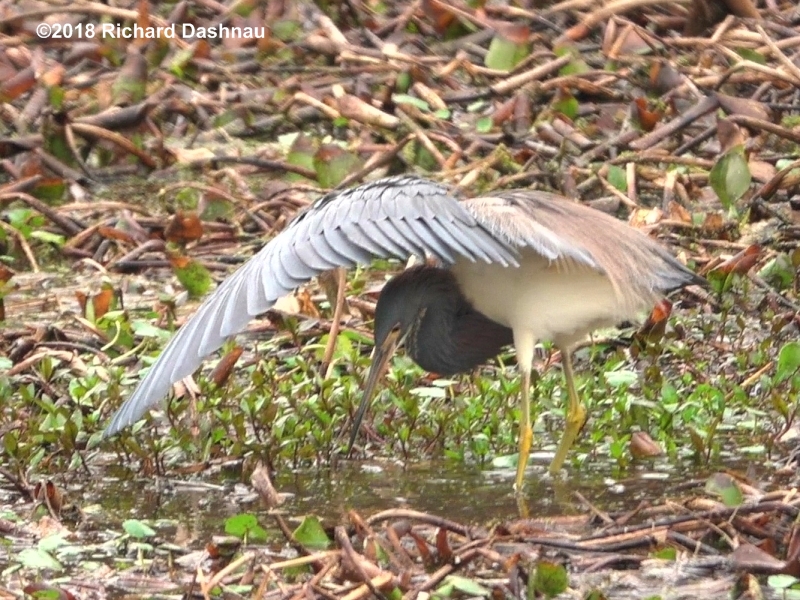
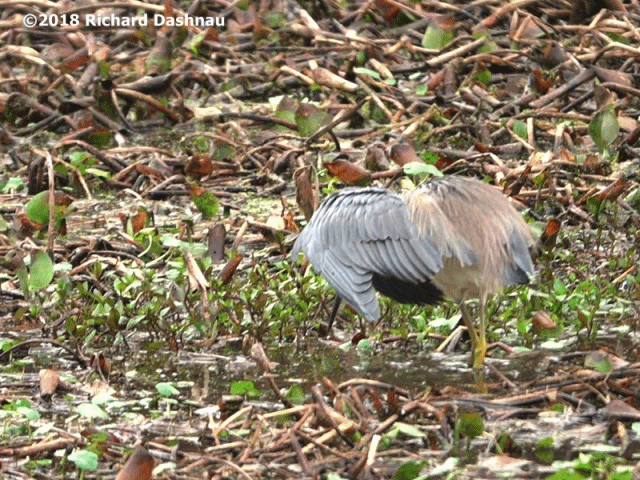
There appears to be a specific terminology for the postures and motions
performed by herons (and, perhaps, other birds). One
list of such terms appears in the my copy of
The Herons Handbook, by
James Hancock and James Kushlan (c)1984. Pages 18 -23 describe feeding
behaviors, and those used by Tricolored Herons are on page 106.
If that book isn't
available to you, then there is a list online
published in 2011 by James Kushlan:
The Terminology of Courtship, Nesting, Feeding and Maintenance in
Herons James A. Kushlan
That link is here: http://www.heronconservation.org/resources/Behavior_Terminology.pdf
In my opinion, although the list may give names to the behaviors, the purpose for each
of them can change with the context of the moment, or even in
combination with other behaviors or
movements. In this brief instance,
the heron is obviously hunting, and most of its thrusts are under its
wings. Compared with an earlier
video(wmv)
I filmed, the hunting strategy and use of the
open wings seems a bit
different in that earlier example--with no thrusts under the wings, and
with the head not going under the wings.
At first I had thought that that
heron was trying to cut
glare off the surface
of the water, and it might be, but I also think that the heron is using
its wings to herd prey or scare prey into movement.
3/06/2016
( I was on the Spillway Bridge
watching a
Tricolored Heron fishing there. I was able to move behind the
Heron without scaring it, so I was able to "look over
its
shoulder" with the camera (shooting video at 210fps) as it fished. I
captured a wonderful video clip showing the moment a fish (possibly a
small Bass) flashed in the water. This caught
the
Heron's attention,
and the fish (which had probably just eaten) became prey for the heron.
The images below are framegrabs from the video clip, which can be seen here(mp4).
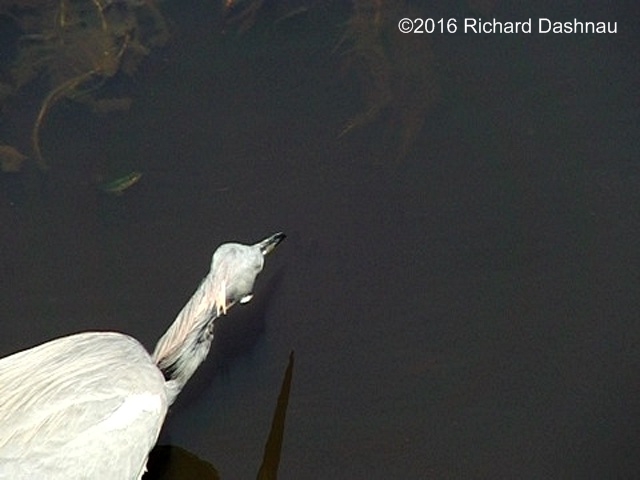
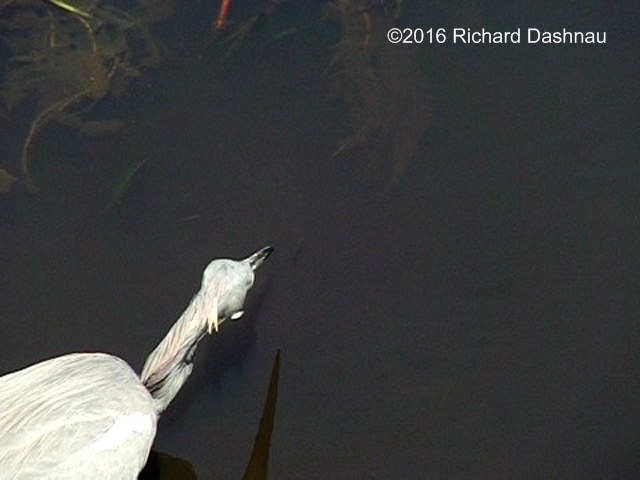
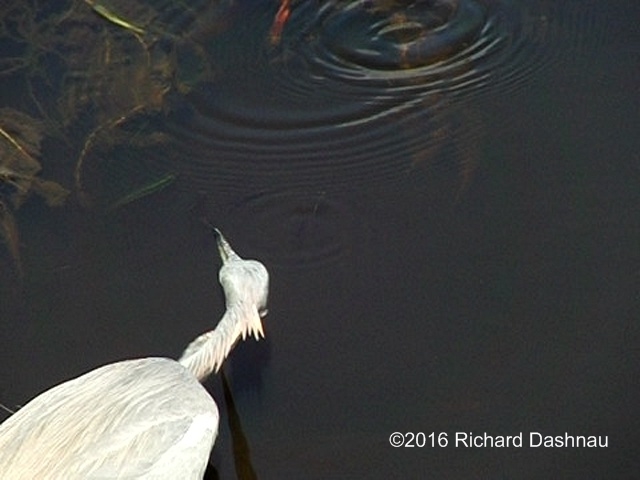
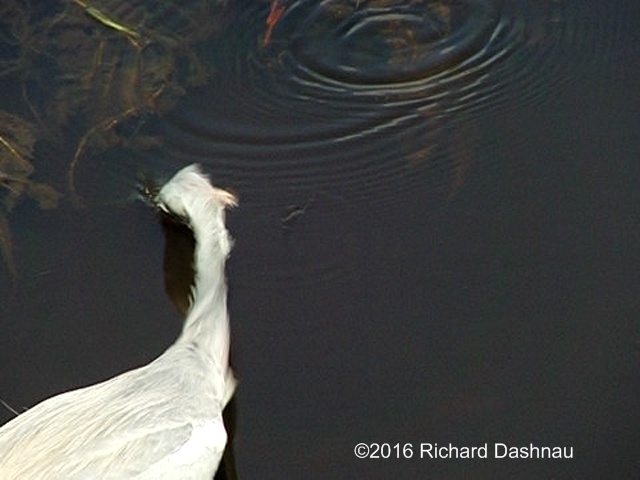
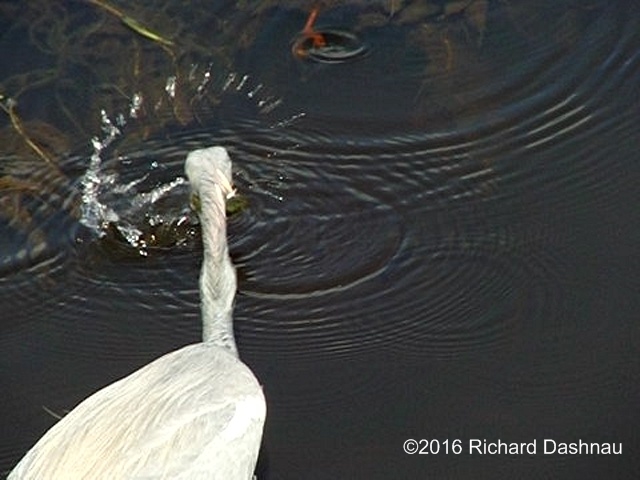
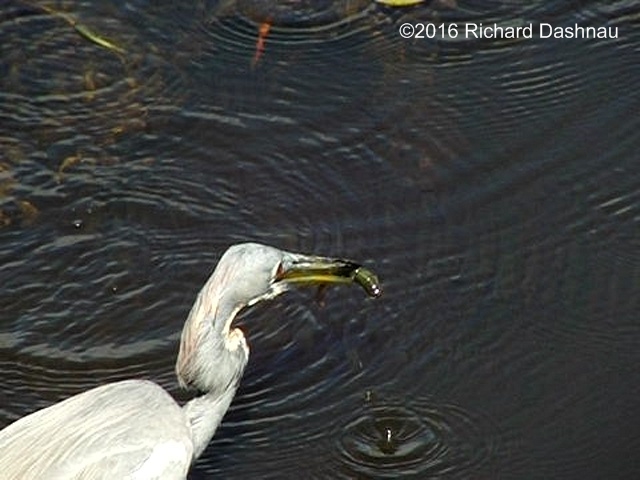
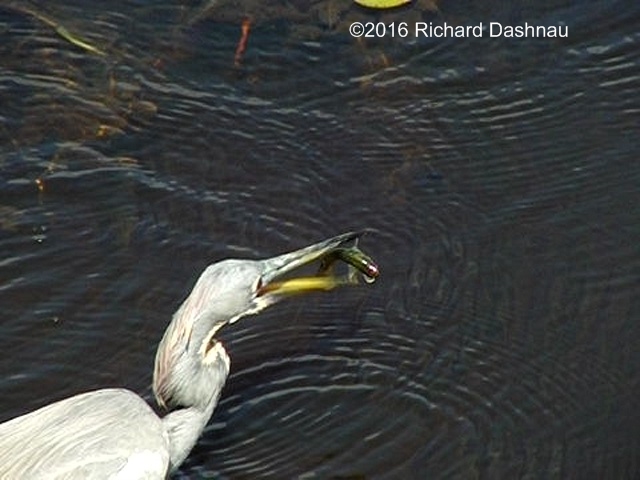
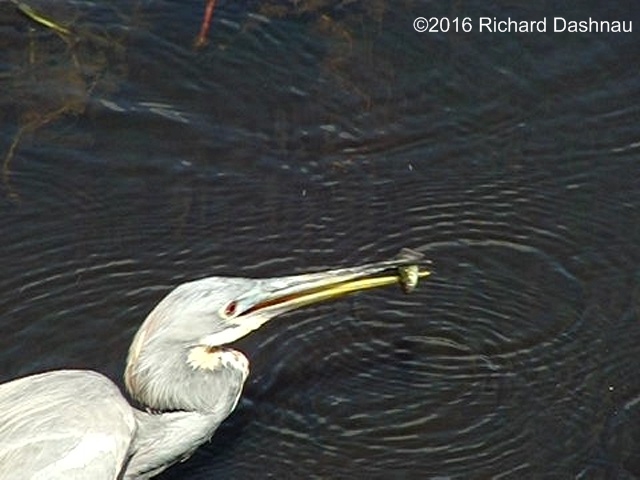
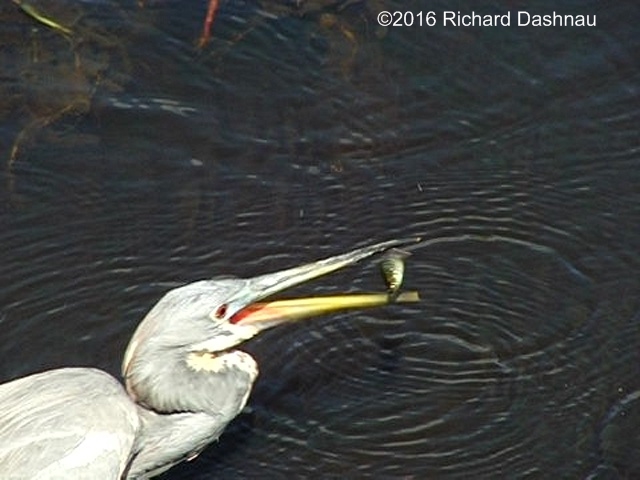
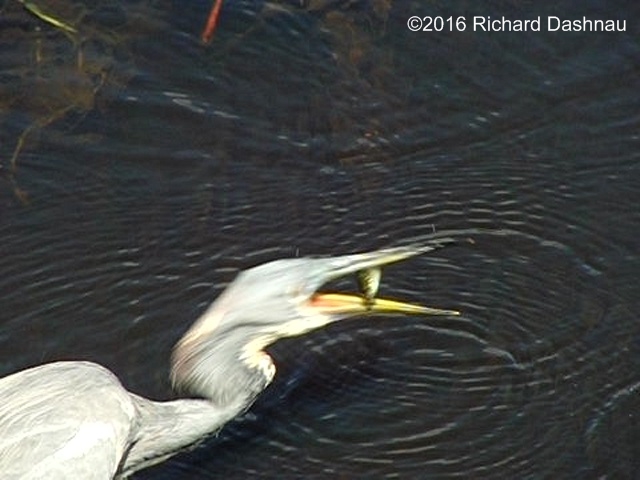
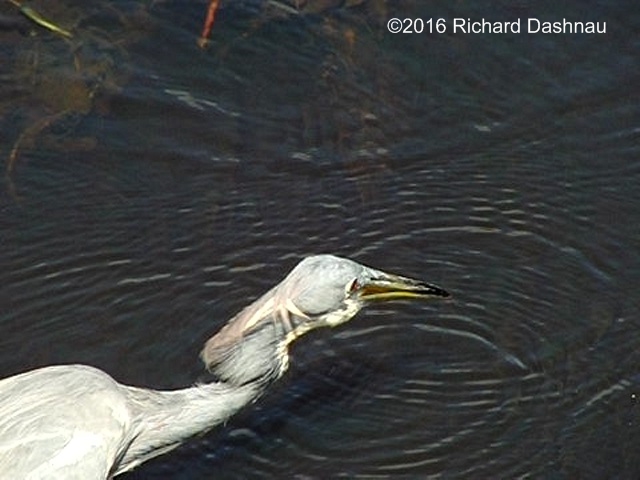
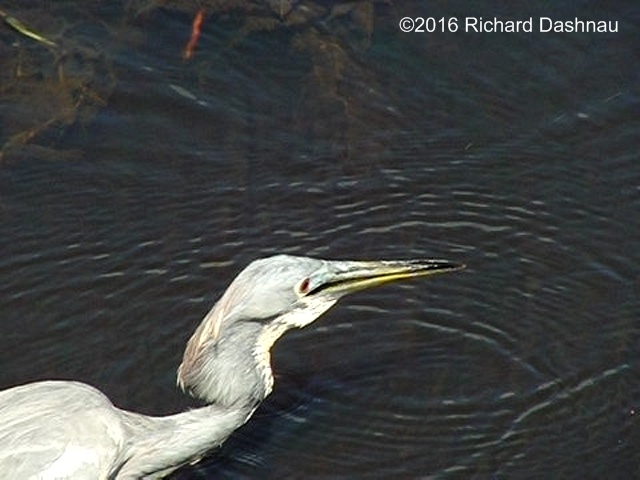
April
22, 2012-- Today
I had to stay in and around the Nature Center. I was able to spend time
on the trails in the morning. Then I returned for a couple hours in the
afternoon.
I was able to see some more of our aquatic birds
hunting. First, I watched as a Green Heron perched on a
vertical
twig. That seemed difficult enough, but then it caught, subdued,
and
swallowed a small Bowfin (Amia calva). It seems to me that the Green
Heron is perhaps the most acrobatic heron. The images below are from
the video
clip (mp4)
that I shot today.
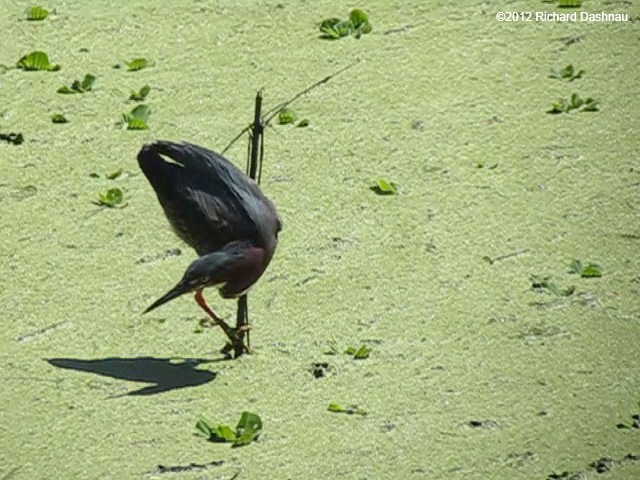 -
-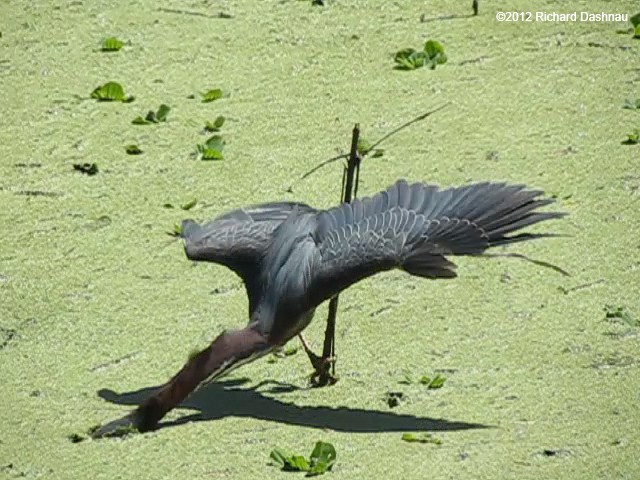 -
-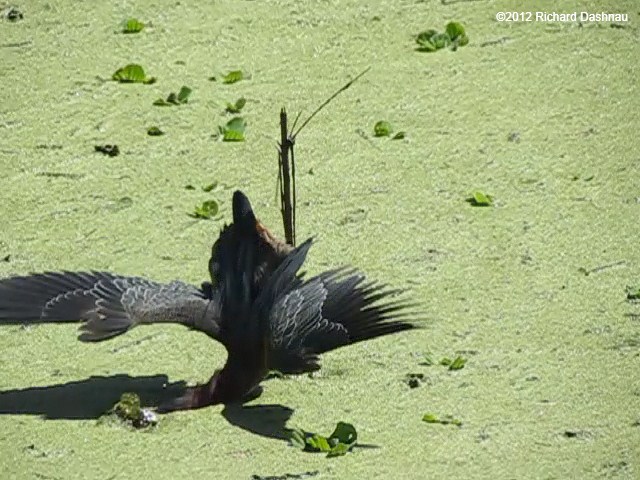 -
-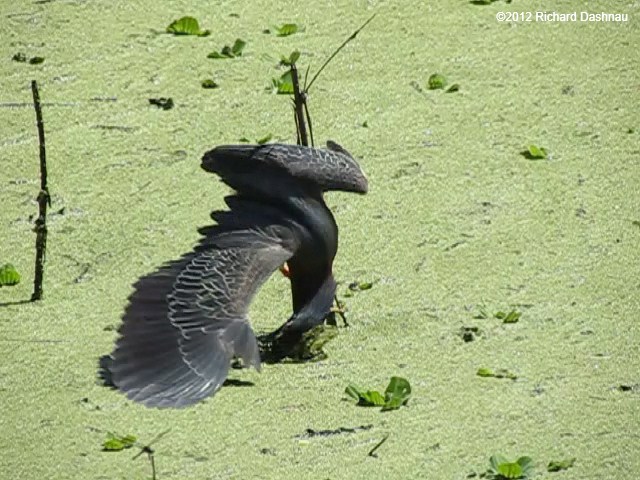
-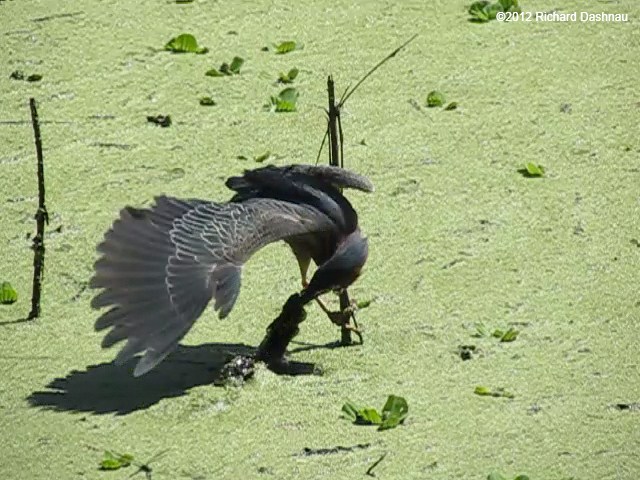 -
-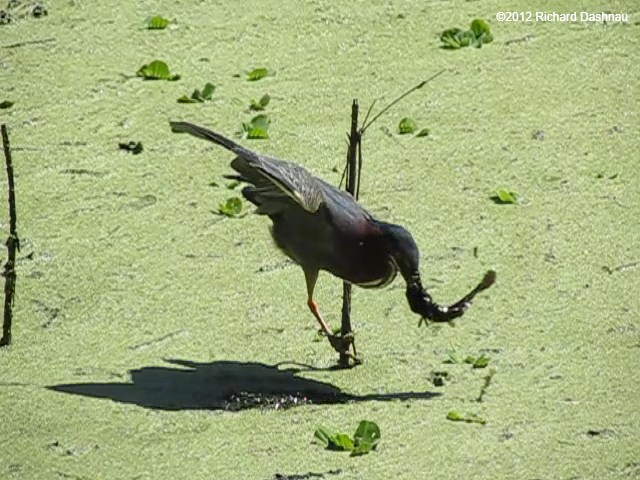 -
-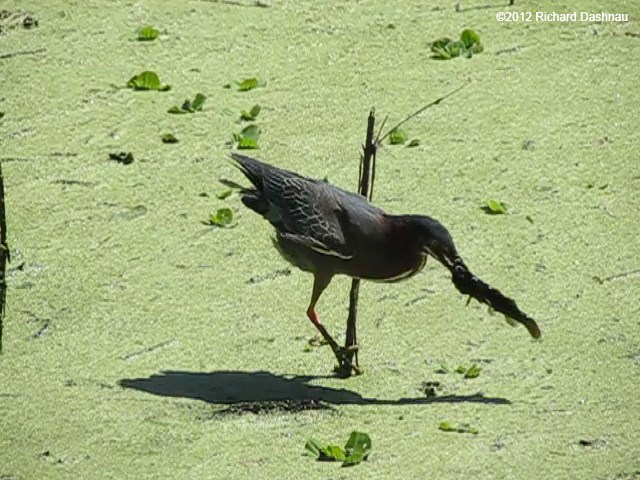 -
-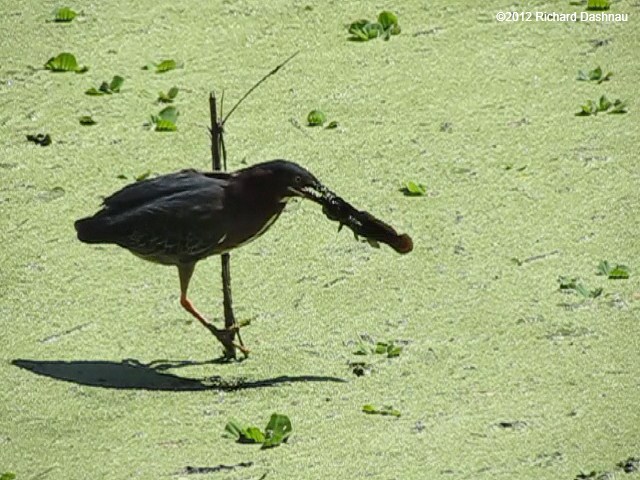
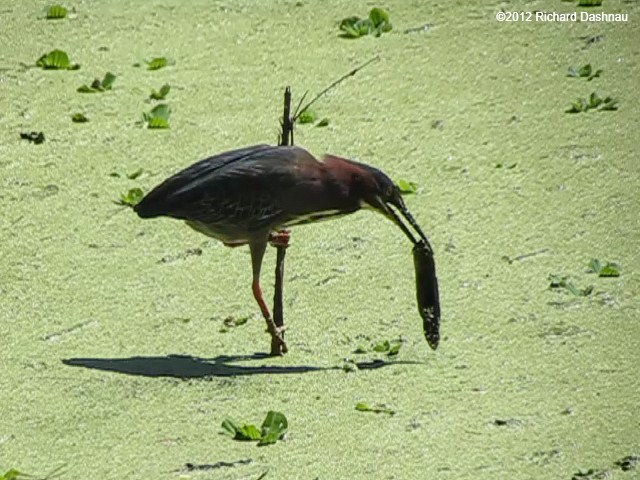 -
-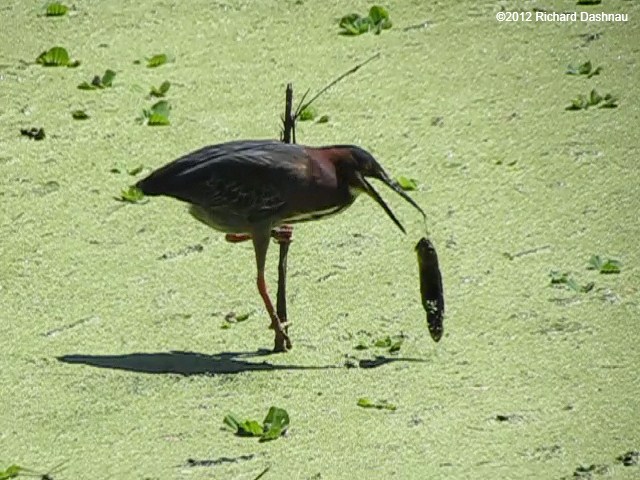 -
-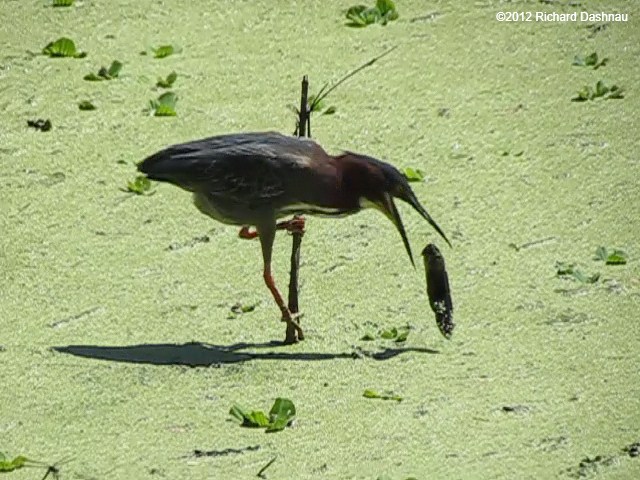 --
--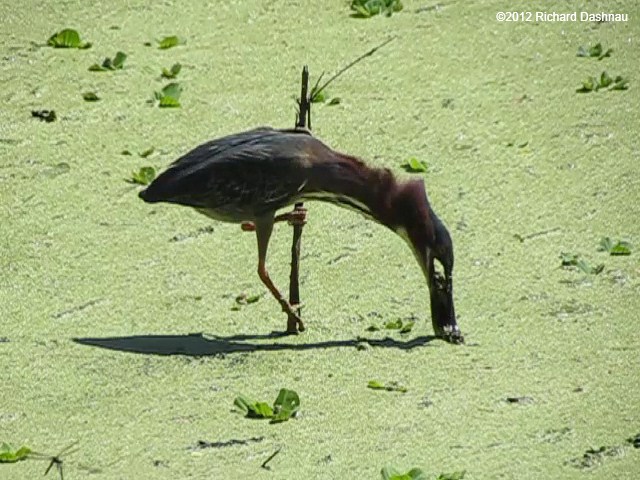
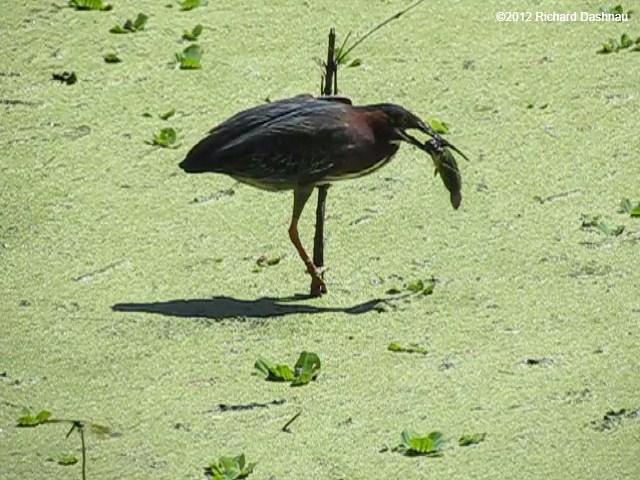 --
--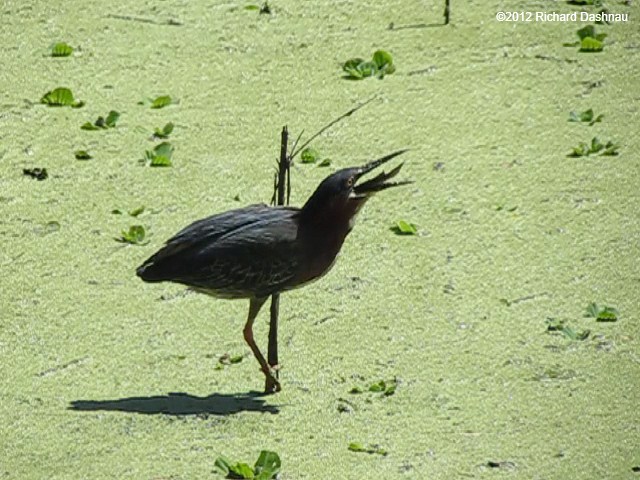 --
--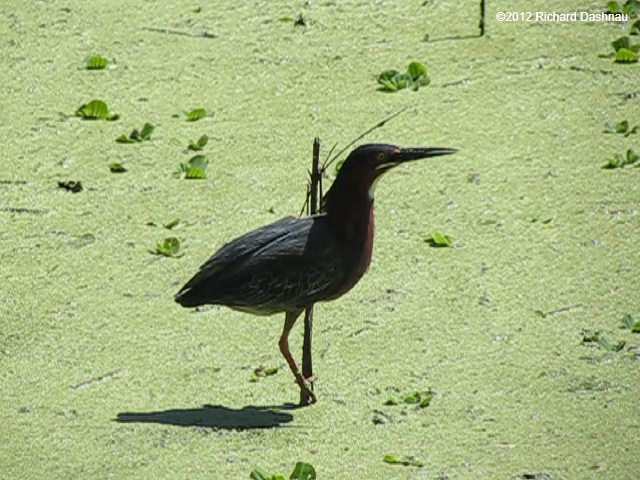
If that isn't acrobatic enough, there's a Green Heron in another video
clip (linked below)
that I shot on 08/01/2010.
Sometimes their
hunting behavior is pretty amazing--enough so that when we describe it
to park visitors, the visitors look
at us like we are making it
up. For instance--the Green Heron will sometimes use bait
while
fishing. That is, it will take something interesting (in my experience,
an insect), and place
it in the water. After this, it watches the
insect as it drifts. If the insect drifts close, it will carefully pick
up the insect, and place it further out. The heron is watching the
insect,
but also watching for any fish that come up to take the insect. When
one does....FISH DINNER!
April
15, 2012-- Today
was a rather quiet day at the park, with the intermittent sun and
blustery winds seeming to keep our animals subdued. However, there were
a few interesting things
to see in the morning before I came in to
do the Creekfield Hike. After some time in the Nature Center,
I
decided to go out to look around again. About 3 o'clock, dark clouds
off to the West
made me hurriedly bike back towards my car. I
was still near 40 Acre lake, when I saw a Black Crowned Night Heron
atop a vertical piece of wood, close to the trail. I stopped to take a
picture
or two, and it didn't fly away.
Some
of us have seen birds at the park fishing and hunting. Sometimes their
hunting behavior is pretty amazing--enough so that when we describe it
to park visitors, the visitors look
at us like we are making it
up. For instance--the Green Heron will sometimes use bait
while
fishing. That is, it will take something interesting (in my experience,
an insect), and place
it in the water. After this, it watches the
insect as it drifts. If the insect drifts close, it will carefully pick
up the insect, and place it further out. The heron is watching the
insect,
but also watching for any fish that come up to take the insect. When
one does....FISH DINNER! I've got pictures and small
video clips on this page showing a Green Heron using bait in this
manner.
Some
quick research will show that Black-Crowned Night Herons have also
fished this way. But--they also use a variation. Sometimes--if one is
lucky--it is possible to see these Night-Herons
performing a very
odd activity. They will very carefully dip just the tip of
their
open beak into the water--and sort of "flutter" it. That is, they make
tiny quick movements that bring the top and
bottom towards each
other. I've filmed them doing it before, and it was only after some
conversations with folks like Bill, David, and Greg that I learned that
the Black-Crowned Night Herons
are also fishing; but they
are using their beaks as lures! Go ahead and laugh. It sounds
incredible. My Sibley's Guide to Bird
Life and Behavior doesn't mention this
particular strategy, but
there is some mention of it elsewhere on the
Internet. And
then with that sparse reference...there is what I saw. After I took my
few pictures, the Black Crowned Night Heron started fishing.
And I
started filming at 120 frames per second. And I caught
something quite amazing. The images on this page are frame
grabs
from the video clip, which can be seen here:
video
clip (mp4).
The Park Superintendent has identified the fish as a
Warmouth Bass. Information on the bass can be found at
the TPWD site here:
http://www.tpwd.state.tx.us/huntwild/wild/species/war/
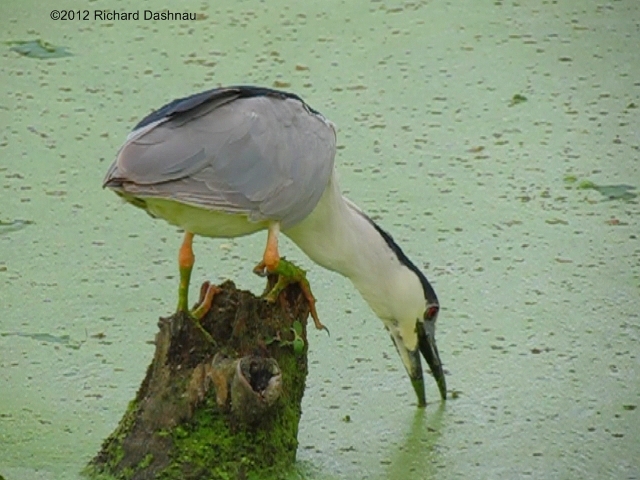 -
-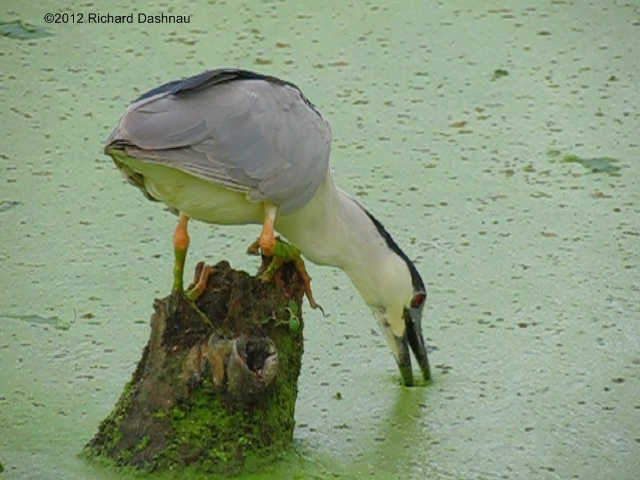 -
-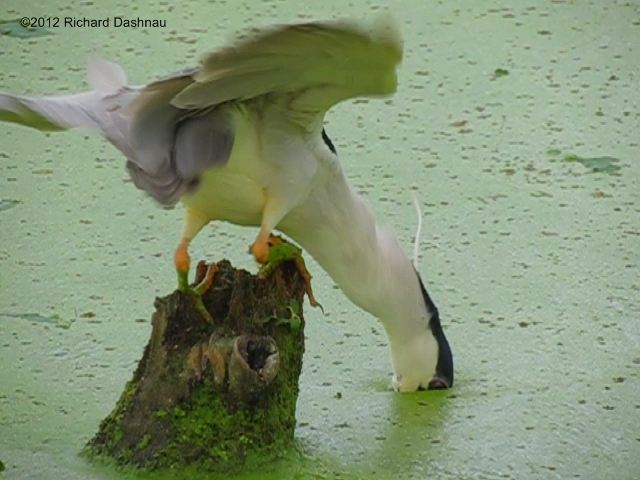 --
--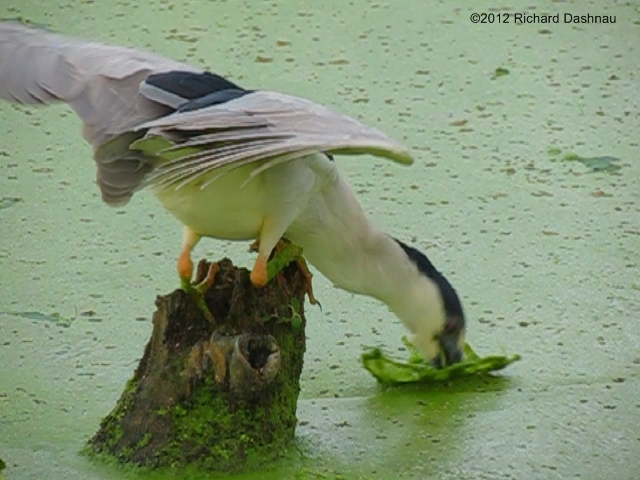
FLUTTERING
THE BEAK TIPS
SOMETHING
GRABS THE LOWER JAW!
THE HERON LUNGES
THE HERON GRABS!
--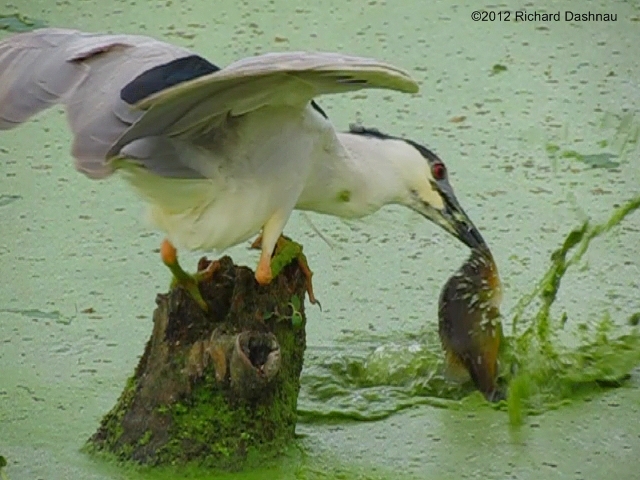 --
--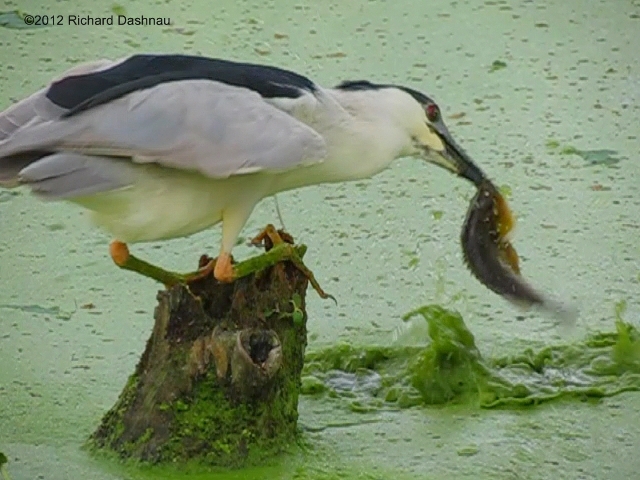 --
--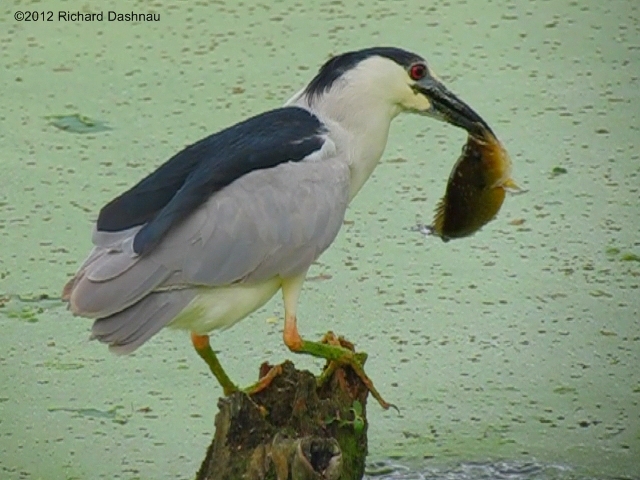
THE HERON PULLS!
WOW!
THAT'S A BIG ONE!
NOW WHAT DO I DO?
August
01, 2010-- (posted
here 09/04/2020) I
watched a Green Heron hunting from a branch above the surface of the
water. When I saw it focus on something, I started filming
at 210 fps. I got video showing a very nice full-extension
grab into the water. The following link will bring
you to the video
clip (mp4). The images below are frame grabs from the video.
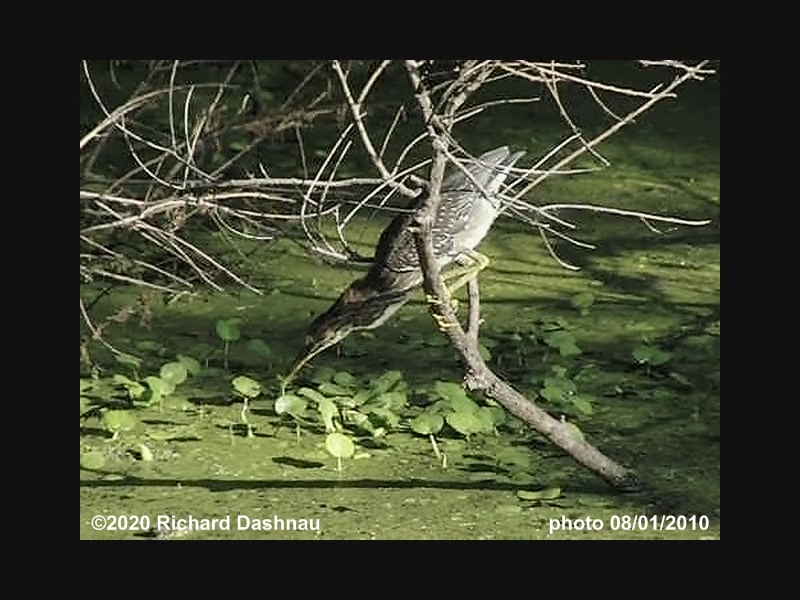 -
-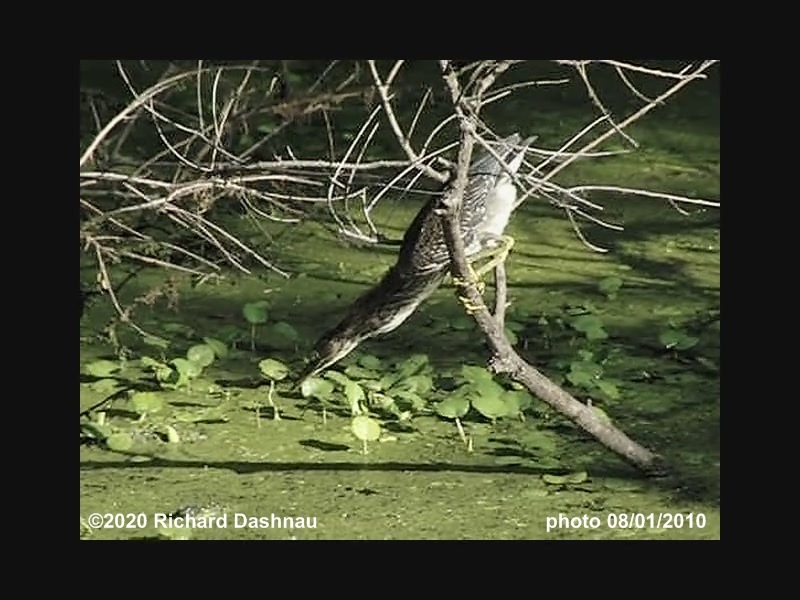 -
-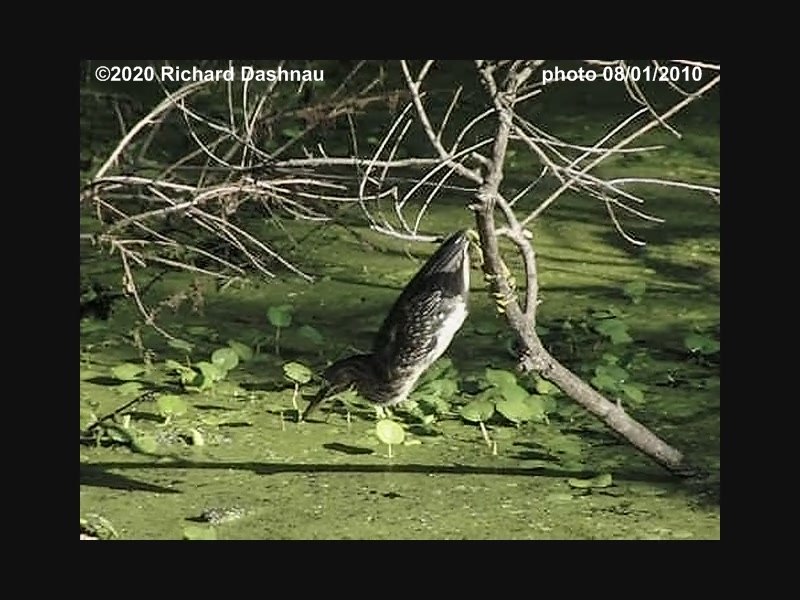 -
-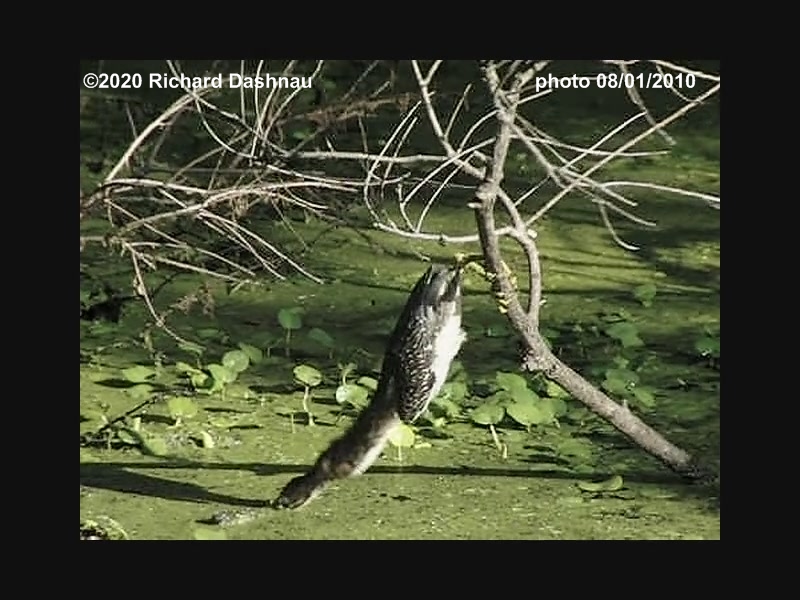
-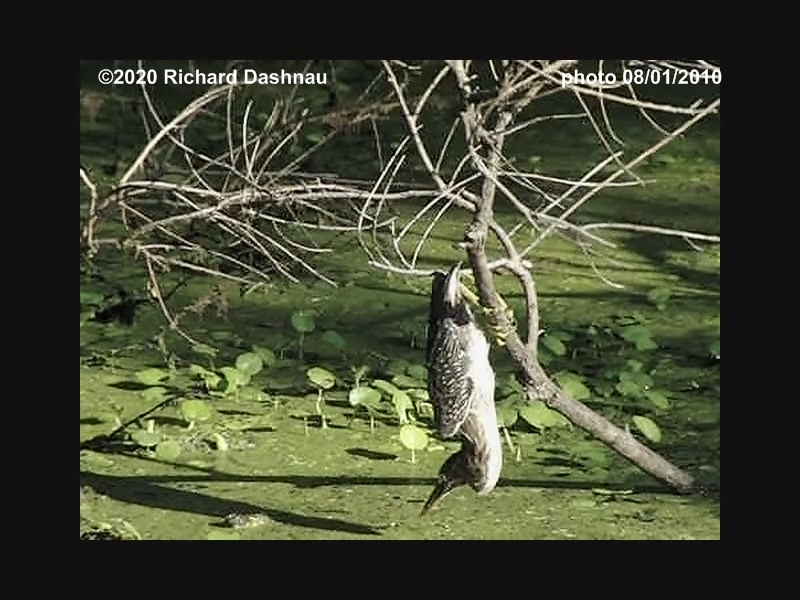 -
-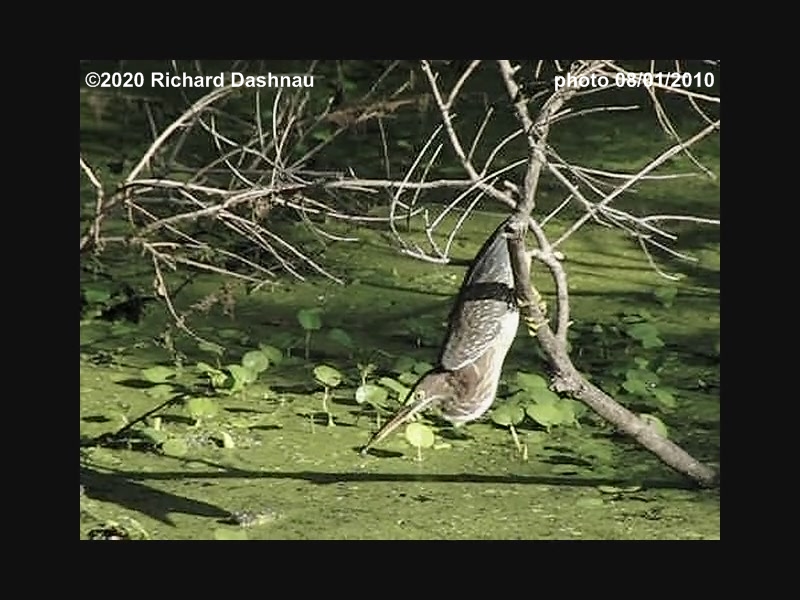 -
-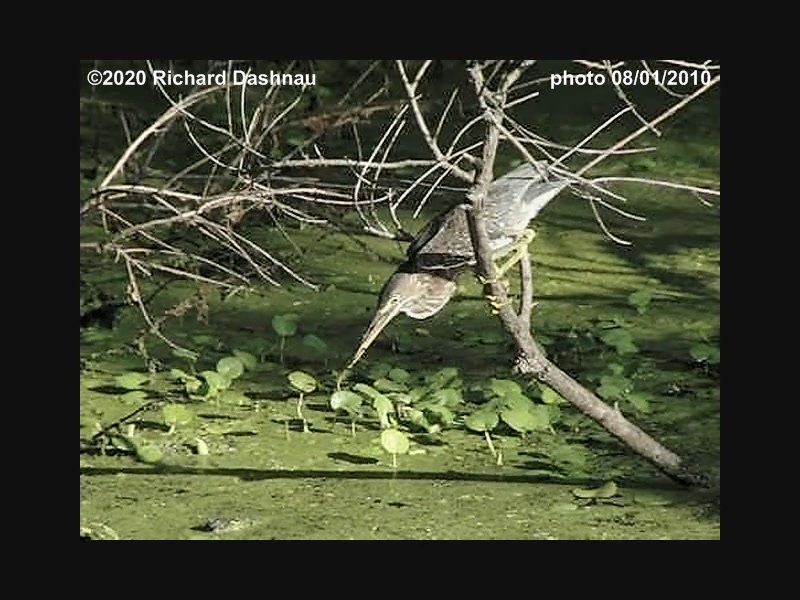 -
-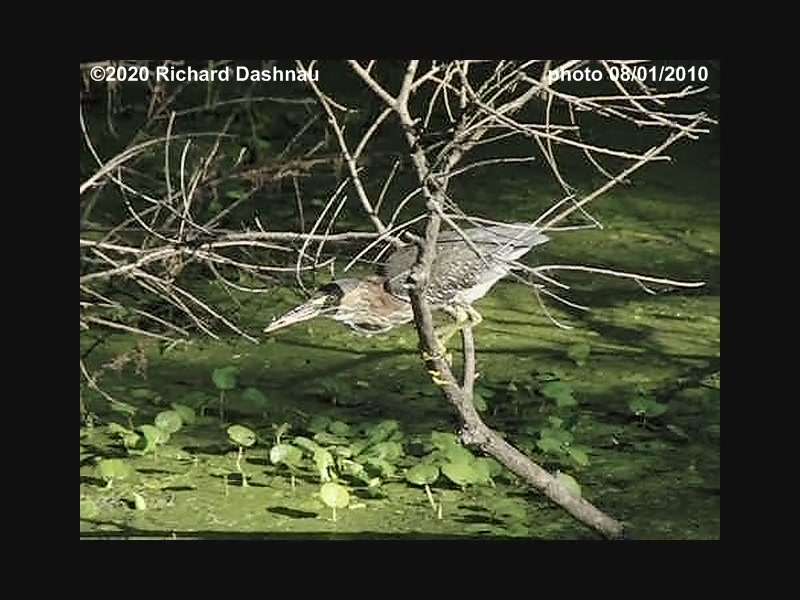
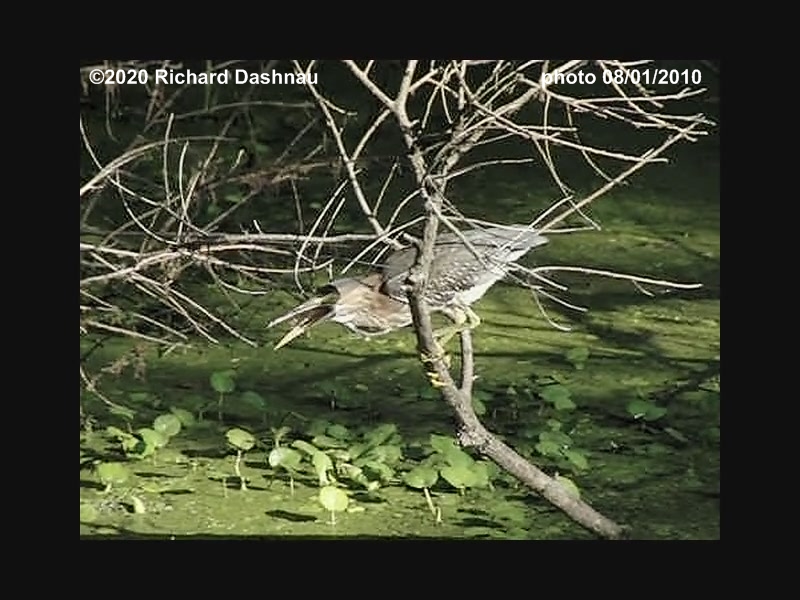 -
-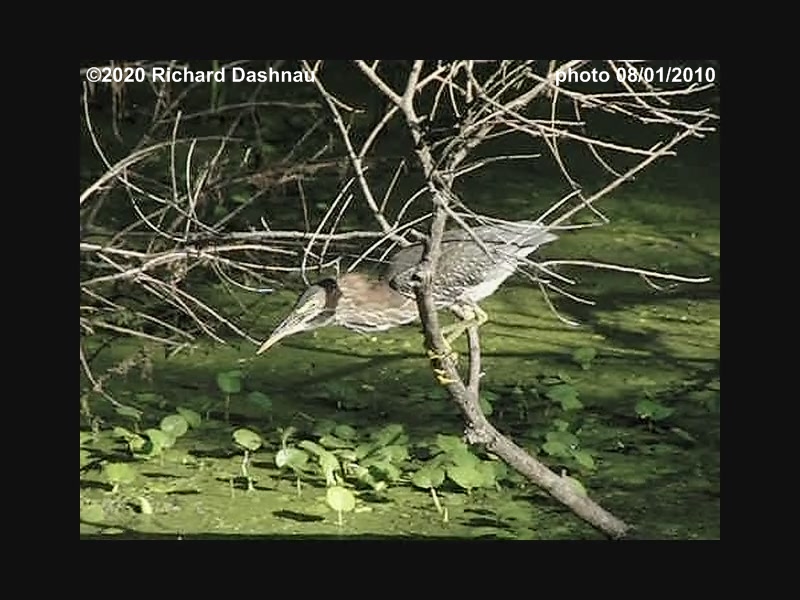
May
16 and May 30,
2010.
If you have been walking the trails at Brazos Bend State
Park, then you
may have noticed crawfish claws (and sometimes legs) lying around the
trails.
In most cases, just the claws are there. A single pair might not cause
much comment, but when there are claws scattered in many places, then
it
becomes mysterious. After all,
where is the the rest of the crawfish?
Many
of us at the park know that the culprits behind the mystery are various
wading birds, and mostly Yellow-Crowned Night Herons.
Today's
RICKUBISCAM
is a full head view of one of them.
While
I'm out on the trails, I like to point out the discarded claws to park
visitors, and then let them guess why they're there. And then I usually
blame the Night Herons. However, I've
never really had a good mental
image
of *how* the Herons remove the claws. Over the last few weeks, I shot
some
high speed video that cleared it up for me. It appears that
the
Herons
use inertia to de-claw the crawfish.
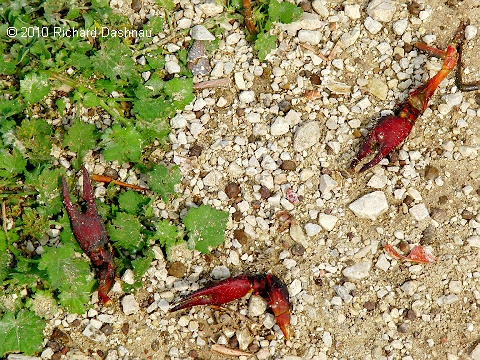 --
--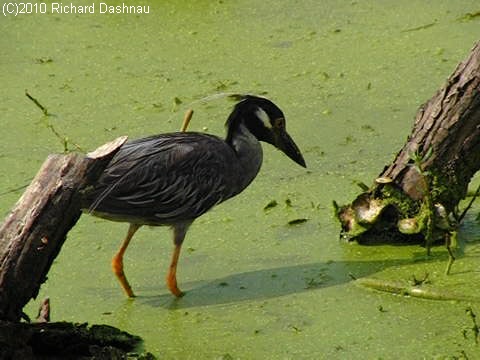 --
--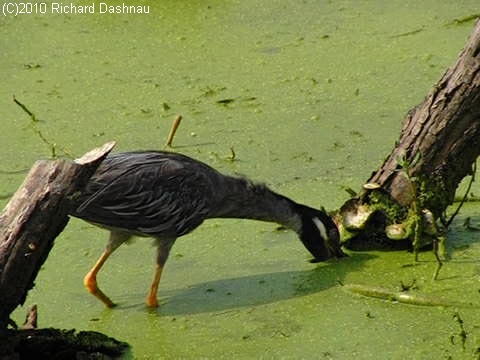 --
--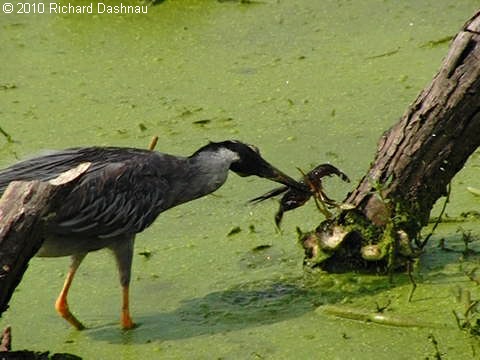
CLAWS ON TRAIL
READY TO STRIKE
THE GRAB
GOT ONE!
I've
edited together and posted the video online. Images here are frame
grabs
from the video. When a Heron captures a crawfish, it immediately twists
its head from side to site
very quickly. This is not like shaking its
head
from side-to-side (as if saying "no"); but similar to a motion it might
do if it was trying to "drill" with its beak. Centrifugal force causes
the limbs (and especially the heavier claws) to straighten from the
body
(this appears to have the added benefit of preventing the crawfish from
grabbing the Heron). And the link
to the video is here: Yellow-Crowned
Night Herons with Crawfish (mp4. 151 mb)
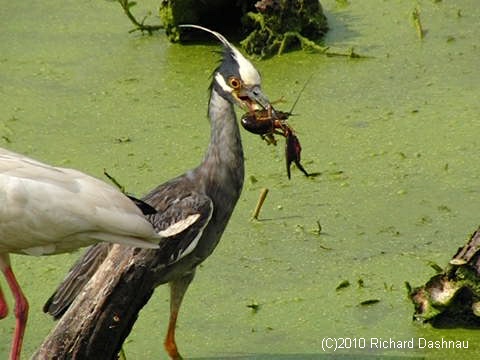 --
--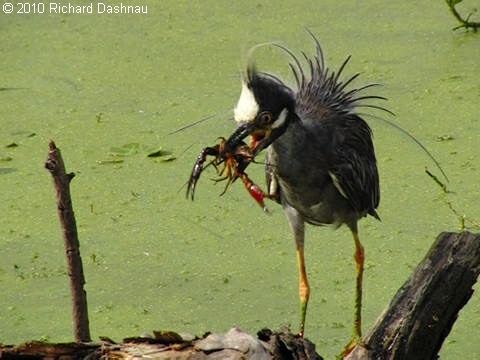 --
--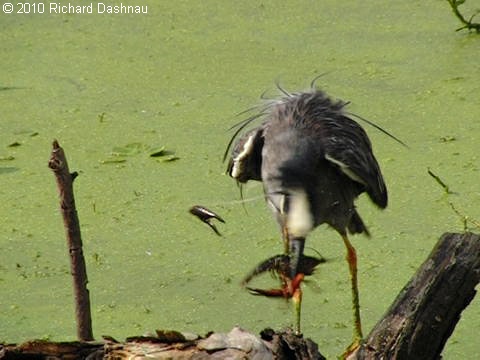 --
--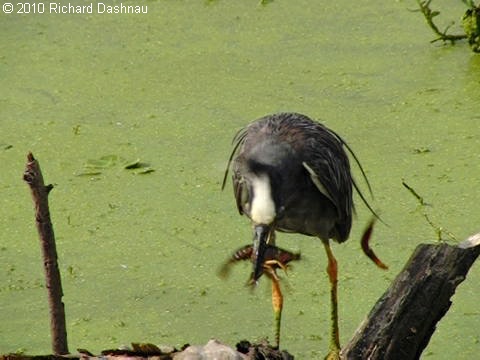
PASSING IBIS
DON'T MESS
WITH MY FOOD!
ONE CLAW FLIES
THE OTHER CLAW
FLIES
Along
with repositioning of the crawfish for a better leverage against the
joints
as they spin, the claws sometimes just break off. An alternate method
(in
the first part of my video)
has the Heron grabbing a claw, the "arm",
and
twisting while holding *that*, with the weight of the crawfish working
on the joint. Eventually, one claw after another is broken off and
discarded.
Sometimes groups of the legs are grabbed, and then hyperextened by the
weight of the crawfish's body using the same twisting motion. These
break
off and are also
discarded. And so, there's video proof of
one of
our minor mysteries--solved.
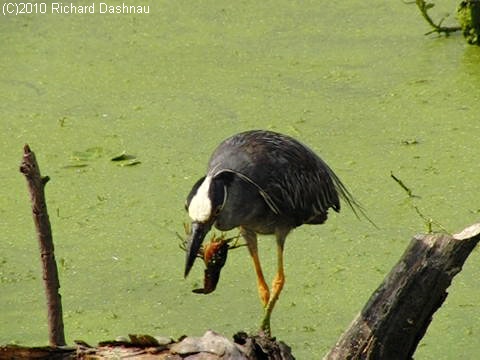 --
--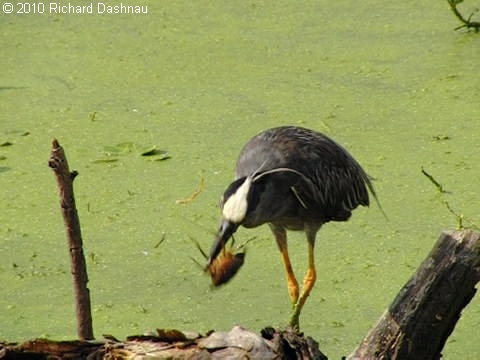 --
--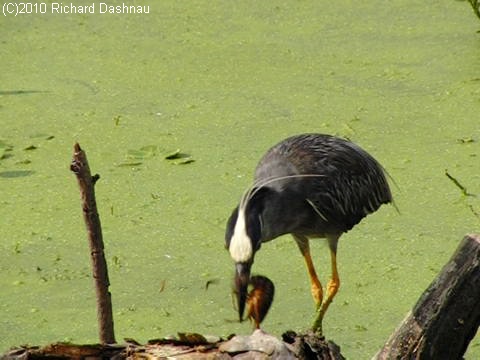 --
--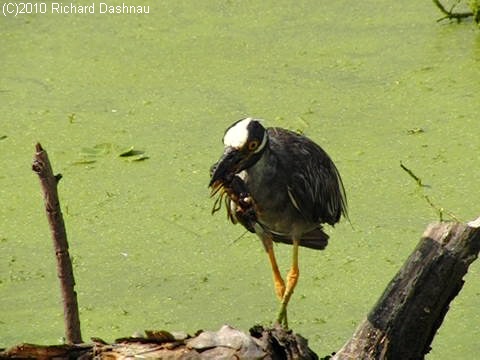
GRAB THE LEGS
SOME LEGS FLY
MORE LEGS FLY
ALMOST READY
TO EAT
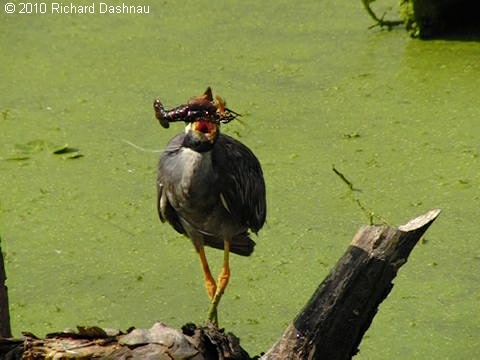 --
--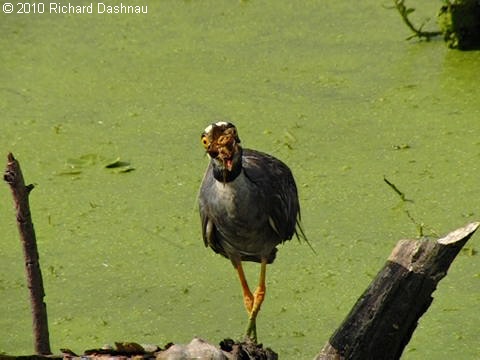 --
--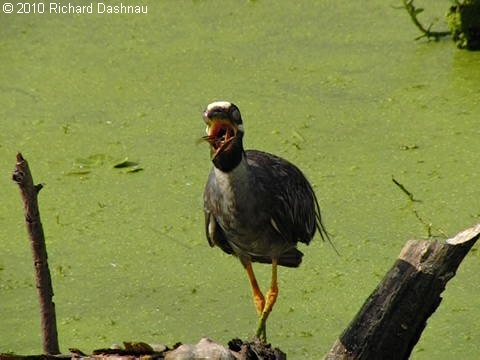 --
--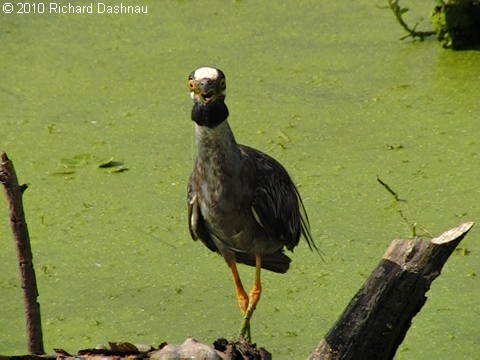
FOOD TOSS
BEAKFUL
TENDERIZED
ONE BIG GULP
THAT WAS GOOD!
The
Heron doesn't always win, though. The
images below are frame
grabs from another clip. The Night Heron grabbed the crawfish and
immediately
dropped it. The crawfish
submerged, and the Heron never touched that
one
again. What happened? I looks like the crawfish grabbed the Heron's
bottom
jaw. This made the Heron let go.It didn't bother that
crawfish again,
but
it went hunting for others.
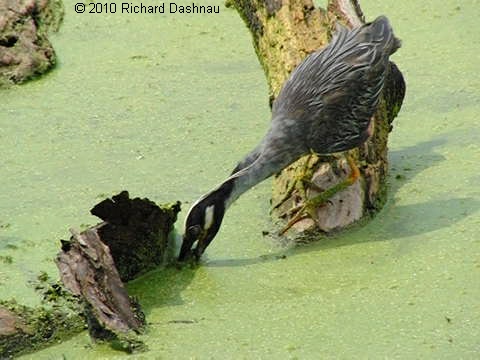 --
--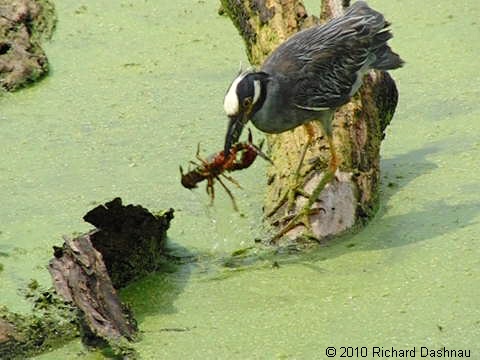 --
--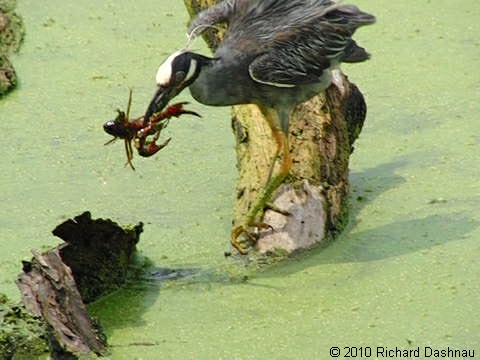 --
--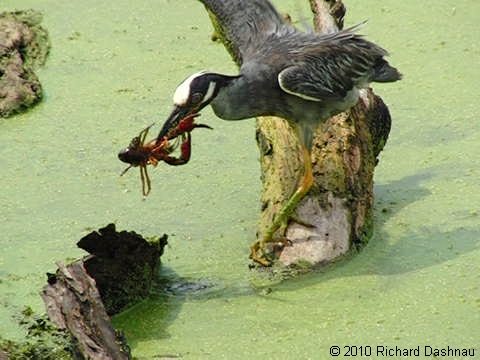
THRUST!
CAUGHT A BIG
ONE!
TOSS AND GRAB
PINCH!!
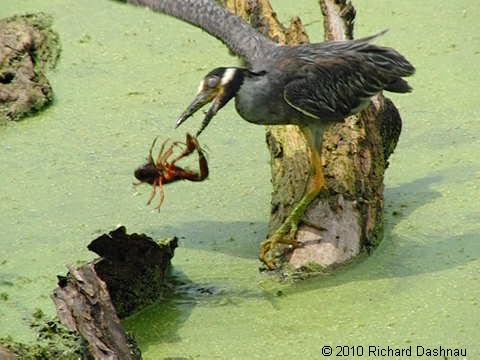 --
--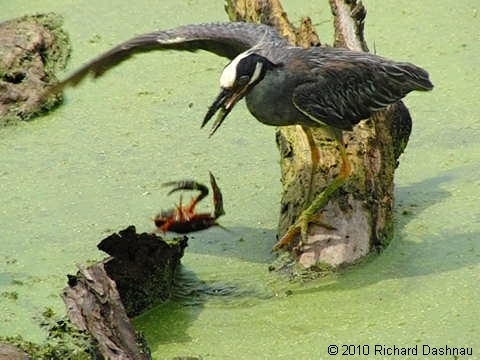 --
--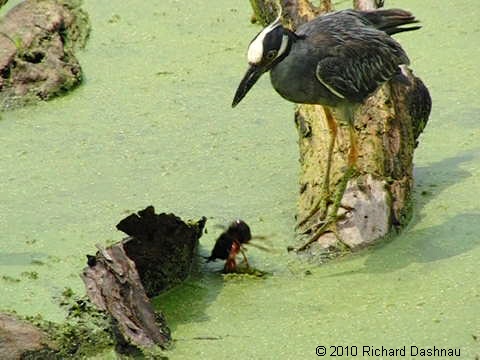 --
--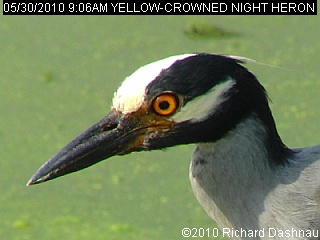
OUCH! THAT
HURT!
THERE IT GOES
IT'S
FREE!
the RICKUBISCAM shot
Here's
an additional note for those who see this and are living outside of
Texas:
crawfish = crayfish. (Potay-to Po-TAH-to) Also, these are
"red swamp
crawfish"
--procambarus clarkii--and
YES they are that
big, and can get even bigger. They are pretty amazing animals. I've
read
that they can reproduce parthenogenically; that they can
actually come
in different colors (including blue); and that they have become an
invasive
destructive species in some countries--partly because of their habit of
burrowing. They can
also make thick mud chimneys and dig deep burrows.
They are the crawfish that are usually cooked and served in restaurants
down here (and probably elsewhere).
03/29/2009--
(update 9/10/2016)Here is a Tricolored Heron that I watched as it
fished in 40 Acre Lake near the Observation Tower. These are
frame grabs from the video clip I
have here(mp4).
I shot the video at high frame rate to play in slow-motion.
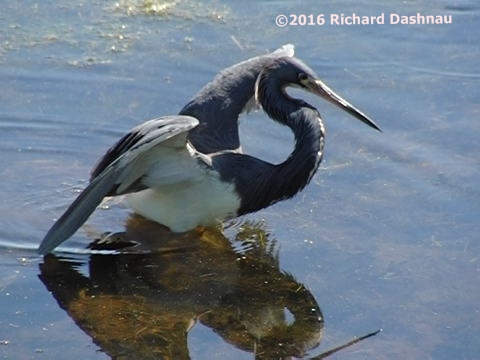 --
--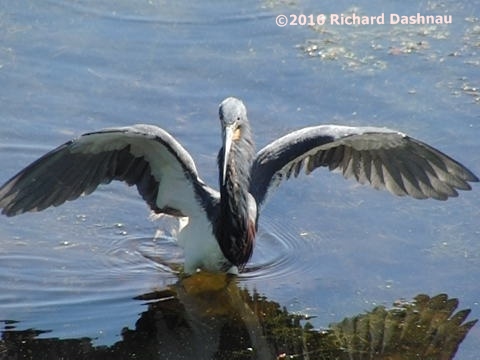 --
--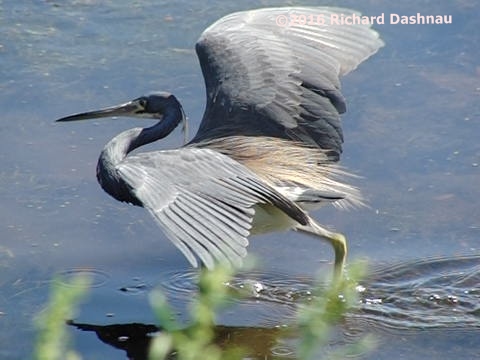 --
--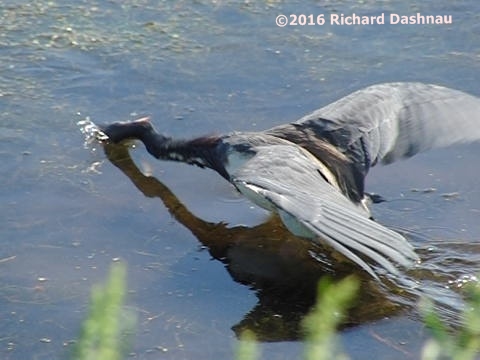
When
I first saw the heron walking with its wings open, I had thought it was
trying to produce shade--to allow it to see through the glare at the
surface of the water. But I've read that
herons also spread
their
wings like this to scare or herd fish. Since the heron is
striking so far ahead, that's what I think it is doing here--herding or
spooking fish to flush them from
cover.
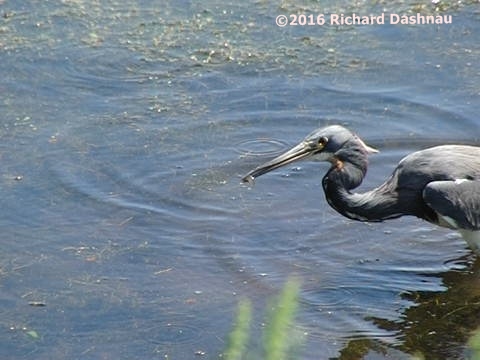 --
--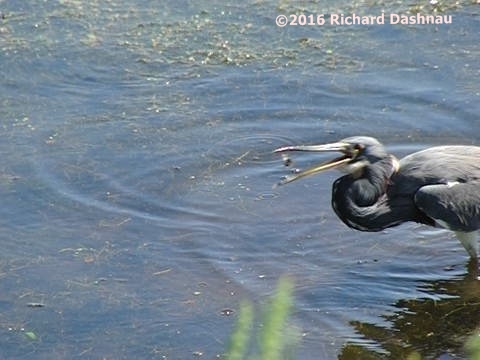 --
--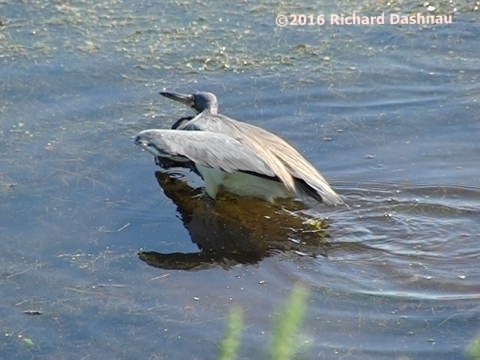 --
--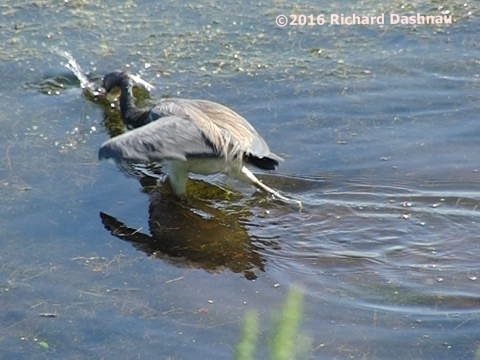
The
first lunge was successful, and the heron swiftly tossed and swallowed
the minnow. Then, it saw another, and caught that one, too.
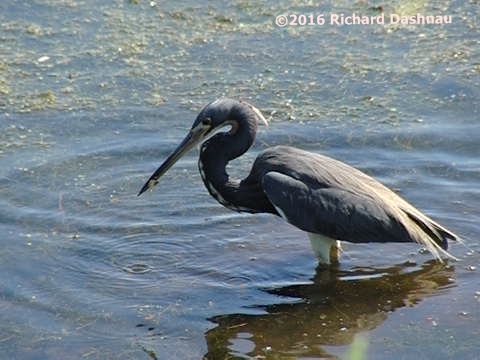 --
--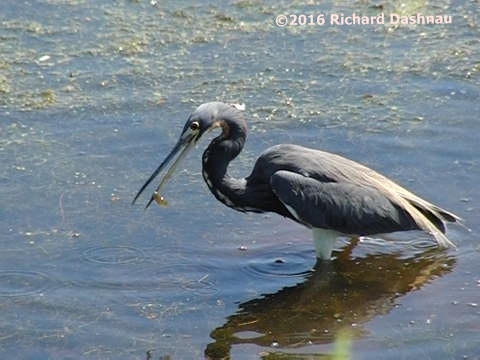 --
--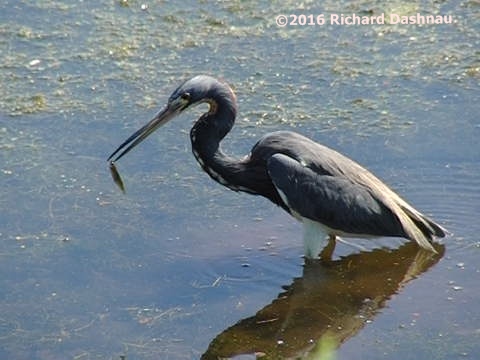 --
--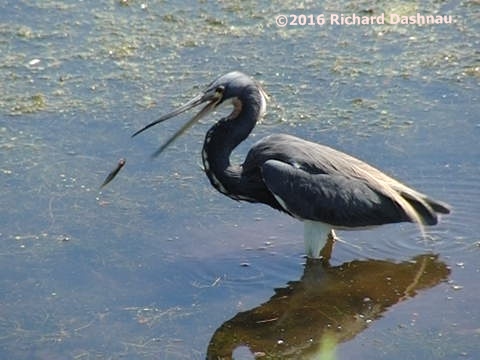
After
the second successful catch, the fish had been impaled some distance
from the end of the heron's bill. It took a little effort to work the
fish back down to the end of its beak,
so the heron could swallow it.
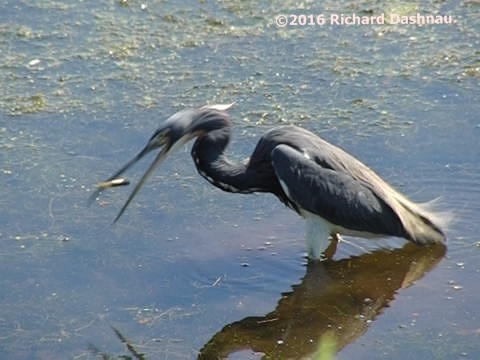 --
--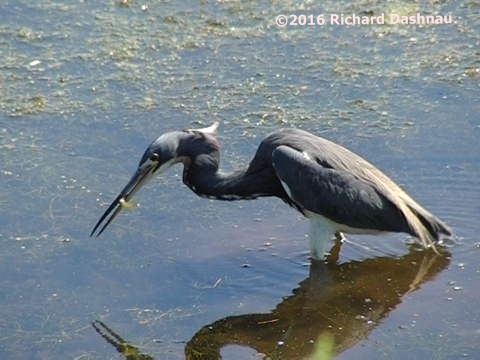 --
--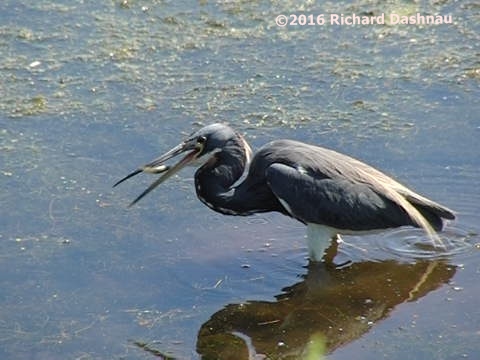 --
--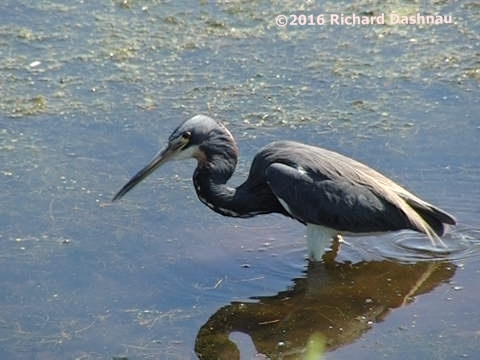
I've
read the term "inertial feeding" in some of the literature I've
reviewed. This refers to the use of the prey's inertia to reposition
it. That is, the predator's head (with the prey in its
mouth) is moved
forward, or up (or both); then the
mouth is opened and the prey is
briefly released. The inertia of the prey briefly keeps it stationary
in the
air. During this brief
moment, the predator moves its head
and grabs the prey from another (usually more favorable)
position. This is very easy to see in slow-motion
video.
5/07/2006
I've
already mentioned that I've seen a number of snakes being eaten by
birds
this spring. Here, a Little Blue Heron ( egretta caerulea
) has
caught a small snake. The snake appears to be a Gulf Crayfish
Snake
( regina rigida sinicola ). My copy of Texas Snakes
by Werler
and
Dixon (third printing) shows the snake on plate 118 and describes it on
pages 244-246. I going mostly with the color of the belly scales for
this
identification.
The snake is non-venomous. Even in pictures,
one
can see the difficulty the heron has with prey of this type.
Imagine
eating with chopsticks (some of you may do this regularly. I have.)
Consider
how difficult it can be to pick
up just one soft
noodle from a plate
using the chopsticks. Now, animate that noodle, and imagine that it can
bite, and might be venomous. Finally, imagine that the your eyes are on
one end of the chopsticks and that they
would therefore be at risk from
that animated, possibly venomous, noodle. You may now have some idea of
the complexity of the activity that this, and similar birds, have to
perform
time and again, for their entire lives.
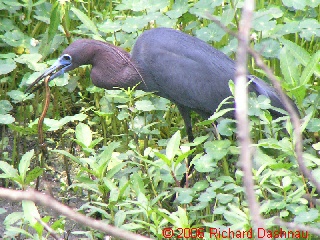 -
-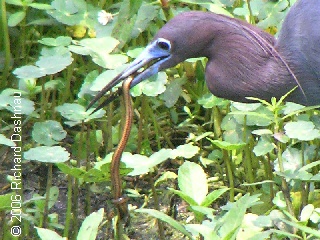 -
-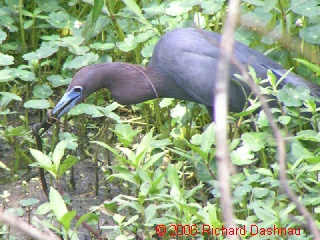 -
-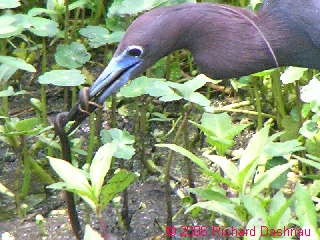 -
-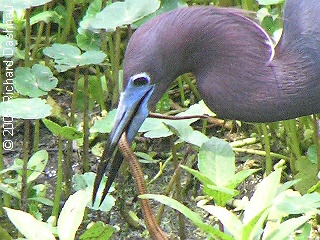 --
--
A SUCCESSFUL
HUNT
CLOSER LOOK AT THE MEAL
NOW,
WHAT?
A TANGLED
SITUATION
MAYBE THIS WAY
While
watching this kind of event, I wonder how much compression force the
bird
can generate with its beak. While the bird seems to be squeezing the
snake
(
sometimes
on its head) the snake, in most cases, seems to be moving vigorously
throughout
all this. It seems that most of the mortal damage is inflicted by
stabbing
motions of the beak as it is rammed into the prey as it is
dropped and
repositioned. In most cases I've seen the snake (or other prey) appears
to be still moving as it is swallowed. You can see a short video clip
of
the Little Blue Heron in action here
(wmv 1.5 mb).
This
happened on the North part of the 40-Acre Lake trail, on the North side
of the trail (in Pilant Lake), about midway between the Observation
Tower
and Hoot's Hollow. In these pictures, you can see how low the
water
level
is.
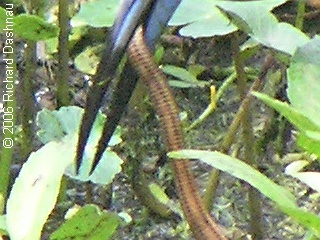 -
-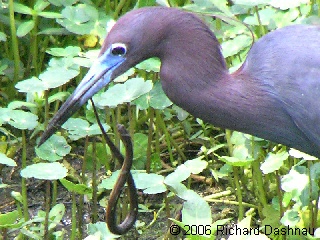 -
-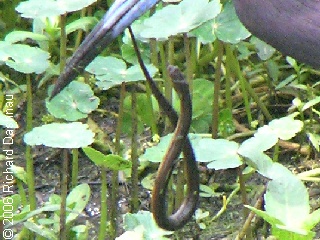 -
-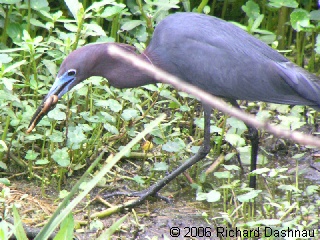 -
-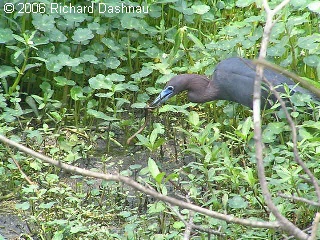 --
--
THE SNAKE'S BELLY
BY THE TIP OF THE TAIL
DORSAL
VIEW OF
THESNAKE
FINALLY GOT IT!
VIDEO
CLIP WMV 1.5MB
June
16, 2002 It's
time once again to see
our friend the Green Heron. As I promised, I tried to get some video of
a successful fishing trip. Here it is, with some more pictures. The
Rickubiscam
this week shows the heron
with its catch.
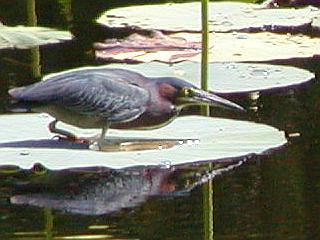 -
-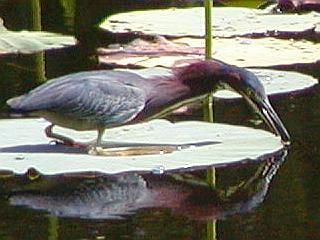 -
-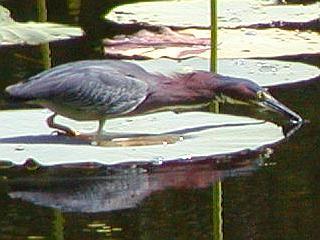 -
-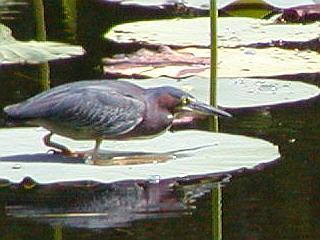 -
-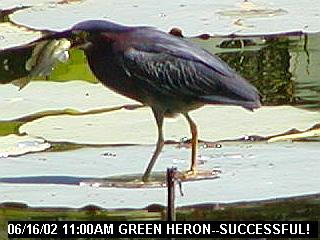
BAIT DRIFTS
IN
GENTLY GRAB THE BAIT
HERE' S
A GOOD SPOT
TIME TO
WAIT
GOT ONE!
As
I've shown before, there is a repetition of bait, watch the drift,
grab,
bait.... This time, however, there was a "stab" and a successful one.
Click
on the following links to view the clip. Heron Snags
It (wmv
video 6.1mb)
Heron Snags slow motion (I've slowed
this a bit with software) (wmv
video 8.0mb). Note--5/10/2012.
In the 10 years since I posted this, video editing and computers have
changed quite a bit. Internet access has as well.
Unfortunately, 10
years ago, I archived my digital videos in the best format
available to
me at the time, which was 352 x 240. I've been able to do some
post-editing and enlarge the video. So, now there are expanded
versions
of
the original video clips mentioned above. If you are visiting here
after 5/10/2012, you are seeing the better-quality versions of the
clips I filmed 6/16/2002. I'd really thought I'd shoot better video of
this behavior
in the years since then, and I hadn't been able to. Just
think--when I first posted these, almost everyone ONLY had dialup
connections available--and slow dialup at that. Video size was
critical. This is why I generated all these
tiny thumbnail images on
the pages--to make them load better over dialup.
May
18, 2002 Last
week I talked about the
Green Heron, and its habit of using live bait to catch fish. I wouldn't
be surprised if some visitors to this site found that story hard to
believe.
This week, I was able to see some Herons
doing it! (Not "it". Fishing
with
live bait. Jeez....) The image above, (GREEN HERON FISHING)
shows
a Green Heron in the act of placing its bait. This was a continuous
process.
As the bait would float or swim towards the lily
pad, the heron would
pick
it up and place it back in the water. Watch these two clips
if you'd
like to see this. Look very carefully at the speck the bird
is placing
in the water. It is a bug of some kind, but this all happened
about
20
yards away, and I had to use the video camera to bring it closer (which
is why the image jerks around. Sorry.). So, I couldn't tell
exactly
what it was. Clips one (wmv
video 9.4mb)
and two (wmv
video 2.9mb)
show a few
repetitions of the bait placement. Clips three (wmv
video 3.5mb) and
five (wmv
video 8.0mb) shows one more baiting, and
then lunges at food. However, the fish
got away. One of these days, I'll get a clip of a successful
stab
at a baited fish. When I do, it'll show up here.
Note--5/10/2012.
In the 10 years since I posted this, video editing and computers have
changed quite a bit. Internet access has as well. Unfortunately, 10
years ago, I archived my
digital videos in the best format
available to
me at the time, which was 352 x 240. I've been able to do some
post-editing and enlarge the video. So, now there are expanded versions
of
the original video clips mentioned above.
If you are visiting here
after 5/10/2012, you are seeing the better-quality versions of the
clips I filmed 5/18/2002.
May
12,
2002 I
watched a few of these Green
Herons (sometimes called Greenback Heron) feeding today. Sometimes, one
of these small birds will catch an insect, and drop it into the water.
Then, the heron will watch, and
when a fish comes up to investigate the
insect, the heron grabs the fish. While I saw a few Green Herons
fishing
today, I didn't see any of them using bait. I was able to get
a short
video clip of one of these herons spearfishing.
Click the
links to
download the flv
video file(246
kb) or an
mpg
file(1,304 kb).
While watching the clip, try not to blink, or you'll miss the long neck
extension as the spearing is done.
(GREEN
HERON HUNTING, below)
-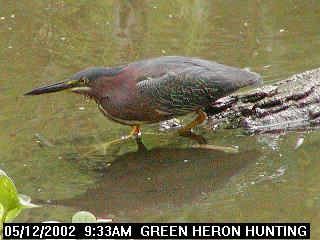 ----------------------------
----------------------------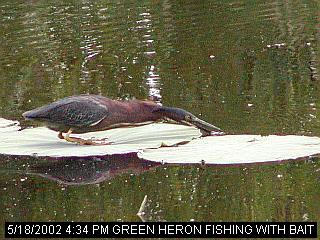 --------------------
--------------------
GREEN
HERON HUNTING--
--GREEN HERON FISHING
WITH BAIT
If
you'd like to know
more about the park
follow these links:
Brazos
Bend State Park
The main page.
Brazos
Bend State Park Volunteer's Page The
volunteer's main page.
Go back to my home page, Welcome
to rickubis.com
Go
back to the RICKUBISCAM
page.
Go
back to the See
the World
page.

















































































































































































 --
-- --
-- --
--
 --
-- --
-- --
--
 --
-- --
-- --
--
 --
-- --
-- --
--
















